William and Dinah Nutter's Surviving Children and their Families
William and Dinah (Ingham) Nutter had a total of fifteen children. Five of those children
(Olive, Moroni, Ingham, Lyone and Thomas) died in infancy or early childhood. Anything that is
known about their brief lives has been included in the text of the story of their parents.
The lives of the remaining ten children are going to be further detailed in the pages that follow
along with brief overviews of their spouse(s) and the families with those spouses. Among these
stories about William and Dinah's children, readers may find certain facts and stories repeated not
in an effort to fill pages, but so that each child's biographical entry can stand on its own.
At the end of each biography of William and Dinah's children are brief entries about each of
the grandchildren. These are not meant to be comprehensively biographical. However, it is hoped
these entries "place" each grandchild in time and place, record known (and hopefully, interesting)
anecdotal information plus data about the number of their descendants. While this sometimes
makes for tedious reading, it is included in an attempt to better connect the readers from these more
remote generations with the main subjects of this book.
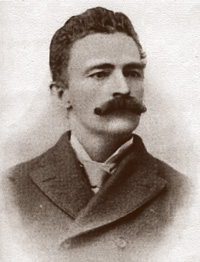
John Newton Nutter
As the eldest surviving child of his parents, John Nutter was well-positioned to remember most
of the odyssey of his parents across America, back to England and back across America.
John was born 6 March, 1856, during the Nutters' brief stay in "Gloucester City" (then Union
Township) in New Jersey. The family returned to Philadelphia soon afterwards and left for Utah in
April, 1860.
Though John had just turned four years old, certain events of the journey westward were
sharply carved into his memory; the cattle stampede that occurred on the wagon train, the morning
he was awakened to say good-bye to his little cousin who had died of whooping cough before her
burial along the trail. He recalled clearly how he was careful to be well-behaved on the journey
and how he dutifully walked westward with his family lest he suffer the fate of his little brother,
Will, who was "hog-tied" in the wagon for his own protection.
Of the time in Utah, John remembered little. It seems likely that John learned to read and write
at a Mormon school near Salt Lake City. Once the family relocated to Nebraska, he was likely
schooled at home. The events surrounding the Indian scare in late 1864, which drove the Nutters,
along with most settlers of eastern Nebraska, from their homesteads, was sharply etched into eight-
year-old John's memory. He recalled the family's time in England, meeting his grandmother and a
host of aunts, uncles and cousins for the first time. He attended at least a half term of school
there.
John grew into his early teens while the family lived in Philadelphia (1866-1869). His formal
education progressed there at the Old Bethany Presbyterian School. John assisted his mother
considerably in the daunting task of getting the six other children across the country by rail with all
of their belongings.
Once the family settled in the log cabin on the Wood River between present-day Gibbon and
Shelton, Nebraska, John sporadically attended school at the one room building that was previously
a railroad shanty throughout the early 1870s. It was sporadic not because his parents didn't value
higher education. Rather, his brawn was needed for farm work at home and he had long since
progressed well beyond the challenges offered in the one room schoolhouse situation.
As his father read voraciously, he followed a path directly behind his father often through the
same books. On those occasions when they worked together, John and his father enjoyed deeply
intellectual discussions. Not surprisingly, John's life philosophy very much mirrored his father's.
He developed as an atheist and was very interested in all of the natural sciences. Unlike his father,
he carefully tracked current events and politics for his entire life, assessing them from a liberal
Democratic point of view.
John grew into a very handsome young man sporting a full head of black, curly hair. He grew
a moustache which had a decidedly reddish tinge to it. He was average-to-tall in height and was
built like one would expect any young man to be built who had worked hard on a farm.
John leased a tract of school land in 1878 totaling 164 acres and began farming it in his own
right. Soon after, he bought the acreage and bought and swapped some additional land. The
eventual total of his land holdings came to nearly 600 acres.
In 1880, John met Anna Carlson, while serving as a deputy for Buffalo County Sheriff Simon
Seeley. Anna had been born 5 August, 1862 in Oskarshamn on Sweden's southeastern-most coast
to Carl and Marta Catherina
(Nilsdotter) Carlson. Her parents had come to Varna, Illinois with the
family in 1870 and then to Phelps County, Nebraska in 1879. Because she had begun her
education in Sweden and finished in Illinois, Anna was as comfortable with the Swedish language
as she was with English. Some of her correspondence with "My Own Darling John" Nutter still
survives. In it, she articulates her affection very well and reveals some profound, typically
Scandinavian, melancholy over her father's dislike for the "godless" John Nutter.
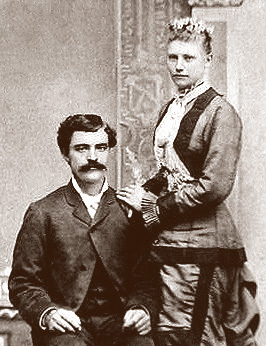
John and Anna Nutter
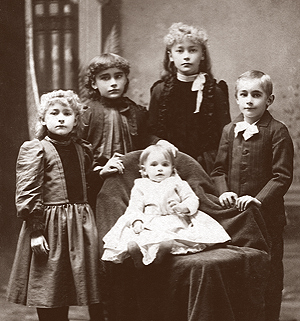
Children of John and Anna Nutter. From the left: Elsa, Effie, Olive, Herbert, with Beatrice in the chair.
Nevertheless, John and Anna were married on 2 May 1881 while John was serving as a deputy under Buffalo
County Sheriff Simon Seeley. Their wedding occurred in Kearney at the home of Sheriff Seeley
and his wife Ida who was Anna's sister and likely the person who introduced John to Anna. She and
John settled on his homestead in Platte Township, away from the "Fort Farm Island" holding for the first two years. John then
moved into a small farmhouse on the Fort Farm Island farm and set up his wife and growing family
in a larger home on a farm between Shelton and Gibbon; the "home" farm. This arrangement
appears to have given Anna some pause about the likely long term success of their marriage.
However, in the first six years of their marriage, John and Anna became the parents of four
children. After the birth of the fourth child, Anna was unsuccessful in carrying some number of
pregnancies to full term. A fifth child was born in 1891.
As might be expected, John's living arrangement (separate from his wife and family), Anna's
frequent pregnancies, John's growing enjoyment of alcohol and, at the very least, the rumors of his
infidelity took its toll on the young marriage. Her daughters would later say that, had Anna lived,
she would have likely divorced John. However, that was not to be.
John Nutter was elected Buffalo County Sheriff in 1892. He, Anna and the children moved into the
home in Kearney previously occupied by Anna's sister Ida and her husband, Simon Seeley, (the outgoing
sheriff). Anna then discovered she was pregnant once more. Some have said she attempted to
terminate the pregnancy; others claim she simply miscarried. Whatever the case, she developed
blood poisoning and died suddenly 23 March, 1893.
John Nutter was devastated. Despite his inclination to live life on his own terms, Anna was, no
doubt, the love of his life. His mother, Dinah, and his newly-wed sister, Jennie Nutter Hogg,
stepped into the breach and assumed the care of the five young children.
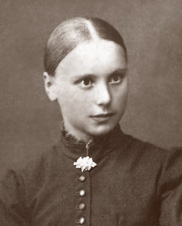
Jennie Reinholdson Nutter as a young girl in Sweden
In the Summer of 1893, John met Jennie Reinholdson, a 22-year-old visitor from Sweden.
Jennie had been born 27 March, 1871 in Ost Furtan, Brunskog, Varmland, Sweden to Britta
Jansson, a teacher in the village who died a few days after Jennie's birth. Jennie's father, Olaf
Reinholdson, allowed Britta's mother to assimilate Jennie into her own family and Jennie was raised
with an uncle who was close to her own age. Jennie had come to Nebraska to visit that uncle where
she met John Nutter. After John proposed marriage, Jennie abandoned her plans to return to her
native country.
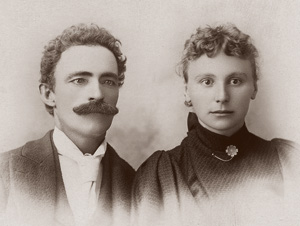
John and Jenny Nutter
On Christmas Day, 1893, John Nutter and Jennie Reinholdson were married. Considering
Jennie had nothing but a rudimentary understanding of the English language at that point, it is hard
to know for sure if she realized the enormity of the task she faced. Marriage to John Nutter under
the best of circumstances was bound to be hard work. He continued to insist on separate
residences. However, there were his five children with Anna to raise. Plus, they would have
children of their own as well; three girls in the first five years, a son five years later, another son
nine years later, then a daughter three years later as Jennie neared her forty-fourth birthday.
John Nutter served a second term as Buffalo County Sheriff and then returned to Fort Farm
Island in 1896. Jennie moved into the other farm east of Gibbon with the children. There, she
"executed her task" with such grace, strength and stoicism that she earned the enduring love and
respect of all who knew her, particularly her stepchildren.
Jennie's mettle was sorely tested at the end of 1903 when she gave birth to her first son, Harold.
Already at home were three daughters under ten, two teenaged step-daughters and a teenaged step-
son, plus another step-daughter in her early twenties. Someone suggested that if the step-son,
Herbert, were to move westward with his Aunt Jennie Nutter Hogg, her husband Will and their two
sons, it would ease the growing chaos at home, free up a bedroom, and perhaps, offer Herbert a
unique opportunity to prosper. All of the concerned parties agreed and Herb went to Oregon.
A few years later, in 1906, John’s mother Dinah was widowed. She was intent, after years of
being unable to travel because of her husband's illness, to go to the northwest and visit her three
daughters and numerous grandchildren who lived there. Fully aware that John’s wife Jennie was
still very overburdened by her family responsibilities and that John was of no significant help, she
proposed that the remaining daughters of John's "first family" still at home, Olive, Elsa and
Beatrice, accompany her on the trip west. And so they did.
John Nutter continued to live separately from his wife and family. His drinking continued and,
it is believed he fathered at least one other daughter with a local woman during this period. Still, he
built up substantial wealth over the next decade through hard work and his sharp business acumen.
His lifelong thirst for knowledge was seemingly never quenched. He was well-respected in the
community as an extraordinarily ethical businessman.
As a boy, John's chores included procurement of wood for fuel. He was therefore acutely
aware that the Wood River Valley area lacked mature trees. As a result, he made it a life-long
priority to plant literally hundreds of trees, perhaps thousands, on his properties. John was also a
great story-teller, always at the ready to tell tales to anyone who would listen of his family's early
adventures during his formative years.
John and Jennie had another son, Donald, in 1912, then their last child, a daughter, Jean, three
years later when he was nearly 59, she nearly 44. In that same year, 1915, John retired from active
farming allowing tenants to farm the Fort Island acreage.
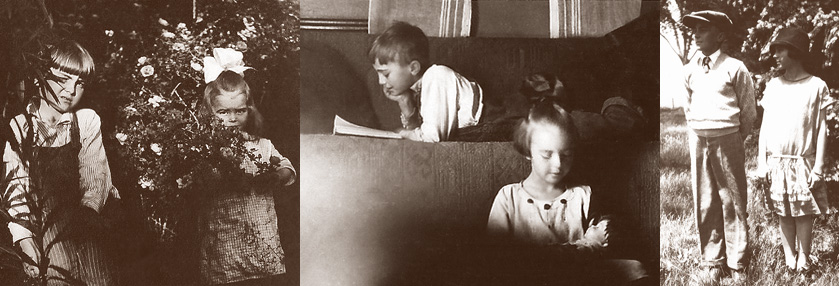
Don and Jean Nutter - Youngest children of John and Jenny Nutter
 Left
Left: Inez, Hilda "Stub", and Marge Nutter;
Center: Jenny and Jean;
Right:
Olive Nutter and her half-brother Don (Don stayed with Olive and Charlie for several months)
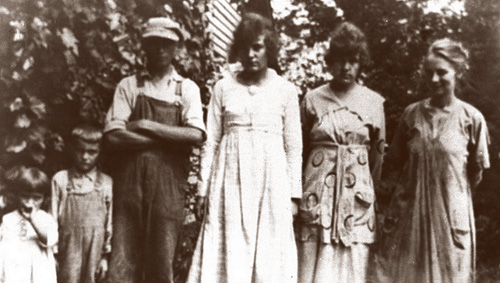
Jean, Don, Harold, Marge, Hilda, and Inez Nutter
In 1920, John asked his son Herbert to return from Oregon and farm the Fort Farm Island
acreage. It seems he then moved into the house at the home farm where his wife and children
lived. None of this went well. Herbert soon returned to Oregon with his wife and daughter. John
returned to his solitary existence in the house at Fort Farm Island. In an odd example of John's
code of ethics, John quit drinking alcohol that same year as the eighteenth amendment and the
recently-passed Volstead Act would have made him an outlaw had he continued to imbibe.
As the years passed, most of John and Jennie's family married and/or moved away until just the
youngest two, Donald and Jean were at home with Jennie. Son Herbert passed away in 1931 in
Oregon. Donald gradually began taking over the farm on which John lived. John's health began to
fail in the 1930s as he suffered a series of strokes. One morning late in the Fall of 1935, Donald
discovered John in his chair, paralyzed by yet another stroke. He took him back to the "home farm"
where he died a few weeks later on 10 December.
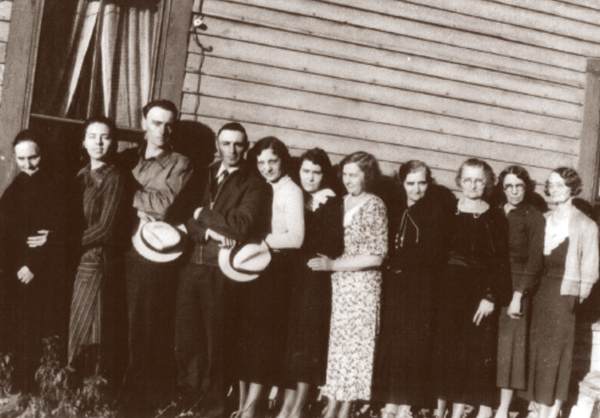
John Nutter's widow (Jennie) and his ten living children, in ascending age, together for the
first time on the occasion of John Nutter's funeral in December, 1935. Left to right; John's
widow, Jennie; Jean Nutter, Don Nutter, Harold Nutter, Marjorie Nutter, Hilda Layman, Inez
Reynolds, Beatrice Hogg, Elsa Evans, Effie Graham and Olive Holmes.
A week later, all ten of John Nutter's living children attended his funeral. Five of his "out-of-
state" daughters came to Nebraska and some actually met a few of their siblings for the first time
ever. Despite the miles that would remain between them, each made an effort to maintain contact
with and visit the others for the rest of their lives.
Of course, all this delighted Jennie. She maintained a cordial and loving relationship with her
children and step-children, and reveled in the grandchildren and great-grandchildren that came
along. After John's death, Jennie’s youngest children, Donald and Jean, spent the horrendously hot
summer of 1936 refurbishing the home on Fort Farm Island and moved Jennie into the house
where her husband had spent so many solitary years. Donald and his mother lived there for
another 35 years.
Though Jennie had lost contact with her family in Sweden many years before, her daughter
Jean re-established contact in 1965 through her genealogical research efforts. Jennie's father, who
had stepped out of her life just days after she was born, was found to have married and raised a
family in northern Sweden. In 1969, when Jennie was ninety-eight, she finally met her sixty-four
year old "kid brother", Thorvald Reinholdson, who traveled from Sweden to meet her and her
family.
Jennie died in November, 1970, five months short of her one hundredth birthday.
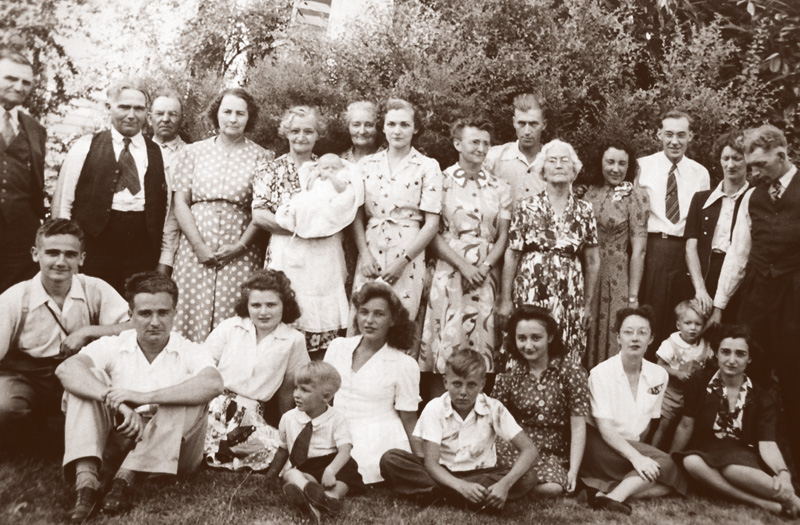 Reunion of west coast children of John Nutter and their families
Reunion of west coast children of John Nutter and their families
Standing: John Hogg and his wife Beatrice (Nutter) Hogg are
2nd and 5th from the left. Their daughter Betty (Hogg) Nims is 7th from the left. Beatrice is
holding her first grandchild, Betty's daughter Linda. Standing at the left is R.W. "Will" Hogg, older
brother of John Hogg. 8th from the left is his daughter Margaret. 3rd and 6th from the left are
Johnny Evans and his wife Elsa (Nutter) Evans, Beatrice's older sister. 4th from the left is Inez (Nutter)
Reynolds, also a sister of Beatrice. Inez's son Bob Reynolds is 6th from the right. 5th from the
right is Beatrice's Aunt Jennie (Nutter) Hogg, wife of Will Hogg. 3rd and 4th from the right
are Olive (daughter of Johnny and Elsa Evans) and her husband Thorvald Jorgenson, followed
by Evelyn and John Evans, Jr. (far right) with their son Richard down in front of them.
Seated in front: From the left, Spence (1st), Ladd (2nd), Nancy (3rd), Billie (7th),
and Jean (last on the right) are the children of John and Beatrice Hogg. Only their son Dick is
missing. 6th from the left is Inez's youngest son, Dick. Seated to the left of Jean in the
picture is Edna Elizabeth (Nutter) Pearson, sometimes referred to as Betty, and sometimes
as Steve (reason unknown). The other woman seated in front of Betty Nims is Ramona "Mona"
Evans, youngest daughter of John and Elsa Evans. The young boy seated in front of her is John Evans
(son of the aforementioned John and Evelyn Evans). To the right of Mona is Dick Reynolds, son of Inez.
The Children of John Nutter and Anna Carlson
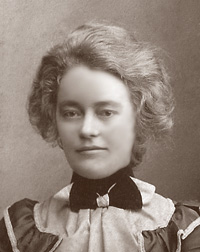
Olive Nutter
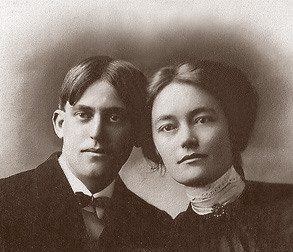
Charles and Olive (Nutter) Holmes
Olive Kathryn Nutter (1882-1955) - taught school for a few years in Buffalo County
and was boarding with her aunt, Louise Nutter Miller at Ravenna in 1900. In 1906, she went west
with her sisters and their grandmother. Olive, however, went no further than Denver, Colorado, as
a romance had bloomed for her as she passed through that area. She married Charles Holmes
(1878-1949) early in 1907 and the marriage, in the long run, was less-than-happy and childless.
"Ollie" and Charles made their home in Englewood, Colorado where they lived quite separate lives.
Charles spent the entire marriage socializing with a rather unsavory crowd. Olive joined social
clubs and earned the love and respect of many in her community. She died of a heart attack in
1955.

Taken in Denver, Colorado, likely in February, 1907, around the time of Olive Nutter's marriage
to Charles Holmes. Reuben Miller and Louise (Nutter) Miller flank the "passengers" in the car.
Their children, Gerald and Ruby are at the front. Olive (Nutter) Holmes is in the next row with
her grandmother, Dinah (Ingham) Nutter. Charles Holmes is at the back-center.
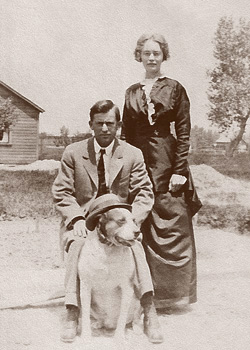
Charles and Olive (Nutter) Holmes in their backyard.
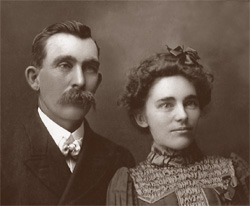
John and Effie (Nutter) Graham
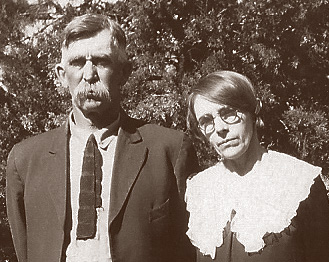
John and Effie (Nutter) Graham
Effie Diana Nutter (1883-1978) - was named "Euseffa Irvine" at birth, but her name
was changed very early on in her life. In 1903, she married John Edward Graham (1871-1966), a
local farmer, with whom she had two daughters. When the younger daughter, Georgia Beatrice
(1908-1925), died suddenly of a throat infection during her senior year in high school, Effie was
plunged into mourning and a profound depression which lasted for years. John retired from
farming in 1929 and moved with Effie and their surviving daughter, Amy, to a small home in
Gibbon where John died after being retired for thirty-seven years at the age of 95. Effie died
thirteen years later, also at the age of 95. Daughter Amy Renetta (1903-1999) moved to Denver,
Colorado and had wed Max Lowdermilk (1910-1966) in 1935 who built a large retail bakery chain
and, unfortunately, lost the same. She and Max had no children. Amy and her mother were both
widowed within a few months of each other in 1966. Coincidentally, like each of her parents,
Amy died at the age of 95.

(from left) Amy & Georgia Graham; Georgia & Amy Graham (1908); Amy Graham (1927); Georgia Graham
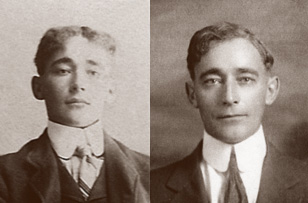
Herbert Nutter
Herbert Spencer Nutter (1885-1931) - was named for a great nineteenth century
English philosopher whom his father admired. He moved to Oregon with his aunt, uncle and
cousins in 1904 and worked his way up in the Wells Fargo Company in Portland. In 1911, he
married in Salem to Edna Eugena Bacon (1890-1969), a native Oregonian, with whom he had a
daughter. The marriage supposedly suffered, in part, because of Herb's avocation as a musician.
An accomplished clarinetist, he socialized with other musicians and was subject to the temptations
of the "underground culture" associated with musicians in that era. In a venture bound for failure,
Herb returned to the simple life of a Nebraska farm with his wife and daughter in 1920. In 1921,
he returned to Portland, Oregon and the employ of the Northern Pacific Railway Company where
he worked until his death in 1931 from Bright's Disease. He and Edna had divorced three years
earlier after which she married two more times. Herb's only daughter, Edna Elizabeth “Betty"
(1912-1973), married Walter Malvern Pearson and had an only son, Terry Spencer Pearson (born
1945). He has six children and at least five grandchildren.
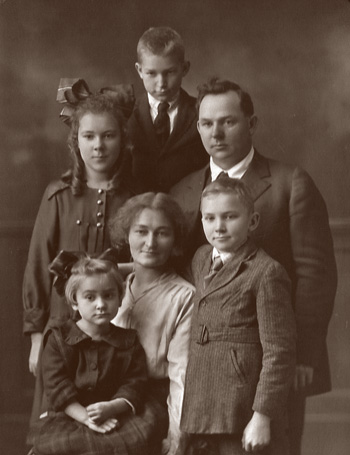
John and Elsa (Nutter) Evans family: Olive (top left), John Jr. (top center), Howard (bottom
right) and Rosalie (seated on her mothers lap)
Elsa Theodora Nutter (1887-1990) - moved to Salem, Oregon, when she was 19
years old. She began working in a prune packing plant where she met John William Evans (1878-
1961) whom she married shortly afterwards in 1907. The couple moved south to Coos County for
six years where they had a dairy farm and where their first three children were born. They returned
to farm near Salem where their last two children were born. After her husband died, Elsa continued
to live on her own during her eighties (during which time she laughingly referred to herself as an
"octa-geranium") and well through her nineties. Sadly, she survived all five of her children and
three of their spouses. Additionally, macular degeneration robbed her of most of her eyesight. She
died in a nursing home, still spry and alert, just 5 days short of her 103rd birthday, survived by 10
grandchildren, 17 great-grandchildren and several great-great grandchildren.
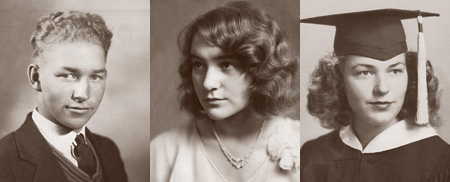
Three youngest children of John and Elsa (Nutter) Evans: John Jr. (left), Rosalie (center),
Ramona (right)
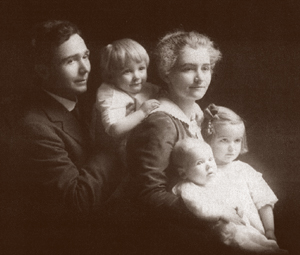
John and Beatrice Hogg and their three eldest children: From left, John "Lad", Jean, and Richard "Dick".
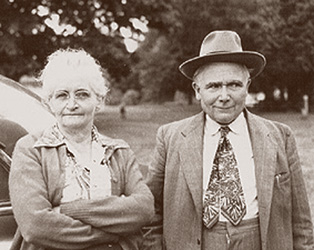
John and Beatrice Hogg
Frances Beatrice Nutter (1891-1984)
- was always known as “Bea" or "bea-AT-ris".
She moved to Salem with her sister Elsa and graduated from high school there. After teaching
school for two years, she married in 1912 to John Alexander Hogg (1882-1964), a fellow
Nebraskan, who was a younger brother of her uncle (by marriage) Will Hogg and aunt (by
marriage) Lizzie Hogg Nutter. They had 3 sons and 4 daughters, all born in Vancouver,
Washington, where John was the proprietor of a book and stationery store. The family did very
well and John entered into local politics serving as city treasurer and mayor. In the 1940s, he made
an unsuccessful run for the U.S. Senate. However, John and Beatrice drifted apart late in life
and John moved into a room in the basement of their Vancouver house on Franklin Street. The bookshelves
lining nearly every wall spoke to John's continued passion for reading and self-learning. He died
peacefully in 1963 at age 81. Beatrice returned to school after World War II and became a licensed
practical nurse. She worked at Vancouver Memorial Hospital in that capacity for 13 years, finally
retiring at age 73. Beatrice remained active and very healthy as she passed her ninety-third birthday
in November, 1984 but died on the following Christmas Eve as a result of injuries suffered in an
auto accident. Her seven children were all college educated, employed variously in teaching, engineering
(chemical and electrical), pharmacology, etc. Most of the 24 grandchildren are similarly well-educated.
Nearly all live in the west and southwest.
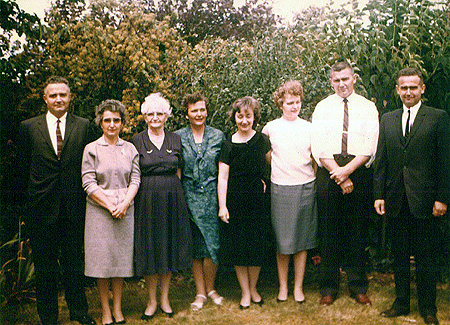
Beatrice Hogg and children (photo taken in 1963 at the time of John Hogg's funeral): (from left) Lad,
Jean, Beatrice, Betty, Billie, Nancy, Dick, Spence
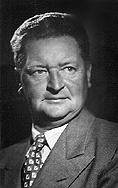
Bill Jansen |
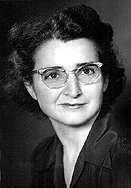
Jean (Hogg) Jansen |
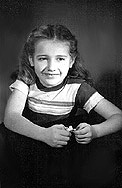
Nancy Ann Jansen |
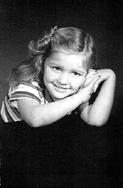
Diana Jansen |
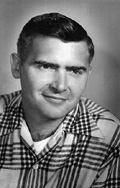
Richard "Dick" Hogg |
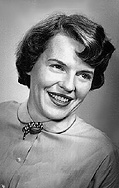
Bettye "Self" Hogg |
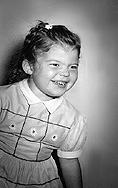
Maureen Hogg |
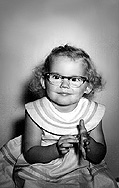
Joanne Hogg |
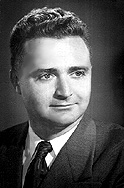
John E. "Lad" Hogg |
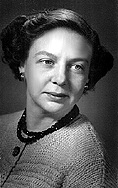
Pauline "Pollee" (Sandel) Hogg |
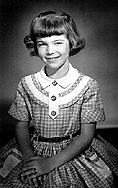
Patsy Hogg |
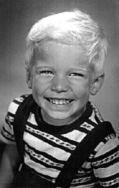
Jeffrey P. "Jeff" Hogg |
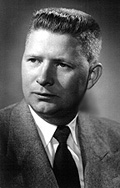
Frank Leslie Nims |
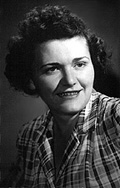
Betty Miles (Hogg) Nims |
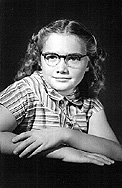
Linda Jean Nims |
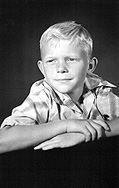
David John "Dave" Nims |
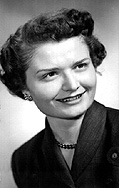
Nancy (Hogg) Perry |
| |
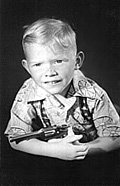
Daniel Fred "Danny" Nims |
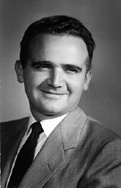
Robert Spencer "Spence" Hogg |
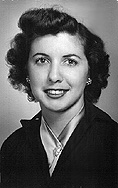
Margaret (Aja) Hogg |
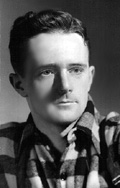
Frederick L. "Freddie" Meissner |
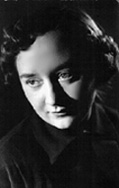
Marilyn Frances "Billie" (Hogg) Meissner |
Pictures of the John A. & Beatrice (Nutter) Hogg children and grandchildren taken by Freddie
Meissner, who was a photographer by trade. (circa 1954 - before Nancy was married to Thorton
Perry, and before the youngest grandchildren were born.)
The Children of John Nutter and Jennie Reinholdson
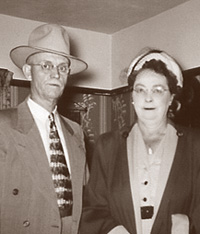
Maynard Everette Reynolds, called "M.E.", shown at his home in Corvallis, with his high
school sweetheart and life-long wife, Inez
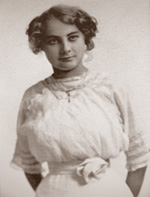
Graduation photo of Inez Virginia Nutter
Inez Virginia Nutter (1894-1968) -
was, at first, given the Swedish name Ina Signe
by her Swedish mother. After graduation from high school, she married Maynard Everette "Everette"
Reynolds (1895-1994) and moved to Red Elm and then, Dupree, both in South Dakota. During
most of their thirty years there, they farmed and Inez taught school. However, at various times,
Everette also sold real estate, published a newspaper, ran a restaurant and a grocery outlet, worked
as a milkman and served as the County Register of Deeds and auditor. In June, 1942, the couple
moved to Corvallis, Oregon where they lived the rest of their lives. In retirement, they travelled
often to visit family. A car accident on one of these visits precipitated Inez' death from an
embolism while in a Decatur, Illinois hospital. Everette survived her by nearly a quarter century,
dying two months after his ninety-ninth birthday. Their eldest son, Robert (1915-2006) moved to
Portland, Oregon in 1936. He learned carpentry then in Corvallis, Oregon and eventually became a
contractor. His parents joined him there with his younger brother in 1942. Except for a stint in the
Sea-Bees during World War II and a year in Alaska, he lived in Oregon until 1952 when he moved
to Yerington, Nevada. He had two children and 3 grandchildren. Everette and Inez' only daughter,
Janice (1918-1966) married in 1938 to Clyde Baker (1912-1985) who was pursuing a career in the
military. The couple was stationed in Alaska for many years and their two daughters plus one of
their two sons were born there. They were also stationed in Ankara, Turkey for a while. After the
family moved to El Paso, Texas, Janice was diagnosed with multiple sclerosis. Her health
deteriorated and her marriage and family life were very strained by her decline. Janice died in
1966. Some of her descendants now live in Milwaukee, Wisconsin, and a few live in Texas,
Arizona and California. Everette and Inez' younger son, Richard Everette Reynolds (1930- ) had
three sons with his first wife and a daughter with his second wife. He continues to live in Corvallis,
Oregon with his third wife.
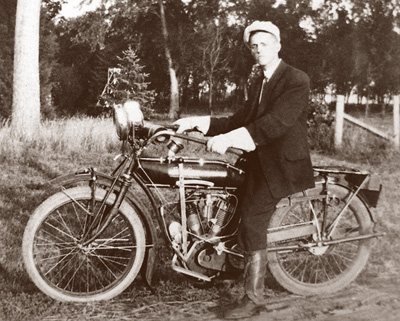
Everette Reynolds
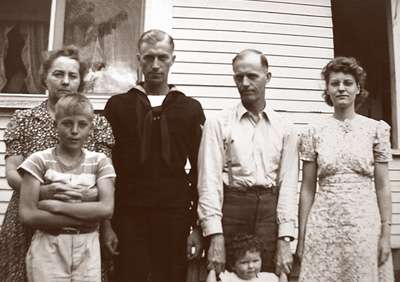
Everette and Inez Reynolds family. From the left, Inez holding her youngest child, son Dick Reynolds;
son Bob Reynolds; Everette Reynolds, holding onto his granddaughter Patricia Anita Baker; daughter Janice
(Reynolds) Baker, wife of Clyde Baker and mother of Patricia.
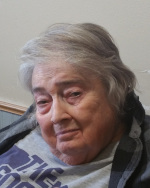
Nancy Sue Polan
(Carolyn Anne Layman)
Hilda Marguerite Nutter (1896-1985) - used the name Margaret legally throughout
her whole adult life, but her family always simply called her "Stub" - a nickname surrounded by
much folklore as to its origins. The favorite explanation seems to be that it referred to her well-
known stubbornness. After teaching school in Shelton for a few years, she married in 1920 to
Charles Hooker Layman (1894-1942), a veteran of World War I and a Seventh Day Adventist.
Charles worked in the building trades for years in the area of their home at Grand Island, Nebraska
and died after a fall from scaffolding at work. Stub lived a meager existence for the balance of her
life in Grand Island. Elder son Charles (1921-2006) lived near Washington, DC and had three
children from two marriages. The younger Layman children were twins born in 1925; Keith was in
the navy during World War II and moved first to Pendleton, Oregon, then to Southern California
where he died in 1983. He had one son from his first marriage, three children from his third
marriage. His twin sister Carolyn, had two daughters, Carolyn Anne and Anita Sue. Though they
never married, Carolyn's father was George Julius Morgan. Anita's father's last name may have been
'Heller' or 'Keller'. Carolyn Ann was given up for adoption, and her adopted name is Nancy Sue Illsley.
She married Darrell Polan, Sr. She now lives in in Omaha Nebraska.
[Thanks to Zachary Christensen, loving grandson of Nancy Sue (Layman) Polan, for the updated information and the picture.]
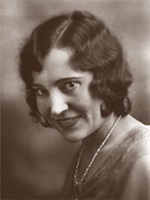
Marjorie Nutter
Marjorie Isabel Nutter (1898-1990) -
taught school after graduation and then, in
1921, began working for Northwestern Bell Telephone Company in Omaha, Nebraska and
completed her studies at a business college there. During the 1920s, she met a wayward Danish
Count with whom she fell in love. However, the Count mysteriously disappeared while on a
motorcycle tour of the west coast. It seems likely he perished in an accident along one of the
coastal roads. Some family members believe that this tragedy had much to do with the fact that
Marjorie remained unmarried for the rest of her life. In 1928, she moved to Minneapolis,
Minnesota, where her employer's headquarters was located. She retired in 1963 from the telephone
company and began work for the Minnesota Institute of Arts. Even after a second retirement, she
served as a volunteer for the Institute and for the Minnesota Symphony Orchestra. She also did
volunteer work for 35 years at the local Methodist hospital and she had served during World War II
as a Red Cross nurse. After suffering a stroke in 1984, she moved to a nursing care facility in
Boulder, Colorado to be near family. She died six years later.
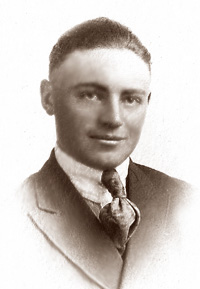
Harold Nutter
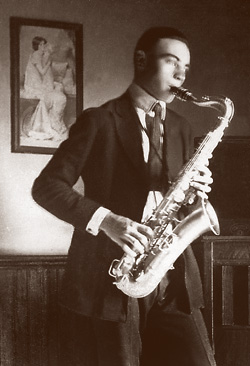
Harold Nutter on the sax
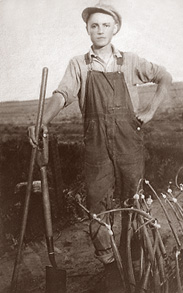
Harold enjoyed gardening
Harold Kenneth Nutter (1903-1999) - who was originally named Harold Sydney
Nutter, occupied a unique, almost solitary position amidst his many siblings and half siblings. By
the time he was three, his five elder half-siblings had either married and/or moved away. His next
sibling wasn't born until almost nine years later, affording him an "only child" status for some time.
He became an accomplished musician, adept with the saxophone, clarinet and violin. After
graduation from Gibbon High School, he married Josephine Scott (1906-1972) in 1923 and soon
thereafter, like his father, decided to buy his own acreage to farm in his own right. He farmed the
land northeast of Gibbon until his retirement in 1970 and also worked as a regular and substitute
mail carrier in the area from 1950 to 1972. Harold enjoyed nearly 30 years of retirement and lived
on his own amidst his family near Gibbon until shortly before his death in 1999 at the age of 95.
Harold and Josephine had a daughter, Genevieve (born 1925) who trained as a nurse in Lincoln,
Nebraska after marrying Gordon Robb. She has three daughters and four grandchildren. Harold
and Josephine also had two sons. Richard Harold Nutter (1929-1996) had three daughters with his
wife, Grace Osler, from whom they had their five grandchildren. He farmed and, like his father,
served as a substitute mail carrier until taking the job full-time. John Ronald Nutter (born 1933)
married in 1951 to Ruby Loewenstein and had 2 sons born during the time they lived in Kansas.
They eventually returned to the area near Gibbon, Nebraska and have 5 grandchildren and several
great-grandchildren in the area.
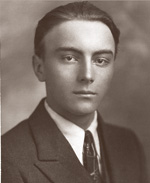
Don Nutter - High school graduation
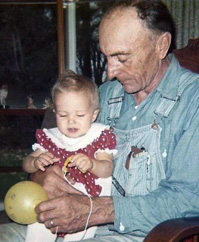
Don Nutter and daughter Lori
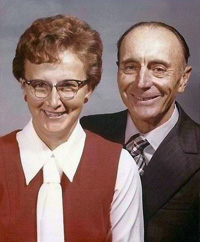
Don and Margaret Nutter
Donald Oakley Nutter (1912-1980) - was given his unique middle name for no other
reason than it facilitated his initials spelling his nickname. He graduated from Gibbon High School
like his siblings and began working his father's Fort Farm Island land while in his teens. As his
older half-brother (Herbert) had opted out of farm work and returned to Oregon and because his
full brother Harold had purchased his own land, Don's father eventually turned over all of his
acreage to Don. There was also an understanding that Don would take care of his mother for the
rest of his life - a duty Don gladly and lovingly undertook. Two months after his mother's death, as
he approached his fifty-ninth birthday, he married Margaret Estella Mohn Bennett (born 1933) who
had recently come out of a failed marriage. With Margaret came a ready-made family of four sons.
Also, Don and Margaret had a child together in 1972 as he approached his sixty-first birthday. Lori
Lynn Nutter would know her father just a short time though as Don died of an apparent heart attack
eight years later. Lori married in 1991 to Heath Gregor.
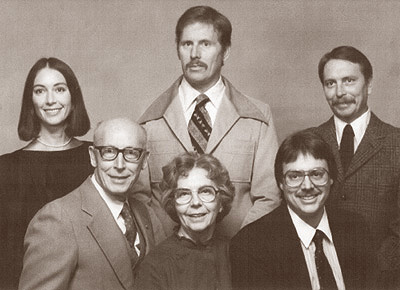
Family of Yale and Jean Nelson (center). Clockwise around Jean are her husband, Yale Nelson;
daughter Marilyn "Lyn" Nelson, Robert Nelson, Steven Nelson and Thomas Nelson.
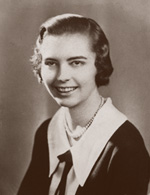
Jean Nutter - Hastings College (1935)
Jean Helen Nutter (1915-2003) -
was the last child of her parents, born when her
father was fifty-nine and her mother was forty-four. She graduated from Gibbon High School and
attended Hastings College in Hastings, Nebraska. After graduation in 1939, she was a social worker
in Hastings but eventually moved to Denver, Colorado. There she was married fellow Nebraskan
Yale Roy Nelson (born 1918) in 1942. The two had met while at college in Hastings. Jean and
Yale moved several times in their marriage as Yale worked as a pilot for United Airlines (three of
their children were born during two different tenures in Chicago, Illinois - the other child was born
during their time in Seattle, Washington). Eventually, they returned to the Denver area where Yale
spent the latter part of his career at the United Airlines Training Center as an instructor. As she
raised her family, Jean pursued the rather daunting task of maintaining regular, loving contact with
her "immediate" family along the west coast and in Colorado and Nebraska, some of which was
facilitated by her access to United Airline passes. As her interest in family history burgeoned in the
1960s, she expanded this interest in family to Sweden, England, and to more of the USA. She was
an avid and tireless researcher and is responsible for collecting the major portion of the information
found in this book. All of Jean and Yale Nelsons' children live in the greater Denver area. Son
Robert Yale Nelson (born 1945) is retired from the telecommunications industry as is his wife. He
has a son and daughter by two previous marriages. Son Steven Arthur Nelson (born 1947) is self-
employed and is married, has a step-daughter and grandchildren. Son Thomas Cavett Nelson (born
1952) is married, has a son and daughter and is a successful businessman in the field of medical
care. Only daughter Marilyn Jean Nelson (born 1955) is married and has a daughter. Both she and
her husband John Heins perform, compose and teach music.
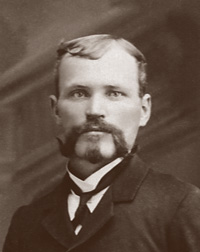
William Hingham Nutter
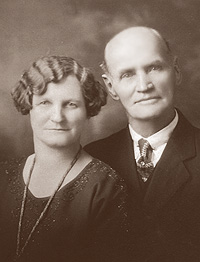
William and Laura Nutter
William and Dinah (Ingham) Nutter's second surviving son was born on 9 June, 1859 in
Philadelphia, Pennsylvania. His identical twin, Hingham William Nutter died soon after birth.
Throughout his life, he always used the name William H. Nutter. However, the initial "H" was
derived from an incorrect rendering of his mother's family name of Ingham. (Speakers of the
Lancashire dialect in Northern England drop the initial "H" in most words and often insert an "H”
when a word begins with a vowel).
"Will", as his family called him, was a few days short of his first birthday when his parents --
after traveling by rail and water from Philadelphia to Florence, Nebraska --began the journey by
wagon train to Salt Lake City, Utah. In later years, Will would relate that he was "hog-tied" into the
wagon by his parents who feared he could fall out undetected. Will contracted whooping cough like
so many other children on the way. Fortunately, he survived, unlike so many others.
Naturally, Will had no recollection of his family's time in Utah (1860-1862). He had no
substantial memories of their retreat to, and their first time living in, Nebraska. His memories
became somewhat clearer of his family's return to England in 1865 when he was six years old. He
remembered some of his many cousins near to his age. He clearly recalled the time in Philadelphia
after his parents returned to the USA. He began attending Old Bethany Presbyterian School there
and was edified by the responsibility he shared with his elder brother, John, as they watched over
their younger sisters on the long journey by train back to Nebraska in the summer of 1869.
Will began attending school in an abandoned railroad workers' shack near Wood River Junction
(now Shelton), Nebraska. He had easily mastered reading and printing early on, but curiously, he
was a teenager before he became proficient in cursive writing. Like his father and his elder brother
John, he was a voracious reader and a life-long atheist with a strict moral code. It was not unusual
for the three of them to be engaged in long theoretical, philosophical and scientific discourse at
home or while at work on the farm.
Unlike his brother John, Will had no particular affection for alcohol and was the "dutiful" son -
- his father's faithful right-hand man on the farm with seemingly no particular interest in striking out
on his own. He honed his carpentry skills during the building of his family's octagonal house,
presumably guided by the anonymous finish carpenter who lived with the family in 1887 while the
house was being built. Once the carpenter moved on, Will had his own bedroom. That one room
he had to himself was comparable in size to the entire log cabin in which all of his family had lived
in for the previous twenty years. A few years later, in the spring of 1890, thirty-one-year-old Will
Nutter met a beautiful and petite sixteen-year-old girl, Laura Myrtle Comstock, at a dance in
Gibbon.
Laura Myrtle Comstock had been born in Lisbon, Illinois on 22 February, 1874, the second
child and eldest daughter of (George) Elmer Comstock and his wife, Evalina Rosaltha (Eastman)
Comstock. The parents and nine children moved to Sturgeon Bay, Wisconsin in 1888 where
Laura’s mother and little sister, Cora, died. The remaining family then moved to Gibbon, Nebraska
in March, 1890. Originally, Elmer Comstock (1843-1915) was from Clinton, New York. His
grandfather had come to that area of New York from Rhode Island where his ancestors had lived
for two centuries since coming from England. His marriage to Evalina Rosaltha Eastman (1846-
1889) was not particularly well-received because Evalina’s father, Peter Eastman had married
Abigail Smith, a "Negro woman" who became mother of his children. Laura Comstock was well
aware of her mixed heritage and cherished it because it came to her through her much-beloved
mother. However, she was also discreet about it when she felt she needed to be.
Will Nutter and Laura Comstock were married at her father's home in Gibbon on Thanksgiving
Day, 1891 (November 26). Fifteen months later, she gave birth to their first child. Over the next
twenty years, a dozen more children came along.
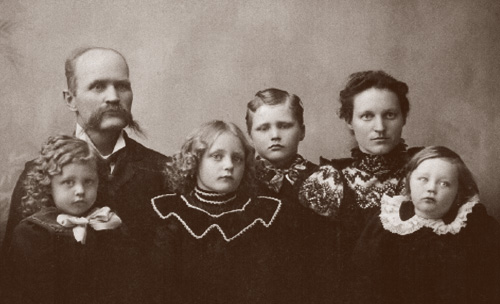
Family picture of William and Laura Nutter. (Left to right) Perry Nutter; his father, William Nutter;
Pearl Nutter; Orville Nutter; their mother, Laura Nutter; Wellington Nutter
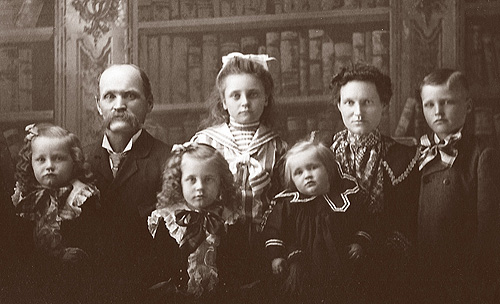
Family picture of William and Laura Nutter about 1902. (Left to right) Wellington Nutter;
William Nutter (the father), Perry Nutter; Pearl Nutter; Banks Nutter; Laura Nutter (the mother)
and Orville Nutter
Will bought his own farm adjacent to his parents. It seems likely that his parents contributed
significantly to the purchase in recognition of his long service on the family farm. Will paid the
mortgage off very soon after 1900. A few years later, Will became relatively well-off financially
and began to speculate in land and oil fields near Edinburg in southern Texas. Unfortunately, he
parted with a great deal of money and bought property sight unseen.
In 1909, Will and Laura left their five youngest children in the care of their oldest daughter,
Pearl, then age 14, and headed to Texas with their four older boys. These older boys fondly
remembered their time in Texas, riding motor bikes and horses. For Will and Laura, it was a sad
time as they realized they had bought land that was virtually worthless. The land was dry and
infertile and drilling for oil would have required further capital investment. They sold the land at
an enormous loss.
The Nutters rebounded financially rather quickly even under the strain of a large and rapidly
growing family. Will's farm was a lucrative endeavor though he always seemed to be looking
elsewhere for alternative or additional ways of making a living or, at least, additional income.
During these years, Will seriously entertained thoughts of emigration to Australia or New Zealand
but set his sights on more conservative alternatives after he passed his fiftieth birthday in 1909.
Laura was an accomplished and talented seamstress. Whether or not times were lean, Laura
made almost all of the children's clothes. As one can imagine, this was no small task. However,
Laura's detractors (most of who were married to her sons) would recount a story to demonstrate her
"extravagance". It seems that, when Laura shopped for material, she would also buy a bolt of
outing flannel and use it for diapers. If the baby did anything more than wet the diaper, Laura
would throw out the diaper and its contents. It would seem that, if one weighs Laura's contribution
to the family as a seamstress against several yards of dirty, discarded flannel, Laura begins to
emerge as a woman ahead of her time...at least in the realm of disposable diapers.
Just after the birth of their thirteenth and last child in 1913, three more events occurred in rapid
succession which radically changed the family chemistry: eldest daughter Pearl married, then eldest
son Orville William married and brought his wife into the household and finally, Will and Laura’s
twelve-year-old son suddenly died. As if in reaction to the changed family configuration and
chemistry, Will, Laura and the family moved to Scotts Bluff in western Nebraska selling the farm
and their homestead to Will's brothers. Will moved the sixteen people of his family into a rather
large rented home at 1815 Avenue C right in the center of the town and took in several boarders as
well. At least one of the boarders, Lucy McCarter, earned her board looking after the Nutter
children.
Will and Laura dabbled in a couple of business ventures; a laundry and a restaurant/cafe called
the "Dew Drop Inn". In both of these establishments, they relied heavily on the labor of the
children who periodically objected and resented their conscription into the family businesses. Son
Perry eventually moved back to North Platte on his own. Son Wellington ("Duke") joined the
United States Navy. Son Banks got a job at the Scotts Bluff Sugar Factory. Finally, there was such
acrimony among the family, Will simply sold the businesses and took the family back home to
Gibbon late in 1920. From that point onwards, Will was wealthy enough to buy back some of his
land from his brothers, lease it out to others, and consider himself retired though he and Laura still
had up to as many as eight children left at home to raise.
Will and Laura Nutter never had a problem providing for their large family. Controlling them
was quite another matter. Members of the extended family and older residents of the Gibbon area
attempt to be discreet, but still describe most of the Nutter boys as "wild, tough and unruly".
All of the local law enforcement officers were familiar with most of the Nutter boys. On at
least one occasion when they were young, the Nutter boys played "Cowboys and Indians" along
the Wood River. Though that may sound benign -- the problem was that they were using real guns
and live ammunition as they played.
Another bit of lore involves a neighbor's windmill which towered over the neighborhood on
the Nebraska plain. Depending on which source one wishes to believe, the Nutter boys would
climb the structure and lash themselves, each other or an unfortunate neighbor child spread-eagle to
the rotating blades.
Many of the boys were proficient boxers and were too often anxious to show off their abilities
in that area. At least two of the brothers earned "golden gloves" status. There are some in the
family that claim Will's oldest daughter, Pearl, also displayed some significant proficiency in
boxing as well and was known to have bested her brothers on occasion.
In the early years of prohibition, Will’s sons began exploring their talents as distillers of
alcohol. One doesn't have to strain one's imagination as to what ensued when the boys combined
consumption of alcohol to excess with a desire to showcase their pugilistic talents.
On several occasions Will Nutter searched for and destroyed several stills his sons had
constructed. Another time, Will spotted what appeared to be a drunken cow in a pasture. He
searched and found that the boys were brewing beer in a trough nearby where the unwitting cow
had recently imbibed.
There survives yet another story regarding the Nutter boys and moonshine -- though it's likely
that it is actually an agglomeration of several stories. It seems the boys were "between stills" and
needed to go to a local man, Jake Vohland, to obtain some illegal alcohol. The boys contrived an
elaborate scheme to simply take the moonshine without paying for it. When the plot went wrong,
some sort of altercation followed and the Nutter boys were arrested and detained for several days
in the local lock-up facility. The jail was unmanned overnight and the boys succeeded in escaping
through a skylight each night during their incarceration and returning before the staff arrived in the
morning. The boys wreaked some kind of havoc each night knowing they would not be blamed.
(After all, everyone knew they were locked up). Judge Wooley heard the charges against the boys
and encouraged them to inform him about illegal stills in the area and who Jake Vohland's regular
customers were. The judge was quick to dismiss the charges when one of the boys mentioned that
Judge Wooley himself was, in fact, one of Vohland's customers. All of this must have made Will
and Laura proud.
As a result of encouragement from their father's sister, Libby Robertson, some of the boys
actually joined up with the Kearney chapter of the Ku Klux Klan for a while -- a curious
association considering they were well aware of their mixed heritage.
For the most part, Will seems to have left it up to his diminutive wife to be the enforcer of
discipline. It has been said that, when Will retired at age 60 (1919), he abdicated much of his
responsibility in guiding and watching over the "children". Perhaps he simply gave up. Instead, he
became a more avid reader and scientist as he grew older, like his father. The Nutter house had no
library, study or office room like his father enjoyed, so Will came up with his own rather unusual
solution. He purchased an old white hearse which he parked in the yard. He stored his books and
papers inside the hearse and spent many hours alone in it. Everyone -- Laura, the children and
even the neighbors -- knew that this was his "office" and that, while he was sitting in the hearse, he
was not to be approached or disturbed.
As the disciplinarian, Laura would win no popularity contests among most of her hell-raising
sons. Her three daughters would also perceive her to have relied too much on their service in the
household. At the same time, the children all revered their father. And why not? After all, Will
could always appear to be "above the fray" -- he could simply retire to the front seat of his
hearse.
Will and Laura worked well together on at least one aspect of their life; dancing. They had met
at a dance and each was very accomplished, particularly in spirited two-steps, jigs and reels.
Laura's frequent pregnancies slowed her down none at all. In fact, she supposedly delivered at
least two of the children the day after a night of kicking up her heels.
By 1930, all of the children had finally moved out of the house except the youngest two. Some
were married and others were out of state, working where they could find work in the great
depression. Early in August, 1933, Will developed digestive problems. A number of folk remedies
were employed all to no avail as his symptoms became more and more acute. The family finally
called in a Doctor Jones on the afternoon of 26 August, but it was too late. Will died at seven
o'clock that same evening of an obstruction in the bowel from a cancerous tumor at the age of 74.
He was buried at the Riverside Cemetery in Gibbon two days later. He had asked that no religious
services be part of his funeral, but someone in the family decided to have the service at the local
Presbyterian Church which was conducted by Reverend Daniel Mergler.
Laura lived only four more years and died of bone cancer in Yuba, California on 26
September, 1937 at the age of 63. However, much had happened during those four years.
Virtually all of her children had moved to the west coast -- only Perry would remain behind in
Nebraska. Laura herself had gone to California with a mind to staying there. In 1935, President
Roosevelt signed a bill creating the "Rural Electrification Project". Indirectly, that would assure the
continued employment and prosperity of the six of Will and Laura's sons who became electrical
lineman as the northwest United States continued to grow.
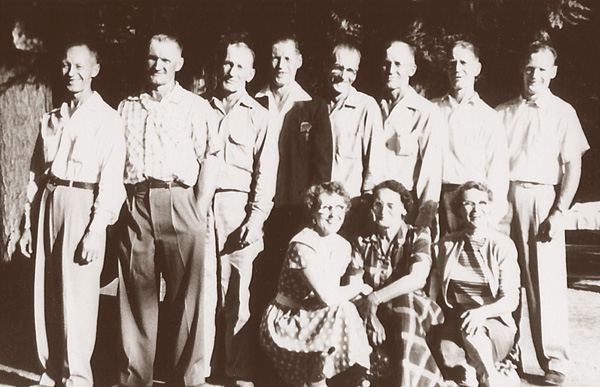
All of the children of William and Laura Nutter (except Eldore). (Left to right) Perry, Banks,
Everette, Victor, Orville, Wellington, Forrest and Darwin; in front, their sisters; Rose, Pearl
and Muriel. Photo taken in 1946.
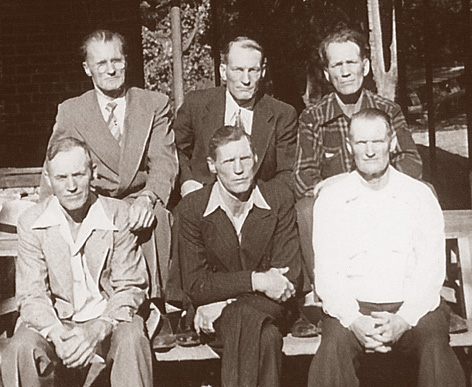
The Nutter brothers of William and Laura Nutter who worked as lineman. (Left to right) (at rear);
Orville, Everette, Forrest; (at front) Wellington, Victor and Banks
The Children of William H. Nutter and Laura Myrtle Comstock
William Orville Nutter (1893-1973) - was always known as Orville and formally
switched his first and second name around after reaching his majority. Sometime after 1910, he
was apprenticed as an electrician in Kearney, possibly along with his friend and soon to be brother-
in-law, Coyd Pickrell. He married in 1914 to Myrtle Pearl Reese (1897-1979) and the couple lived
with Orville's parents during the first six years of their marriage -- first in Gibbon, then in Scotts
Bluff, Nebraska. Orville finally got a job with Kearney Power and Light Company and moved
back to North Platte in 1920. Soon after, he got a job as a lineman for the phone company and
moved to Kearney where family lived until about 1936 when they moved to Roseville, California.
He worked for several companies there as an electrician until his retirement. Family members
remember him as a man of great intellect, much like his father and grandfather before him. He and
his wife both died of Alzheimer's Disease during the 1970s. Sadly their three sons and a daughter
did not enjoy the longevity of their parents. Kenneth Bruce Nutter (1914-1971) married twice, had
one son and four grandchildren. Coyd Levain Nutter (1919-1994) had two sons, seven
grandchildren and ten great-grandchildren. Gerald Galen Nutter (1924-1987) had a son and
daughter, four grandchildren and eight great-grandchildren. Jolita Mae Nutter (1934-2001) had
four children with her husband, Robert E. Miller, plus at least 3 grandchildren.
Pearl Lurella Nutter ( 1895-1988) - was the only girl among her parents' first nine
children. As one might expect in a rural farm family, she was disproportionately called upon, in
relation to her brothers, to provide care of her siblings. In fact, at the age of only fourteen or
fifteen, she was left for months with sole responsibility for five of them while her parents and
some of the older brothers went to Texas for an extended time. No one denies that Pearl was the
nurturing influence in the family. By the time she married Coyd John Pickrell (1892-1962) of
Kearney in 1913, she was disinclined to begin a family right away. In fact, it was nearly eleven
years after their marriage that the couple finally had a son who, sadly, was stillborn. Three more
sons were born in the next few years, one died as a child. Pearl's husband Coyd was a lineman and
electrician who earned a good living in Kearney and is credited with training, directly and
indirectly, his six brothers-in-law in that field. They moved to Roseville, California in 1937 and
remained there until 1957 when they moved to San Diego where Coyd died. Pearl returned to
Roseville in 1966 where she lived until the effects of Alzheimer's Disease required she move near
her son and his family in Puyallup, Washington in the 1980s. She died there at the age of 93.
Eldest surviving son Lloyd Gilman Pickrell (1926-2003) died in Kirkland, Arizona after marrying
twice. His second wife, Wanda Nadine Keenan (1925-1999), had been previously married to
Lloyd's uncles Darwin and Everette Nutter. By his first marriage to Madge Meekins, Lloyd had a
son and a daughter. Pearl and Coyd's next son, Garnett Berdine Pickrell (1928-1932), died before
his fifth birthday. Their youngest son, Garland Bennett Pickrell (born 1933), served in the US
Navy and married in 1964 to Kathryn Franzen Bryant. In addition to her children from a previous
marriage, they had a daughter and now, three grandchildren. Garland is retired from Boeing
Aircraft Corporation and lives in Puyallup.
Perry Alden Nutter (1897-1984) - was named for Commodore Matthew Perry and
John Alden, a settler of the Plymouth Colony. He was the only one of his parents' family who
never permanently moved to the west coast. At age 16, Perry began working in the cafeteria and
laundry at the tuberculosis hospital in Kearney, living near the institution with other staff in the
locally famous "Frank House" in the same town. Some years afterwards, he moved with his
parents and the family to Scotts Bluff. Here his father tried his hand at two different businesses: a
restaurant and a laundry. This was unlikely to be coincidental -- Perry's father was probably doing
his best to use whatever expertise Perry had acquired. However, Perry left the family's home in
Scotts Bluff and moved to North Platte, Nebraska where he took employment with the railroad. He
worked with them for the next forty-eight years most of the time as a baggage expressman. Perry's
work required extended periods away from his home base. In the 1930s, when the railroad
contracted to securely transport gold from mining projects in Canada to the Denver Mint, Perry
moved from Nebraska, living in Deadwood and Lead, South Dakota for some time before returning
to Grand Island. After remaining single until nearly his fortieth birthday, this handsome, always
dapper and compact gentleman finally married eighteen-year-old Dorothy Wilke (1918-1990) in
1936. The marriage was far from idyllic and ended in divorce twenty years later, but Perry was an
extraordinarily loving and doting father to the seven children that came along. Even his nephews
and nieces who lived on the west coast remember him fondly calling him a "jewel". He and
Dorothy also lived in Gibbon and St. Paul, Nebraska at times during their marriage. After Perry
retired from the Union Pacific Railroad in 1965, he moved to Puyallup, Washington, to be among
his many siblings in the area, but he missed his more immediate family. Therefore, he returned to
Marquette, Nebraska and eventually moved in with his daughter, Barbara in 1981 when his health
began to deteriorate. He died at the age of 87 from heart disease in 1984. Eldest daughter Sally
Elaine Nutter Roberts (born 1937) lived in California and Colorado before returning to Omaha, had
six children, seven grandchildren and one great-grandchild. Second daughter Betty Lou Nutter
Lyons Ogle Sacco Cannon Niedfelt (born 1939) has nine children from three of her marriages,
several of whom live in Louisiana, Alabama and Florida as do some of the eighteen grandchildren.
Third daughter Barbara Sue Nutter Townsley (born 1941) lives in Grand Island, has a son and a
daughter plus six grandchildren. Eldest son David Perry Nutter (born 1943) is married, lives in
Lincoln, Nebraska and has a daughter. Second son Daniel James Nutter (1945-1999) remained in
Nebraska, married and has two daughters. Youngest daughter Dorothy Delores Nutter Salmon
(born 1948) also lived in California for a while but has returned to Nebraska along with her
husband and two sons. Youngest son John Adrian Nutter (born 1952) is twice divorced, has one
son and has lived variously in Colorado, Anchorage, Alaska and Seattle, Washington.
Wellington Thomas Paine Nutter (1899-1991) - was named for Thomas Paine, the
American political theorist and writer, and George Wellesley, Duke of Wellington, from whom he
also took his lifelong nickname of "Duke". He left the family home in Scotts Bluff to join the US
Navy and, in his own words, "saw the world". He returned to Nebraska in the early 1920s, first to
Kearney, then back to his parents' original home near Gibbon. In 1924, Duke married Wilma Hazel
Dettamore (1904-1969) in Kearney and, with his brother Banks, their wives and children, they
moved to Spring Valley, Iowa, just north of Winterset. The brothers opened a bakery but the
depression took its toll and, after 1930, everyone returned to Gibbon. Afterwards, he and Banks
trained with their brother-in-law, Coyd Pickrell, like their younger brothers Everette and DeForest
had, and all became lineman -- first for the telephone company, then the electric company. After
President Roosevelt signed the Rural Electrification Act in 1934, their expertise was always in
demand. In the late 1930s, Duke and his growing family moved around Ohio and Iowa following
his work. In 1939, he and his family plus Banks and his family relocated to the Tacoma,
Washington area where their sisters had settled earlier. Duke and Wilma raised their family in
Puyallup where they lived the rest of their days. Duke retired from Tacoma City Light Company in
1964. Sadly, he enjoyed his retirement with Wilma for only five years until her death from breast
cancer. Duke stayed on his own for many years and ended up outliving his two eldest sons before
dying himself just before his ninety-second birthday. His eldest son, Wellington Perry (Duke
Junior) Nutter (1925-1980), who was a lineman like his father, married twice and had one son.
Second son, Donald Dean Nutter (1929-1979), died in an auto accident, left a wife, three sons and
a daughter and now has three granddaughters. Elder daughter Doris Wilma Nutter (1929-1929) was
Donald's twin, but was born the day after him and died shortly after birth. Younger daughter Nola
Delores Nutter Bacon (born 1935) has two sons and two grandsons. Youngest son Ronald Lee
Nutter (1937-1996) died of cancer in Shelton, Washington just a month and a half after his wife
died of the same disease. They left three children and two grandchildren.
Lincoln Banks Nutter (1901-1978)
- like his brother Orville, was always known by
his middle name and switched his names around for all legal purposes by the time he was an adult.
He was named for Sir Joseph Banks, a British naturalist and, of course, Abraham Lincoln. He was
married to Isabella Whitcher (1901-1975) in his hometown of Gibbon in 1922 and after his brother
Duke's marriage two years later, the lives of the two brothers and their families parallel for roughly
15 years (see above). Banks and his family moved to Puyallup, Washington in 1939 where he
continued to work as a lineman until his retirement. By the time his wife died of a heart attack in
1975, Banks was already suffering from Parkinson's Disease like his Grandfather Nutter.
Ironically, he died of the disease at virtually the same age as his grandfather. Banks and Isabella's
eldest son, Ebert Bruce Nutter (1922-1947) died with his wife of eighteen months, when a train hit
the car in which they were traveling near Knightston, California, Second son Dewey Ray Nutter
(1927-1989) was married three times. By his first wife, he has three sons and four granddaughters,
all in Washington. By his second wife he had six children, all of whom moved to their mother's
native South Dakota after their parents' divorce. With his third wife he had a daughter and two
grandchildren. Banks and Isabella's eldest daughter Mary Jane Nutter Pierce Johnson (1929-2000)
died in Roseburg, Oregon, and had three sons and three grandchildren from her first husband, two
sons, two daughters and five grandchildren from her second husband. Second daughter
Geraldine
Joanna Nutter Ballard Zachery Brasier Roehr (1932-2004) married four times. She had a daughter,
three grandchildren and a great grandchild from the marriage to her first husband, three children
and six grandchildren with her second
husband and a son with her third husband. Banks and Isabella's third son Gary Lee Nutter (1934-
1995) had a son with his first wife, two daughters with his second wife. Third daughter Belva
Annette Nutter Bennett (born 1936) lives in Tacoma, has one son and four grandchildren. Banks
and Isabella's youngest son William H. Nutter (born 1942) lives in Puyallup, has been married twice
and has three sons and two grandchildren from his first wife.
Ebert Ingersoll Nutter (1902-1914) - was named after Karl Eberth, a German
anatomist and Robert Ingersoll, an American orator known as "the great agnostic". Ebert was
twelve years old when he was kicked in the head by a horse late in the summer of 1914. He
seemed to recover from his injury and was eventually able to return to school. A dubious bit of
folklore survives that a teacher corrected Ebert by smacking him in his head. Whatever the case, a
blood clot became dislodged which eventually caused his death.
Everette Clinton Nutter (1904-1974) - was named after Edward Everette, an
American orator and statesman and George Clinton, another American statesman. He was actually
one of the first of the brothers to be trained by his brother-in-law, Coyd Pickrell, as a lineman. His
father sent him to Kearney to live with the Pickrells in the mid-1920s hoping a trade and steady
work would "tame" him. By 1930, he was working with the Kearney Telephone Company and
eventually got work with the electrification efforts along with his brother, DeForest, in various
localities across the Midwest (principally Ohio and Iowa) late in the 1930s. Everette finally joined
many of his siblings in Washington State sometime before 1941. It has been said that a few of the
Nutter boys made very poor choices for wives. Everette, despite the fact that he waited until his
forty-third birthday to marry first, actually seems to have made two poor choices. First was Lois
Frost McDaniels who was divorced with four daughters when she married Everette in 1947. After
they had a daughter together, Everette began the process of adopting the four girls Lois had. Lois
then abandoned Everette and all but her eldest daughter after the adoptions. After Everette and
Lois divorced in 1951, he released custody of Lois' daughters with her previous husband's parents
(the McDaniels) and put his daughter with Lois (Sandra) in the care of his brother, DeForest and his
wife, Edith, where she flourished. Everette married again, after the death of his youngest brother
Darwin in 1962, to Darwin's widow, Wanda Nadine Keenan (1925-1999) and welcomed the
opportunity to provide for and care for the three young daughters of Darwin with Wanda.
However, Wanda’s interest in yet another family member, Darwin and Everette's nephew Lloyd
Pickrell, contributed to the end of this marriage after a little more than five years. A few years after
he retired, Everette discovered he had lung cancer and moved to Dade City, Florida, to be with his
daughter and her family. He died there on 7 July, 1974. His daughter, Sandra Kay Nutter (1948-
1984) married Illinois native Kenneth Nichol whose work on oil pipelines necessitated frequent
moves around the country. About 1981, she, her husband and their family resettled in Bremerton,
Washington. Sandra drowned in a river rafting accident on the Yakima River at the age of 35. Her
son and oldest daughter live near Chrisman, Illinois and another daughter lives near Colorado
Springs, Colorado. Sandra has six grandchildren.
DeForest Gilman Nutter (1905-1978) - was named for Lee DeForest, an American
inventor and Daniel Colt Gilman, a famous American educator. Though many of his brothers were
proficient boxers, Forest was clearly the best of the brothers in the ring. He was trained as a
lineman by his brother-in-law, Coyd Pickrell, and did line work for the telephone company
throughout most of the Midwest. On New Year’s Day, 1930, Edith Koons (1912-1972) from North
Platte joined him in Missouri Valley, Iowa and they married. Just a little over a year later, their first
and only child, Walter DeForest Nutter, was born at Kearney, Nebraska. The family moved to
Bremerton, Washington late in the 1930s. After raising their own son, in 1951, Forest and Edith
lovingly welcomed into their home Everette's little girl who had been abandoned by her mother.
They raised her until her marriage in 1967. Even though Forest was battling prostate cancer, it was
Edith who died during an afternoon nap in 1972. Forest survived her by six years. Their son
Walter (1931-2005) retired from the United States Postal Service and lived in Bremerton,
Washington.
Victor Hugo Nutter (1907-1974) - was named for the famous French novelist. He
had begun his career as a lineman with the local telephone company in 1928 when Esther Bell
(1912-1998), a local girl, announced she was expecting Victor's child. Since Esther had to have
been only fifteen when conception occurred, her parents offered Victor two choices; marriage or
legal charges for having sex with a minor. When the Bell's pressed the issue, Victor acquiesced.
He and Esther married on 10 September, 1930, eighteen months after the baby's birth. Despite the
inauspicious beginning, the marriage lasted forty-four years and produced three more children. The
family left Arnold, Nebraska in 1941 and settled in Chehalis and then Yelm, Washington, south of
Tacoma in 1951. Victor worked for Puget Sound Power & Light Company for the rest of his career
and died of lung cancer two years after he retired. His wife, Esther survived nearly another quarter
century and died of esophageal cancer at the age of 85. Their only daughter, Doris Jenet Nutter
Halfacre (born 1933) still lives in Tacoma. She had a son (deceased), two daughters, one
grandchild and two great-grandchildren. The eldest son of Victor and Esther was Jack Hugo Nutter
(1929-1965) who died of a cerebral hemorrhage when his only son was 5 years old. That son now
lives in Puyallup and has four sons of his own. The next son was Larry Nutter (1938-2002) who
recently died of lung cancer in Pinehurst, Idaho leaving a daughter and three sons from two of his
three marriages plus a total of four grandchildren. Youngest son Leon Eldore Nutter (1947-1980)
died at 32 from cancer of the brain stem leaving a son and a daughter through whom he has two
grandsons.
Evalina Rosaltha Nutter (1908-2005) - was named for her mulatto grandmother
Evalina Rosaltha Eastman Comstock but she has been known throughout her adult life as Rose Lee.
She was a brilliant student in school and a gifted athlete overshadowing her sister Muriel who
struggled in school. Their mother, Laura, perhaps in a misguided attempt to "equalize" the girls,
downplayed Rose's accomplishments and favored, or appeared to favor, Muriel. As a result, Rose
sought an early exit from her parents' home. Though she married in 1925 at Kearney when she was
just 16, she had made a good match with Royal Lawrence Holmes (1905-1977) and they enjoyed
more than a half century together. They lived in Hastings, Nebraska until they became the first of
the family to move to the Tacoma, Washington area, settling in Parkland in 1936 or 1937. The
Holmes' had four children of whom only two grew to adulthood. In her sixties, Rose's interest in
horseback riding blossomed and she became quite a well-known and expert rider. She enjoyed the
pastime well through her eighties. In her widowhood, Rose outlived her only surviving son and in
1998, she moved to California near her only surviving daughter as Alzheimer's Disease began to
compromise her ability to live on her own. Rose and Roy's elder daughter Joyce Lorine Nutter
(1925-1934) drowned in a sand pit near Gibbon just after her eighth birthday. Their youngest child
was a boy who lived for three days in 1946. Son Larry Dolan Holmes (1933-1999) had three sons,
one daughter and nine grandchildren. Daughter Sherie Lee Holmes Korver Dixon (born 1939) lives
in Shingle Springs, California and is twice widowed with four daughters and five
grandchildren.
Jessie Muriel Nutter (1910-1974) - was known as Merl or Muriel throughout her life
and legally dropped her first name. Muriel was a poor student and was pulled from school early.
Based on the fact that several cases of dyslexia have been found among her descendants, it seems
likely she had the same problem. At home, Muriel worked hard and was often praised and
encouraged by her mother. Under Laura's able tutelage, Muriel became an accomplished
seamstress. If Muriel's sister Rose had ever found any reason to be jealous of Muriel, that quickly
changed once Muriel married Luther Claude Scott (1910-1980) in 1928. Luther was an alcoholic
who worked as a farmhand on local farms. They had a daughter and a son before they moved to
Yuba City, California in 1935. As they moved around that area of California and eventually,
Washington State, Luther's alcoholism and abuse of his wife and children escalated. Unfortunately,
Muriel began drinking too much as well, further taxing the family's already meager resources. In
1948, Muriel finally had had enough and divorced Luther. She moved to Centralia and remarried
to Dewey Emmanuel Lamb (1921-1995) in 1952 with whom she enjoyed comparatively much
more stability. Muriel died from cancer and a thrombosis in Centralia in 1974 just short of her 64th
birthday. Muriel and Luther's youngest daughter, Sharon Kay Scott (1943-1943) lived just a few
hours. Eldest daughter Doris Ilene Scott Dye (born 1929) lives in Olympia. Her son drowned at
the age of 31 leaving a wife and two sons. Doris' daughter has one son. Luther and Muriel's son
Duane Luther Scott (born 1933-2007) was divorced and had two sons, both of whom predeceased
their father..
Eldore Emmanuel Nutter (1911-1985) - was strikingly unlike any of his brothers in
appearance, personality and demeanor. This led to gossip in the more extended family that he did
not have the same father as his brothers. Lacking definitive DNA evidence at this point, it is
compelling to note that, whenever photos of Eldore and some of his brothers were presented to
disinterested observers outside the family, along with a picture of William H. Nutter, only Eldore
was consistently selected as William H. Nutter's son. This would seem to indicate that Eldore's
difference in appearance from his siblings arose as a result of his greater resemblance to their
father. Eldore moved to Roseville, California in 1937 with his mother and for years seemed to
move back and forth between there and the other family base near Tacoma, Washington. Perhaps
it was his marriage, in 1947, to Doris I. VandeKamp ( 1913-1988) and his employment with the
Boeing Aircraft Corporation which settled the question, resulting in them settling in Renton,
Washington. He died there in 1985 from stomach cancer. Eldore and Doris had no children.
Darwin Clifford Nutter (1913-1962) was named for his father's hero, English
evolutionist Charles Darwin. Though his name now has more benign implications, in his youth
Darwin's name was a "red flag" to teachers and others who regarded Charles Darwin as a "godless"
influence on society. He married Audrey Angela Bayley (1917-1970) in their hometown of
Gibbon, Nebraska, in 1934 when he was 21 and she was 16 and expecting a baby. Three years
later, Darwin, his wife and two children moved to Roseville, California with his mother and older
brother Eldore. Somewhere along the line, Darwin developed an expertise as an auto body
repairman which insured his regular employment for most of his adult life. Darwin moved back
and forth several times between California and Washington and his marriage to Audrey ended in
divorce in 1946. He married secondly to Wanda Nadine Keenan (1925-1999) in 1951 and they
settled in Yelm, Washington in 1955 after the birth of the first two of their three daughters. Darwin
was sickly as a child. Doctors thought he had rheumatic fever and his brothers would pull him
around in a wagon rather than allow him to walk. Finally, an abscessed tooth was discovered to be
the problem. Once it was pulled, he returned to normal and, like his older brothers, he became a
golden gloves boxing champion. However, the infected tooth left him with a much damaged artery
to his heart which eventually required surgery and for which he required continued treatment. Yet,
his heart problem would not turn out not to be the source of his undoing. Rather, his prolonged
exposure to paints and solvents in his work combined with his heavy cigarette smoking seems to
have resulted in his contracting lung cancer. He died just short of his forty-ninth birthday in 1962.
Darwin's only son, Glen Alden Nutter (born 1935) lives in Allyn, Washington and has been married
three times. His only daughter has one son. Daughter Shirley Joan Nutter McLeod Hebard
McAllister (born 1935) has a son and two daughters. Darwin had three daughters from his second
marriage. The eldest was Judith Carol Nutter Brahun Hughes (1953-2002) who had two daughters
and one grandchild. The next daughter, Terri Lynn Nutter Peterson (born 1954) had three
children and a grandson. Youngest daughter Cheryl Ann Nutter White Bonomi (born 1955) has
three children and one grandchild.
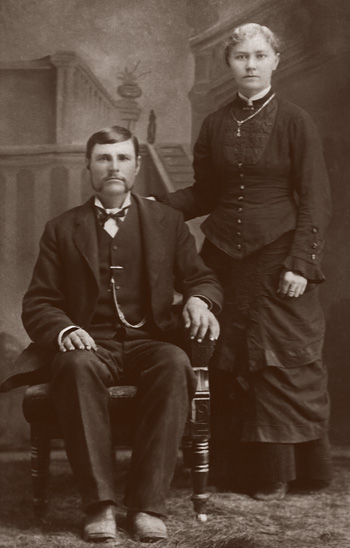
Walter and Ellen Williams
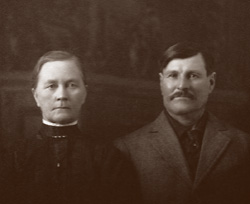
Walter and Ellen Williams
Ellen Nutter, sixth child and eldest surviving daughter of William and Dinah (Ingham) Nutter,
was born during the time they lived among the Mormons near present-day Salt Lake City, Utah.
The family resided at the Sessions Settlement near the growing town of Bountiful when Ellen
arrived on 14 July 1861.
Ellen was just a toddler when she was forgotten...twice...by her family. She was left sleeping
when her parents and older siblings abruptly left the homestead in Nebraska in 1864 fearing an
impending Indian attack and then again, a few months later, as her parents left Liverpool train
station bound for their hometown in England. Of course, Ellen herself had been oblivious to both
the incidents as she was just a toddler. Once her parents recovered from their initial panic, they
were eventually able to see the humor in the occurrence with due deference to Ellen's feelings.
Ellen began school at Old Bethany Presbyterian in Philadelphia, Pennsylvania when her family
returned to the USA. After the family homesteaded in Nebraska, Ellen was schooled first in the
make-shift school in the abandoned railroad shack near Wood River Center, then in the room
above Oliver's Store in the same community after it was renamed "Shelton". She finished school in
the late 1870s and became the first teacher at Bluff Center School nearby.
Either late in 1880 or early in 1881, Ellen met Walter Stanton Williams who was nearly ten
years her senior. Not incidentally, Ellen's sister, Ione, met Walter's younger brother, Boyd. Both
Walter and Boyd had left their father's home in Ray County, Missouri and were boarding with local
families while they worked for the Union Pacific Railroad.
Walter Stanton Wiliams (1851-1930) was born in Salem Township, Henry County, Iowa to
Lilburn Johnson Williams (1820-1910), an Indiana native and Margaret Amanda Leseur (1825-
1859) whose precise origins remain obscure. There is family lore that suggests Margaret or her
father was a Creole (ie. of mixed French and Indian heritage). Lilburn's family had originated in
Wales. They were Quakers who immigrated to a Welsh community south of Philadelphia,
Pennsylvania in the early 1700s. Afterwards, the Williams' ancestors moved south to North
Carolina then, incrementally, westward through western Virginia, Tennessee, Indiana, Illinois, then
Iowa. Lilburn Williams, a blacksmith who saw service as a captain in the Civil War, seems to have
moved often himself - from Indiana to Iowa to Illinois to Missouri then Kansas.
Walter Williams married Ellen Nutter on 22 November, 1881 and moved into a sod house near
Kearney. If they farmed, it was a very small farm on leased land. Walter's main work was as a
grading contractor, expertise he had picked up from his time with the Union Pacific Railroad.
Mules were the muscle behind his work on the railroad and on the farm. Despite Walter's hard
work, the couple was financially unable to buy land as prices in Nebraska spiked in the 1880s. In
1887, he and Ellen decided to seek their fortune elsewhere. The young couple had also acquired
three other mouths to feed by that time; daughters Bertha Olive, Alice Loretta and Ethel, all born in
that sod house.
Ellen and Walter imagined their future was on the west coast. However, when they left
Nebraska, they headed due southward first almost all the way through the entire state of Kansas to
Meade County near the Kansas border with Oklahoma. They had received news that Walter's
father Lilburn had recently been widowed again and was having difficulties. They travelled by
covered wagon pulled by some of the many mules and other cattle which traveled with them. Their
first destination was the latest homestead of Walter's father, Lilburn Williams. Walter's brother,
Boyd and his wife Ione, Ellen's sister traveled with them having married just months after Ellen and
Walter.
Lilburn Williams was a disowned Quaker who had already been married and divorced prior to
marrying Walter and Boyd's mother (Margaret Amanda Leseur) in Lee County, Iowa in 1847. After
Margaret's death in 1859 in Ray County, Missouri, Lilburn married Mrs. Malinda Caroline Knight
Hathaway twelve months later. Thereafter they had moved to Meade County, Kansas, where
Malinda had also died on 10 March, 1887 leaving him with several teenage children still at home.
Walter, Ellen and their three little girls wintered with the family there along with Boyd, Ione and
their two little girls.
And what a winter it was. In mid- January, 1888, all of the plains, from the Dakotas to Texas,
were hit with a snowstorm of historic proportions. Snow measured in feet rather than inches,
sustained winds of more than fifty miles per hour and temperatures which fell just below thirty
degrees below zero Fahrenheit characterized the storm which lasted several days. Walter's father
lost some of his livestock in the storm and Walter lost a few of his mules. If Walter and Ellen had
entertained thoughts of remaining on the plains, the blizzard may have well been the proverbial
"last straw".
Ironically, when Walter and Ellen left Kansas in the spring of 1888, they traveled next through
Denver to Ellen's birthplace near Salt Lake City, Utah. This was an incredibly long and arduous
journey. Again, the family entertained thoughts of settling in Utah, but eventually continued
westwards. Walter, Ellen and their daughters plus Boyd, Ione and their daughters arrived in Seattle,
Washington in February, 1889.
The Walter Williams family moved around southern Washington and northern Oregon quite a
bit during their first years in the area. Walter began working for the Union Pacific Railroad once
more, building railroad lines through the area. This work allowed the Williams' to amass some
money with which they could buy land. It also allowed for them to survey the area for the best
land for the best price. During this period, in 1892, their last child, a son named Wallace, was born
at Wood's Landing, Washington along the pristine shores of the Columbia River. In 1898, their
daughter, Ethel, died during their time in The Dalles, Oregon.
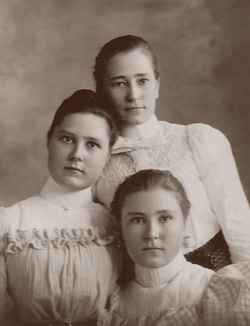
Bertha and Alice Williams (left and bottom), eldest daughters of Ellen and Walter,
and their double cousin Jessie Williams (top), daughter
of Ellen's sister, Ione and Walter's brother Boyd.
Within the next few years, Walter purchased an entire section of land (640 acres) about forty
miles west of Madras, Oregon. To the north was the Warm Springs Indian Reservation; to the west
were the Cascade Mountains. Even today, this area is still rather remote, well away from the
amenities of the nearest large town, Madras. This beautiful landscape was to be their home for
several years. They then moved to a similar, but smaller piece of land south of Madras in Crook
County.
Walter farmed the land, growing wheat for the most part. Again, he chose mules as his beasts
of burden and had as many as two hundred on the land west of Madras. On the smaller farm, he
had a stable of about fifty. Ellen ran the household. On the larger farm, Ellen's specialty was
cooking several enormous meals each day for the many farm hands that often lived with and near
them.
Over the years, Ellen grew interested in religion. Walter had influenced her somewhat with the
elements from his family's Quaker roots. She had found some comfort in religion upon the death
of their eleven-year-old daughter in 1898. But it was the death in 1912 of their only son Wallace in
a hunting accident which sent Ellen deeply into a religious fervor which she continued for the rest
of her life.
In her widowhood, Ellen's mother Dinah travelled to the west coast at least twice, (1907 and
1912), accompanied on the first visit by Ellen's youngest sister Louise, her husband Reuben Miller
plus the Millers' son and daughter. This would be the first time Ellen had seen her mother and sister
in more than two decades. It is believed that the Millers were contemplating relocation there.
However, they eventually returned to Nebraska for good.
After World War I, Walter and Ellen sold the farm (which everyone called "the ranch") in
Oregon and moved to a home at 62 North Road in Rock Creek on the outskirts of Stevenson,
Washington. Their daughters had each married and moved there some years before. Walter
invested his savings and the money from the ranch primarily in a mutual fund called Electric Bond
and Share.
Unfortunately, Electric Bond and Share was extraordinarily vulnerable to the stock market
crash of 1929. The fund's manager, Samuel Insul, fled the states to avoid prosecution and soon
afterwards threw himself under a train in the Paris subway. Ellen and Walter's wealth was mostly
lost.
Volney Branstetter, husband of the Williams' daughter, Alice, also took a big hit from the stock
market crash, so they moved in with Walter and Ellen. As if in reaction to his financial ruin,
Walter's health began to fail. Walter's problems were more than financial though. A cancerous
stomach tumor was discovered. Confined to his bed, he developed pneumonia and then suffered a
pulmonary hemorrhage from which he died on 25 October, 1930, two weeks after his seventy-
eighth birthday.
Ellen Williams continued living with Volney and Alice. Early in her widowhood, she returned
to Nebraska with a mission; to save the souls of her atheist brothers and sister. Though her siblings
were delighted to see her again after so many years, they were, at the same time, appalled that she
had become, in their opinion, a religious zealot. Ellen went back to Washington with her mission
unfulfilled.
Ellen enjoyed a happy, modest and devout old age and delighted in the occasional proximity of
her four grandchildren and some great-grandchildren. After her eightieth birthday (1941), her
short-term memory began to fade, though her ability to remember events from earlier times
remained sharp. In September, 1945, Ellen fell in the home she shared with her daughter Alice and
Volney Branstetter and broke her hip. She was transported to a North Bonneville, Washington
hospital where she succumbed to pneumonia on 22 September, 1945, at the age of 84.
Because only Bertha Olive, the eldest child of Walter and Ellen Williams, had any children,
they left a comparatively small family which is still growing. The details of those descendants are
set out below.
The Children of Ellen Nutter and Walter Stanton Williams
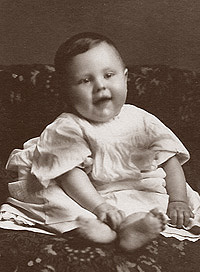
Ray McKeighan, son of Alex and Ellen McKeighan
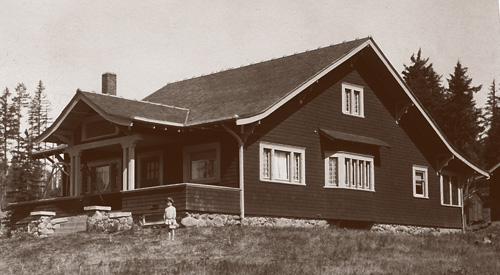
Thought to be the home of Alex and Bertha McKeighan in Stevenson, WA - 1913
Bertha Olive Williams (1883-1964) - was born in the sod house that was her parents'
home near Kearney, Nebraska on 28 February 1883. Her formal education took place in any
number of makeshift schools throughout southern Washington and Northern Oregon as her parents
moved around that area. As haphazard as her education might have seemed, it was comprehensive
enough to enable her to become a teacher soon after the turn of the last century. Soon after, she
met and married Illinois native Alexander McKeighan (1878-1928) settling first in Collins, then
Stevenson, Washington. Their first child died at birth about 1903 but they eventually had a
daughter and two sons and adopted another daughter in 1925. Alex McKeighan worked as a
highway contractor and eventually became the Washington State Highway Superintendent before
he succumbed to Bright's Disease at the age of 50. Bertha took in young teachers for room and
board to supplement her income in her widowhood and eventually remarried to Azro Patterson
Gordon who was the sheriff of Skamania County. After his death of her second husband, Bertha
moved in with her daughter in Vancouver, Washington. Her mind remained sharp in old age
perhaps as her result of her love for quiz shows on television and her love of a good game of
cribbage. She had hip replacement surgery but developed a reaction to the material used in the
prosthetic joint and eventually had to have the joint removed. She was effectively immobilized and
died soon afterwards. Oddly, all of Bertha's descendants have left the Northwest and moved to the
south except for the family of her adopted daughter Louise LaVonne McKeighan McComas
Strecker (born 1924). Bertha and Alexander's eldest son, Ray McKeighan (1905-1986) worked for
the United States Army Engineers for 35 years. His son Linn McKeigan (born 1936) worked for
IBM before retirement in Austin. Texas. His two daughters whom he finished raising after his
divorce also live in Texas. Bertha and Alexander's daughter Helen Elizabeth McKeighan Lawrence
(1907-2006) lived in Dothan, Alabama with her son Russell M. Lawrence. Russell and his wife
lived for years in the Panama Canal Zone where they raised their family. They have two sons in
Texas, a daughter in Arkansas and three grandchildren. Russell's only sister, Carol Elaine Lawrence
Ester (born 1942) lives in Texas, has one son there and two granddaughters. Bertha and
Alexander's youngest son, James Knox McKeighan (1910-1990) was a civil engineer with the
United States Corps of Engineers who finally retired in Washington State after moving often during
his career. He and his wife had no children.
Alice Loretta Williams (1884-c. 1964) - married Volney Z. Branstetter (1868-1962)
in 1911 in Wasco County, Oregon. Branstetter had a wheat "ranch" near Alice's parents' ranch.
And, like Alice's parents, Vol and Alice took a big financial hit in the stock market crash of 1929.
Vol had sold his ranch and invested money but continued to work on farms near Stevenson for
many years.
After her husband died at 94, Alice moved to a nursing home in Yakima where she died a few
years later. She and Volney had no children.
Ethel Williams (1887-1898) - was born in her parents' sod house near Kearney, just
before they left Nebraska. She died at the age of 11 during the family's time in the Dalles,
Oregon.
Wallace Harvey Williams (1892-1912) - was born at Woods Landing on the Yakima
River in Washington. He was named for two of his father's brothers. He died in a hunting accident
in 1912 near Madras, Oregon at the age of 20.
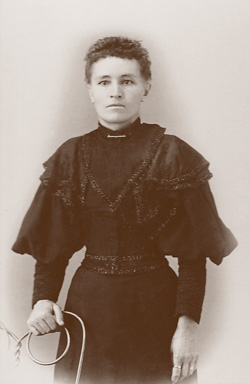
Ione (Nutter) Williams
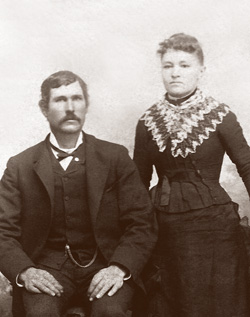
Boyd and Ione Williams
Ione Nutter, the seventh child and second eldest surviving daughter of William and Dinah
(Ingham) Nutter, was a twin sister to Lyone, both born 30 October, 1863 in a log cabin about two
miles east of present-day Shelton, Nebraska. Her father had worked hard that summer, building an
additional room onto the log cabin in which they lived in addition to the regular work on the farm.
Years later, Ione's mother Dinah would recall that she worked very hard on the farm that
summer and fall as well, quite memorable to her as she was pregnant with the twins. The new
room, measuring 12 feet by 18 feet, effectively doubled the family's living space.
The twins were not quite a year old when their mother and father snatched each of them up in
their cracker box cradles in the middle of the night to escape from what they believed was an
impending Indian attack. In the autumn of 1864, most settlers in the eastern third of Nebraska
abandoned their homes and their claims to flee eastward believing the "savages" were on their way
to lay waste to their communities. Ione's parents took her and the family all the way back to
England via the port of Quebec in Canada. On board the ship, the twins contracted scarlet fever
and by the time the family landed at Liverpool and made their way to a relative's home in
Barrowford, Lancashire, the twins' condition was critical. A doctor was called in and Ione was set
aside as "hopeless". He did his best to save Lyone but she died 17 May, 1865. "Hopeless" Ione
recovered and flourished.
The Nutter family returned to the United States the next year and settled again in Nebraska in
the summer of 1869. Ione began school in an abandoned railroad shack near Wood River Center
(later Shelton), Nebraska a few miles east of the family's new homestead. Again, the substantially
augmented Nutter family settled in a log cabin which would be Ione's home until she married.
Ione's elder sister, Ellen, met Walter Stanton Williams in 1880 or 1881. Some time afterwards,
Ione was introduced to Walter's younger brother, Boyd Witten Williams (1856-1897), who like his
brother Walter, was boarding with a local family and working on railroad construction. These were
the "two sisters, as different as they could be" who met "two brothers as different as they could be"
in the estimation of the girls' mother, Dinah Ingham Nutter.
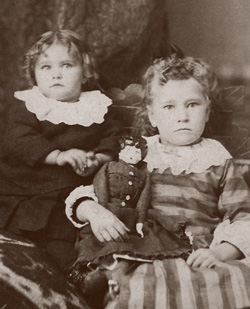
Jessie Williams (left), daughter of Boyd and Ione Williams, with her double cousin Alice,
daughter of Ione's sister Ellen and Boyd's brother Walter.
The courtships moved along in tandem. Ione and Boyd married on 28 March, 1882 at Kearney,
four months after Ellen and Walter. Like Ellen, Ione had three children in the first few years of her
marriage. Unfortunately, the second child, a boy, was stillborn in 1884. Both families decided to
seek their fortune elsewhere in 1887. Though their ultimate destination was the northwest (ie.
Oregon or Washington), they headed due south at first to meet and winter with the Williams
brothers' recently widowed father, Lilburn Johnson Williams at his most recent homestead in
Meade County, Kansas.
The winter Boyd and Ione spent in Kansas was punctuated by the "Schoolchildren's
Snowstorm" in mid-January, 1888. The storm lasted several days and buried much of the plains in
several feet of snow accompanied by winds in excess of fifty miles per hour and temperatures
falling beyond thirty degrees below zero Fahrenheit.
The Williams' time in Kansas was the only time Ione would meet most of Boyd's siblings. It
was not the only time she would meet his father.
In the spring of 1888, Ione and Boyd accompanied Ellen and Walter on the long trek north
towards the Pacific Northwest. They made the journey by covered wagon pulled by mules and
drove mules and other livestock along the trails through the Rockies. They stopped for some time
in Denver and for a more extended time in Salt Lake City. The Williams entourage arrived in
Seattle, Washington in February, 1889.
That summer, Ione gave birth to a son in Seattle. It appears that, as soon as they were able to
travel, the two Williams families parted ways. Boyd, Ione, the two girls and the newborn John
Franklin Williams headed for Gray's Harbor on the Pacific coast of Washington. They then went
south to McMinnville, Oregon but ultimately settled in a burgeoning town of four thousand souls
further south named Salem.
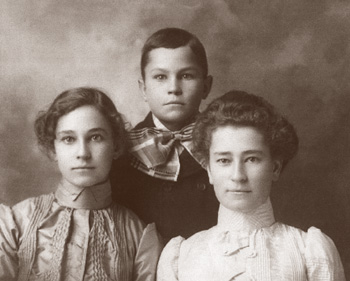
Grace, John, and Jessie Williams, children of Boyd and Ione Williams
No family lore survives to explain why Ione and Boyd settled in an urban area when the
background of both was agricultural. Also, no lore or documentation survives to tell us how Boyd
and Ione provided for their family throughout the early 1890s. However, it is clear that Boyd
began drinking heavily during this period. Those who knew Ione would later speculate that she
may have tolerated the drinking, but when Boyd began being abusive, there simply was going to be
no way she would tolerate that.
Considering the mores and circumstances of those days, Ione made a tremendously courageous
decision; she decided to leave Boyd.
A story survives that Ione packed up her children and their belongings and set off on foot with
a milk cow in tow for The Dalles, nearly a hundred miles away. When she arrived at her sister
Ellen's home there, one can only imagine what happened. Ellen's husband was Boyd's brother, so
Ione's story of alcoholism and abuse, at the least, left Ellen and Walter somewhat conflicted. Ellen,
who was substantially more conservative than Ione, likely felt Ione should "work it out" somehow
with Boyd. And apparently, Ellen and Walter did not entertain the possibility of making Ione and
her three children a permanent addition to their household. Ultimately, Ione and the children
returned to Salem for either a trial separation or reconciliation. Whichever was the case, nature was
about to decide the future of their marriage.
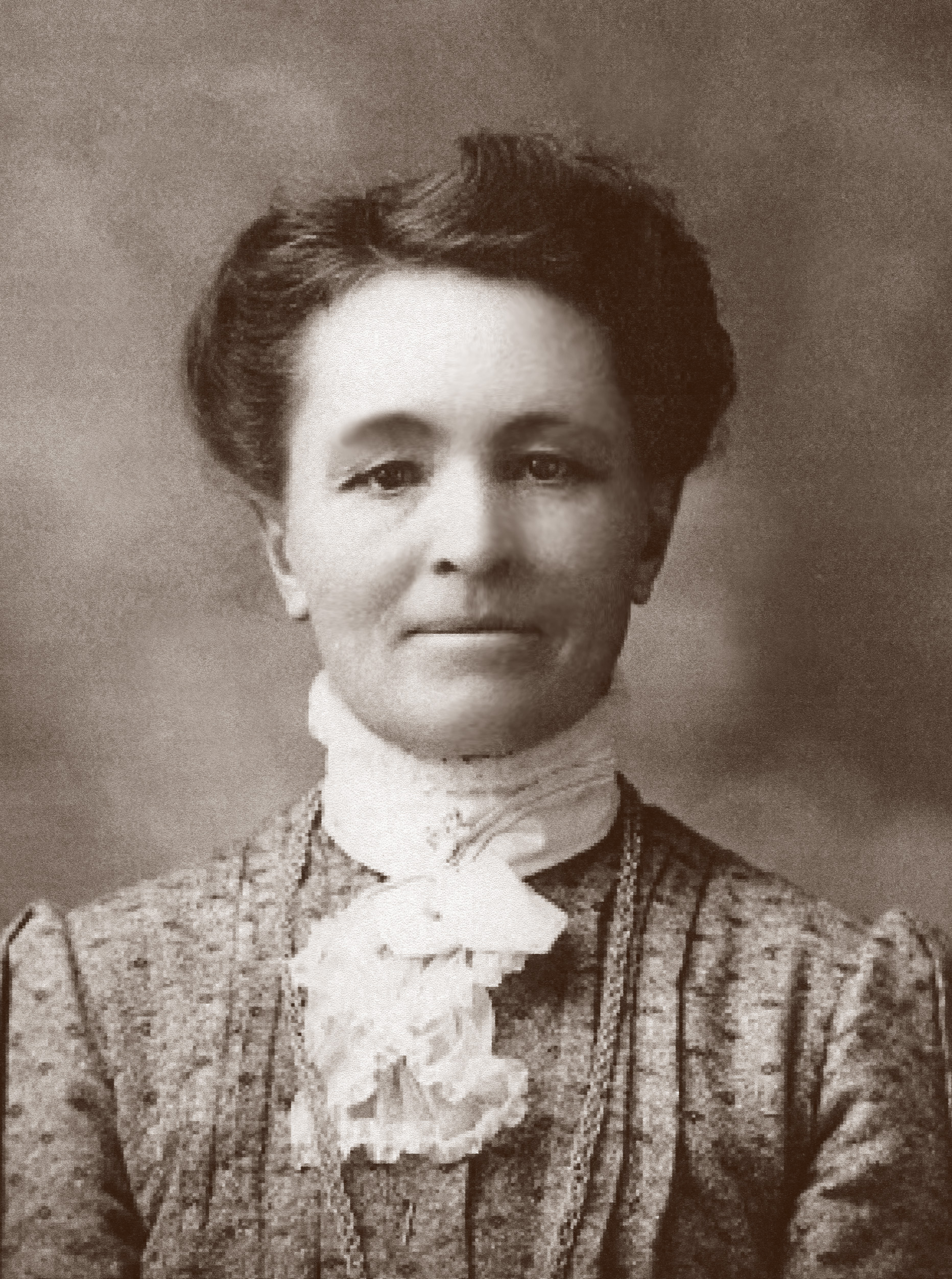
Ione (Nutter) Williams
Throughout the mid-1890s, there were typhoid epidemics across the United States in the
growing and congested urban areas where water and sewerage systems were overtaxed. Salem was
no exception. Boyd came down with the disease early in March, 1897. He was either back with
Ione and the family or she simply took pity on him and personally nursed him throughout his
illness which proved fatal on 16 March, 1897 at the age of 41. He was buried at the Salem Pioneer
Cemetery.
Ione's oldest daughter, Jessie, had to quit school and go to work. It isn't known where Ione
worked in these years, but a good guess is that she did some work at the fairgrounds where Oliver
Perry ("Perry") Mauzey trained horses. He also supplied horses for the local police force of which
he was a part time officer.
In either 1898 or 1899, Ione's father-in-law came to Oregon from his home in Meade County,
Kansas. It is unclear what motivated Lilburn Williams, now nearly eighty years old, to come to the
west coast. Some family members claim he had lived in Oregon years before had worked as a
surveyor and longed to see the northwest one more time. Others say Ione requested his help and
perhaps, his financial assistance as well.
Ironically, Lilburn Williams' presence probably facilitated the blossoming romance between
Ione and Perry Mauzey. Once Mauzey obtained a divorce from his wife, Flora, he and Ione were
married on 3 June, 1900. The census that year records the new family at 500 High Street in Salem;
Mr. and Mrs. Mauzey, the three Williams children and Lilburn Williams - "boarder". Lilburn
returned to Kansas that year where he died in 1910 at the age of 90.
In 1901, Perry and Ione bought a home and some property at 142 Miller Street in downtown
Salem. On Christmas Day that year, Ione's elder daughter, Jessie, married George Pearl who
worked in the same laundry as Ione. Before the next Christmas, Ione was a grandmother at the age
of 39. Also, during the same time, Ione's 12 year-old son, John Williams, left school and went to
work living mostly away from home. Daughter Grace moved out and married in 1906, leaving
Ione and Perry on their own.
In 1904, Ione's sister Jennie, her husband Will Hogg and their two sons came to Salem and
bought land along the Williamette River near Salem. They successfully farmed the land and
became very well-to-do. There doesn't seem to be much evidence that either Ione or Jennie had
much contact at all with their sister Ellen Williams who lived near Madras, Oregon. Perhaps Ellen's
growing religious fervor was a divisive factor. In 1907, Ione's recently widowed mother Dinah
Nutter came to Salem from Nebraska. Dinah hadn't seen Ione in nearly 21 years and had never
even met her son-in-law Perry nor her own grandson, John Williams. Dinah also visited again in
1912.
Ione and Perry made a comfortable life in Salem. Perry was well-liked and respected by Ione's
family. John returned home occasionally in between jobs. Jessie, Grace and their families lived
some distance away from Salem. As soon as Jessie's boys attained a reasonable age, Grandma Ione
and Perry would arrange for each to have a horse of their own, trained by Perry. In the meantime,
Perry maintained his association with the Salem police department.
In 1920, Perry Mauzey was shot in some sort of altercation. As he was 68 years old, it was
amazing that he survived. However, his career in the strenuous work of training horses was soon
over. Perry and Ione moved to Columbia City, Oregon along the Columbia River in 1922 and lived
either with or near daughter Jessie and her husband, George Pearl. Perry never fully recovered and
died on 23 September, 1923. Ione returned to their home in Salem.
As she approached her sixtieth birthday, Ione was a widow for the second time in her life but in
rather different circumstances. This time, she owned a home of her own and she was a woman of
some means.
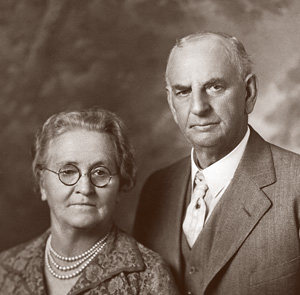
Ione with her 3rd husband, Casper Hepp
Ione met her next husband on the streets of Salem. Casper Hepp was a "huckster" - a not
altogether complementary term for a traveling salesman. He was supposedly selling brushes and
related cleaning products in front of a store when Ione first met him and was apparently
smitten.
Casper Hepp had been born in New York City one year to the day after Ione. His first wife had
died leaving him with at least one son, Arthur, to raise. He then married his second wife, Barbara,
in 1895 and had four daughters with her. In the early days of their marriage, Casper saw service in
the 8th US Cavalry during the Spanish-American War and lost a leg in the conflict. Soon after
1905 he and the family moved to Seattle, Washington. By 1920, they were in Portland, Oregon and
within the next few years, Barbara died.
Truth being stranger than fiction, Ione was married to the hobbling one-legged huckster with the
New York accent less than two years after Perry's death. Casper brought to bear his considerable
powers of persuasion on Ione. He convinced her that they should move to San Francisco,
California and open a store selling cleaning supplies. It is not known why they selected San
Francisco. Perhaps Casper wanted to be near an established veteran's hospital as he had chronic
difficulties with the amputation site of his leg. Perhaps he wanted to remove Ione from the scrutiny
of her family as some believed the old huckster was simply anxious to have easy access to Ione's
considerable financial assets.
The couple did move to San Francisco, California and rented a storefront and apartment at
1781 Mission Street. At this store, called "American Janitor Supply", the Hepps sold cleaning
equipment and other hardware for many years and they prospered. Later, the Hepps built a small
home around the corner at 52 Isis Street where they lived the rest of their lives.
Ione welcomed the periodic visits from Oregon of her children and grandchildren at the
holidays and other times of the year. Strangely, no one ever recalls her going back to Salem for
any reason at any time. Still, she retained the property she and Perry Mauzey owned at 142 Miller
Street in Salem and even replaced the frame house on the land with a brick house. Her son John
Williams collected the rent and did maintenance on the structures. Ione always contended she
would return there to live one day.
Late in the 1930s, Casper and Ione would periodically welcome into their home Ione's sister,
Alice Scott for extended stays. Alice had been widowed in 1934 in Julesburg, Colorado and had
lost her sight after an operation for glaucoma. Ione was also plagued with similar problems with
her eyes but never lost her vision totally.
The site of Casper's leg amputation was unrelentingly problematical. Attempts to wear a
prosthetic leg led to regular visits to the veteran's hospital for treatment of irritation, inflammation
and infection. In the 1930s this led to an ominous succession of further incremental amputations
and complication upon complication. Of course, gangrene was almost inevitable and indeed that
was what finally caused Casper's death on 6 August, 1940 at the age of 75.
Ione's younger daughter Grace Zimmerman, who had become a widow in 1938, eventually left
her home in Grant's Pass, Oregon and moved in with Ione on Isis Street. Ione enjoyed good health
and a clear mind throughout her eighties and even lived to see a couple of great-great grandchildren
before her death on 10 March, 1953 in her ninetieth year. She was buried next to Casper at the
Presidio Military Cemetery in San Francisco.
The Children of Ione Nutter and Boyd Witten Williams
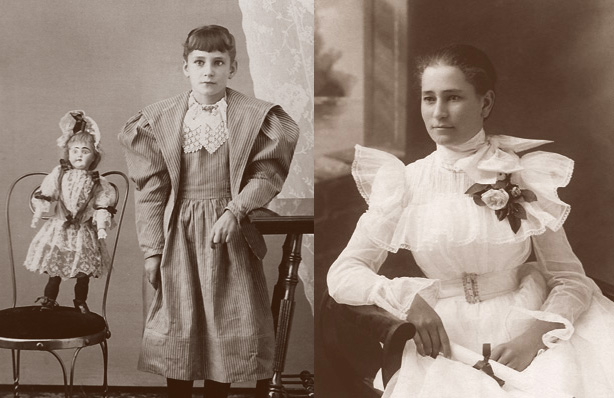
Jessie Williams, daughter of Boyd and Ione Williams
Jessie Amanda Williams (1882-1980) - The earliest memories of Jessie Amanda
Williams were probably from the nomadic period following her family leaving the sod house near
Kearney, Nebraska where she had been born. The family went to visit her paternal grandfather's
farm in Meade County, Kansas in 1887. From there, her parents headed to Denver, Colorado, then
Salt Lake City, Utah, then Seattle and Gray's Harbor, Washington followed by McMinnville and
Salem, Oregon by 1893. At 14, she had to leave school when her father died in a typhoid epidemic
in Salem. Though all the family seems to remember Jessie as a gem of a woman, she officially
became a "Pearl" when she married George Leslie Pearl (1873-1943) on Christmas Day, 1901 in
Salem. The couple left Salem in 1905 for an area north of Portland along the Columbia River near
a town called Clatskanie. They bought a "stump farm" where, as the name suggests, little farming
was possible and where logging was the principle industry. In addition to running the household
and raising the children they had, Jessie also worked as a cook in the logging camps. George
worked as a teamster and a logger, but often "wandered", looking for opportunities elsewhere -
sometimes as far away as Alaska. He worked right up until death at 70 as a night watchman in a
logging camp. Jessie lived on her own for many years and then with her children as cataracts and
glaucoma robbed her of her eyesight. Of her six children, three sons and one daughter lived to
adulthood. Sadly she outlived her three sons dying just after breaking her hip at the age of 97.
Her eldest daughter, Grace Olive Pearl (1902-1990) was the eldest great-grandchild of William
and Dinah Nutter, the main subjects of this book. She married a logger named Otto Cantwell with
whom she had four children. Eldest daughter Frances Ann Cantwell Vandebogart Christians (1924-
1976) was murdered while taking a lunchtime break from her work in a secluded area overlooking
the Pacific Ocean. She left a son and a daughter and now has a granddaughter. Grace's son Leslie
Everette Cantwell (1926-1934) died the day before his eighth birthday. Grace's daughter Lurena
Rae Cantwell Brady Miller (born 1931) lived for several years in Ketchikan, Alaska but now
resides in Toledo, Washington. Her only son died in a traffic accident. Her daughter and a
granddaughter are still in Ketchikan. A grandson lives in Seattle and another granddaughter is in
Richmond, Virginia. Grace's youngest daughter, Judith Lee Cantwell Holsey (1940-1997) died in
Oregon after a lifelong battle with diabetes and left no children.
Jessie Amanda Williams Pearl's next child was Grace Ione Pearl (1904-1904). She only lived
five months.
Jessie's eldest son, George Herbert Pearl (1905-1933), married very young to Lyla Langdon and
had two sons Raymond George Pearl (born 1924) and Dean Pearl (born 1926). Lyla later divorced
George. George remarried Lurena Hughes in 1931 but was crushed to death in a logging accident
two years later. His sons by his first marriage were later adopted by Lyla's second husband and
used his surname (Arnold). The family has lost touch with them. Both are married and, at last
contact, Dean was living near Los Angeles.
Jessie's youngest daughter Gertrude L. Pearl (1909-1910) died of whooping cough near
Clatskanie at the age of three months.
Jessie's youngest son, Harold Lester Pearl (1911-1973) began as a logger and eventually got
involved with supplying equipment to mills and ultimately became quite successful in the logging
business. He died on a European tour in Bucharest, Romania. With his second wife, a Canadian
named Pearl Martin, he had one son Jack Leslie Pearl (1939-2004) who lived in Burnaby, British
Columbia as does his widow, only daughter, grandson and granddaughter.
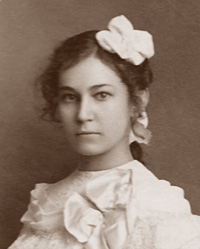
Grace Williams
Grace Diana Williams (1886-1985) - married William Lloyd Zimmerman (1883-
1938) and moved from Salem to Grant's Pass, Oregon near the Northern California border where
her husband worked for years with the railroad. After his death, Grace moved in with her mother,
Ione, on Isis Street in San Francisco and lived there until the early 1970s. By then, the little house
was in the midst of a very industrial area under a freeway overpass. Grace finally moved to her
daughter's home in Lake Oswego where she died just short of her hundredth birthday. Grace's only
child, Dorothy Lyle Zimmerman (1907-1996) married Joseph William Wise (1900-1983) and lived
for years in Eugene, Oregon where he worked for Pacific Fruit and Produce. Their only son,
Richard Louis Wise (born 1939) lives in Gleneden Beach, Oregon and has no children. Dorothy's
elder daughter Kay Corinne Wise Wood (born 1941) had a son and a daughter in Fresno,
California. Younger daughter Donna Eileen Wise Willis (born 1944) has a son and two daughters
born in Portland. By 1985 that family had moved to Milwaukee, Wisconsin.
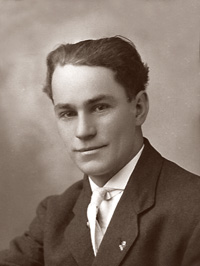
John Williams
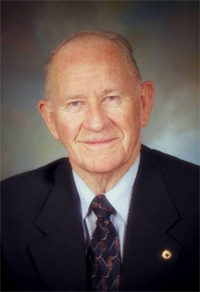
John Williams II - Mayor of Oregon City
John Franklin Williams (1889-1959) - was the youngest child of Ione and Boyd
Williams. He left school and home at the age of 12 and went to work as a "Gandy dancer" (ie. a
laborer in a railroad maintenance gang). Not long afterwards, he became an attendant in the local
insane asylum and held other odd jobs, sporadically returning to his mother's home. He finally got
regular work with the Oregon Electric Interurban Company and married Annette Blodgett, a trained
nurse, in Portland in 1917. After joining the National Guard, he was almost deployed into action
during World War I. However, the war ended and John ended up being quarantined in Seattle as a
result of the Spanish Flu epidemic. In the city of his birth, Seattle, he got work with the Great
Northern Railroad but was laid off in 1919 when he embarked on an odyssey in pursuit of work
which took him all the way east and south to New Orleans, Louisiana. Ultimately, he returned to
Portland, Oregon in 1920 where their first son was born and where he began a career with the
Union Pacific Railroad. The family moved to Seattle next where the second son was born. In
1937, he lost an arm in a railroad coupling accident. The company provided work for him
afterwards for the rest of his career. He became a Mason and worked his way up through the
Masonic hierarchy to a position of substantial influence and respect in that organization and in the
community at large. He died just short of his seventieth birthday from Hodgkin's Disease. John
and Annette's elder son. Gene Merritt William's (born 1920) served in World War II in the Pacific
theater. He has been married twice and has three sons by his first wife and six grandchildren. He
was with the Occidental Insurance Company in Salem for many years. The Williams' younger son,
John Franklin William's II (born 1928), saw service in the Korean War. He has a son and a
daughter with the first of his two wives and has two granddaughters. Early in his career, he
managed radio stations but later went into advertising and started his own agency. He served as
Mayor of Oregon City, Oregon from 1998 to 2002.
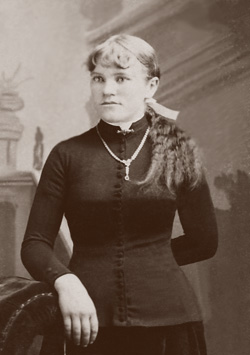
Elizabeth Margaret Nutter
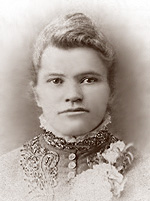
Elizabeth Margaret Nutter
Elizabeth Nutter was born as "Margaret" on 4 December, 1865 at 18 Anne Street, near the town
center of Burnley, Lancashire England. She was the only child of William and Dinah (Ingham)
Nutter born during their brief return to England from their Nebraska homestead. Her parents were
already well along in their preparations to return to the area of their Nebraska claim by the time she
was born. In fact, her father left for America a month and a half after her birth followed by the
rest of the family some months later.
"Libby" was less than 4 when her parents finally settled back in Buffalo County, Nebraska, into
the small log cabin that would be their home for the next eighteen years. She was educated with
her siblings at the crude school facilities in nearby Shelton.
Elegance and gentility are difficult commodities to accrue or maintain on the frontier though her
sisters did quite a good job in doing so. Libby had no interest whatsoever in such attributes and
was quite competitive with her siblings, particularly her older brothers. She actually demonstrated
substantial expertise in "breaking" horses and in horsemanship in general. Libby bristled if her
brothers, her father or anyone deferred to her because she was a member of the "weaker" or
"fairer" sex.
Libby taught school in rural Buffalo County for a couple of years. She also studied for a while
at a Baptist Seminary in Gibbon at some point in her life.
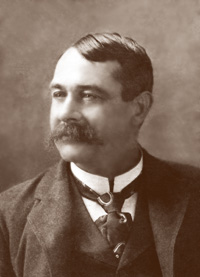
James Robertson
Despite the fact that she was aggressive and "earthy", Libby attracted the attention of a burly
native of Wedowee, Alabama who had recently come to Nebraska. James F. Robertson (1861-
1925?) was smitten with Libby and married her at Kearney on 20 February, 1889, just over a year
after she and her family had moved into the octagonal house. It is unclear whether the young
couple moved into their own home or simply lived with Libby's parents in the octagonal house.
Libby gave birth to three sons in the first five years of their marriage. Sometime after the
summer of 1894, James Robertson announced his intention to head to the northwest - specifically
Washington or Oregon. He left Libby and the three boys with Libby's parents at the octagonal
house. He said he would send for them once he was established.
Apparently, Jim Robertson never quite got established. The only thing known for sure is that
Libby claimed he never sent for his family. His sons claimed that their mother heard from him
occasionally. Some say he sent for them but was ignored. But it seems most likely that Jim saw an
opportunity to get out of his marriage with Libby and did so. If he did go to Washington or Oregon,
he was not recorded in the censuses of 1900, 1910 or 1920 unless he heavily obscured his identity.
Libby began describing herself as a widow in the census of 1910 and did so again in 1920. Still,
one source in the family claimed James Robertson died after Libby - in 1925 in Renton,
Washington.
For the rest of her days, Libby and her three boys lived off the good will of her parents and her
brothers, particularly William. Until 1900, they lived with her parents in the octagonal house. She
then prevailed upon her brother Will to build her a small house between his parent's farm and his
adjacent farm. She spent the rest of her life in this little home.
Libby grew corpulent over the years and was remembered as not particularly industrious by
those family members who knew her. Though she had a very small home, it seemed always in
disarray. To be fair, she was of great assistance to her mother as she cared for her father, William
Nutter, during his final illness. However, there were frequent, very ugly disagreements between
Libby and the wife of her younger brother Frank's wife, Katie Link.
Libby's chief avocation seemed to be finding fault with anybody whom she encountered. After
doing whatever damage she could among her family she broadened her horizons. In nearby
Kearney there was a growing chapter of the Ku Klux Klan whose philosophies resonated well with
Libby's bitter disposition. Though she had to hide her own foreign birth, Libby found camaraderie
among the hooded bigots.
Sadly, she was able to recruit some of the sons of her brother Will, into the Ku Klux Klan,
though these boys would have to deny their own origins as well. Each had a "Negro" great-
grandmother on their mother's side.
Luckily, Libby's three sons did not inherit her unpleasant personality nor her bitterness. Each
was a devoted son who spoke in glowing terms of their mother while most family members within
earshot simply wondered who the boys were talking about. Each of her sons owed an enormous
debt to their uncles; Will Nutter had always insured they had a place to live while Frank and
Mirabeau taught them virtually everything they knew about farming and trained both Bob and Ben
to become very skilled carpenters.
Of her parents' ten children who grew up, Libby was the first to die. Ten days before her fifty-
eighth birthday, Libby succumbed to cancer of the liver at her son's home in York, Nebraska on 24
November, 1923. She was buried with her parents at the Riverside Cemetery.
The Children of Elizabeth Margaret Nutter and James F. Robertson
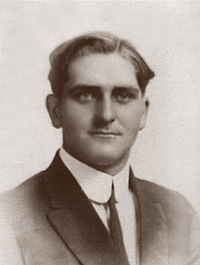
Lorton William Robertson
Lorton William Robertson (1889-1976) - graduated from Gibbon High School in
1906 and attended college at Kearney. He taught school for seven years afterwards and farmed
near Ravenna, Nebraska during that time. On 16 May, 1911, he married Florence Urwillwer at St.
Michael, Nebraska. The marriage was an unhappy endeavor, childless and ended in divorce. His
major work during his life was as a mail carrier out of Ravenna from 1919 to 1959 though he also
hauled oil and gas during this time, worked in Rasmussen's Grocery and was employed by Major
Brothers Locker for a time as well. In 1945, he married secondly to the former Clara Alice Razim
(1897-1976) and welcomed her three daughters and son into their home as his own. Clara passed
away after a brief illness in 1976. Lorton was asked what he would do after Clara's death. He said
he had a "plan". Less than a week after Clara's funeral, Lorton leveled a shotgun at his head in his
home and ended his own life. He was 86.
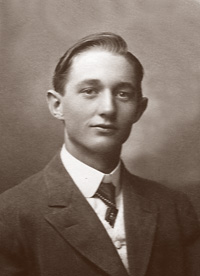
Robert Burns Robertson
Robert Burns Robertson (1891-1977) - was named for the renowned Scottish poet
who was intrinsic to the Scottish heritage of which his father was so proud. He graduated from
Gibbon High School in 1910 and then attended Kearney College. Thereafter, he taught school
locally and worked on several local farms, mostly on land owned by his uncles and cousins. He
specialized in sheep farming and was a master carpenter. Bob did not serve in World War I as he
believed his role then was to ensure his mother's well-being after the marriage of his older brother
Lorton. When another opportunity to serve came along with World War II, Bob joined the United
States Army at the age of 51 and served in Okinawa among other places in the Pacific theater until
August, 1945. He enjoyed the camaraderie of the younger soldiers who all seemed to call him
"Pop" because of the age disparity. Bob lived on his own for most of his life and never married.
He maintained better contact with his many Nutter cousins than he did with his two brothers but, in
truth, was sociable and agreeable with virtually everyone he encountered. He cultivated and
enjoyed a certain celebrity status in the local community around Gibbon and Shelton as a historian
and was enormously proud to be the grandson of one of the earliest pioneer families in Buffalo
County. He battled Parkinson's Disease and significant blindness from macular degeneration in his
old age but maintained his independence and cheerful disposition. He died at the Nebraska
Veterans Home in Grand Island on 22 March, 1977 at the age of 85. There is evidence that Bob
fathered a son with a woman in the Gibbon area and that son continues to live nearby.
Benjamin Harrison Robertson (1894-1979) - also graduated from Gibbon High
School and taught school locally for two years. Later he farmed in the Gibbon and Shelton area for
nearly 60 years retiring finally in 1975 at the age of 81. He married at Kearney on 8 September,
1931 to Lodema Woods whom he had known all his life. In fact, she had grown up on a farm
adjacent to the farm on which his mother lived. "Ben" and "Deemy" never had any children and,
essentially, grew older and more eccentric as the years passed. Both were compulsive talkers and
both simply took little notice of each others' monologues while visitors were unintentionally
discouraged by the cacophony the couple generated. Like his mother, Ben gained an enormous
amount of weight as he grew older. Despite his obesity, Ben lived until he was 84. Deemy died a
little over four years later.
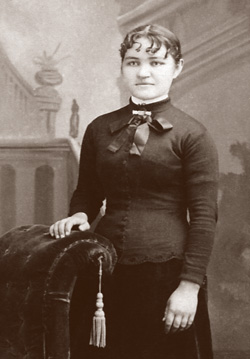
Alice Nan Nutter
Alice Nan Nutter was born on the first day of summer, 1867, at 2116 Naudain Street in
Philadelphia, Pennsylvania. Her parents, William and Dinah Nutter, had just come from England
the year before with her five older siblings, repeating a journey they had made nine years before.
As before, their time in Philadelphia was to be merely a stopover during which her parents would
save enough money to move westward.
And move west they did - in July, 1869. As a result, Alice never had any childhood
recollection of living anywhere else but in the log cabin along the Wood River northeast of Gibbon,
Nebraska. Like her siblings, Alice attended school in nearby Shelton, first in an abandoned railroad
shack, then in a room above Oliver's store. Like her sisters, she taught school in the rural
schoolhouses in the area. Alice was a beautiful girl with sharp blue eyes and curly black hair like
her mother.
At 16, she met Wesley Elton Scott (1862-1934). For some reason, Alice's parents and older
brothers took an instant and vehement dislike to him. Granted, Wes was crude, illiterate and
disinclined toward manual labor. However the intensity of the Nutters' feelings seems to indicate
that there was something more to their disdain for "that no-good Wes Scott" - always the full
moniker reserved for him. As the Nutters generally had a proven history as a forgiving and
inclusive lot, one has to wonder if they may have known something about him or saw him do
something which they found utterly intolerable or unforgivable.
So, it was with great horror that the family learned that Wes and Alice married at Kearney the
day after New Year's Day, 1886. The couple then "ran off" to western Nebraska.
Little but the basics is known about Wesley Scott's origins. Born on 20 August, 1862, he was
the eldest child of farmer Jacob Wesley Scott (1828- after 1880), a native of what is now West
Virginia and Effie Jane Waters (1842- after 1880) who had been born near Georgetown, in Brown
County, Ohio. After Wes came a daughter, Effiette, then three more sons; John, Thomas and
William all born on the Scott farm near Bethlehem, Iowa near the Missouri border. Whatever drew
Wesley Scott and his family to Buffalo County, Nebraska early in the 1880s is unknown.
Wes and Alice Scott settled in Verango, Nebraska along the state's border with Colorado. Even
today, Verango is still a very small village, squarely in the middle of nowhere. One can only
imagine how devoid of facilities and amenities it was when the Scotts chose it for their home in
1886. Their first child, Weaver, was born there on 2 December, 1886. The child died somewhere
over the state line on the prairie in Colorado on 21 September, 1887 - some say from malnutrition -
and was buried along the trail. Alice always contended that the child died from drinking unboiled
water from a buffalo wallow. Of course, Alice was already expecting a second child by that
time.
While they wandered the prairie land of Nebraska and Colorado, Alice's mind yearned for
stimulation and challenge. When they came close to civilization, Alice would buy newspapers to
catch up on current events. She would then use these newspapers as visual aids while she did her
best to teach Wes Scott to read and write. Wes was an anxious student and both realized that his
"talents" would likely flourish if he, at the very least, learned to read and write.
Wes and Alice's foray onto the prairie after eloping, for the most part, was a complete failure.
It did not surprise her parents when they returned to the Nutter homestead late in 1887 seeking
shelter for the winter and a home in which Alice could give birth. Alice's parents, along with the
rest of the family, were in the midst of moving into the magnificent octagonal house they had
recently constructed on their farm. Despite the fact that the Nutters loathed the company of Wes
Scott, it was apparent that they thought it prudent to offer the log cabin that was their former home
to the young couple. The Nutters felt they could at least monitor Alice's condition and
circumstances.
Alice gave birth to another son on 23 January, 1888 in the log cabin. The infant, named Celcer,
died within a few hours. Again, some say that Alice was malnourished and believe that was the
cause of the infant's failure to thrive. The infant was buried on the Nutter farm.
Another son, Colin Cecil, was born a year later on 21 January, 1889. Subsequent records
indicate he was born either in Colorado or near Amherst, Nebraska (northwest of Gibbon). If
correct, this indicates that Wes and Alice left the Nutter farm again only to return once more by the
time a fourth son, Basil Oscar Scott was born on 7 February, 1891. The Scotts then returned to
Colorado where ColRussell (later called "Carl" or "Rusty") was born 17 November, 1893. Once
again, they returned to the Nutter farm by 1895 where a sixth son was stillborn and buried on the
farm.
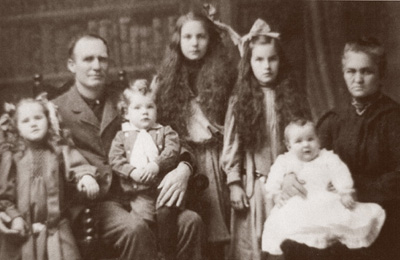
Wesley and Alice Scott with their younger children (about 1908). (Left to right) Icis Scott,
Wesley Scott holding his namesake who was known as "Buster", Tela Scott, Rose Scott and Richard
Scott being held my his mother, Alice (Nutter) Scott
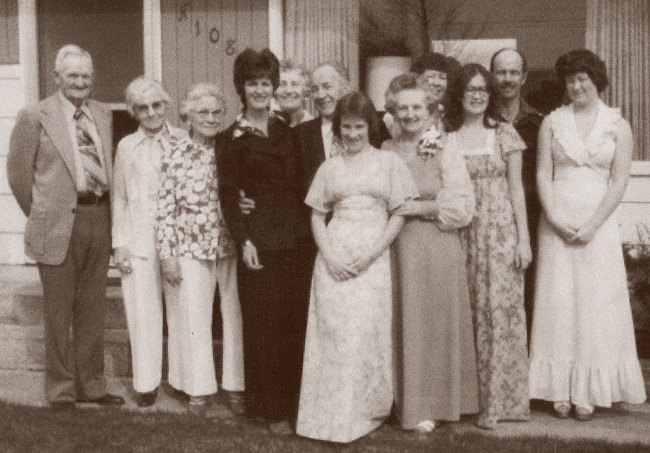
Some descendants of Wesley and Alice Nutter Scott in a 1976 photo taken on the occasion of
the golden wedding of Wesley "Buster" Scott and Marion Scott. From left to right (with an *
marking a child of Wesley and Alice Scott); Oliver Lindblom, Tela Scott Lindblom*, Rose Scott
Mikelson*, Kitty Scott Ryzek (daughter of Richard Scott*), Ruth Scott Miller*, Wesley "Buster"
Scott*, Tammy Fine (Buster's granddaughter), Marion Scott (Buster's wife), Sharron Fine (Buster's
daughter), Cynthia Fine (Buster's granddaughter), Richard Fine (Buster's son-in-law) and Lonni
Fine (Buster's granddaughter)
The Scotts stayed either at the Nutter Farm, or later, in a small frame house they purchased
nearer to the town of Gibbon for the next thirteen years. Four daughters; Tela Wessie (1897), Rose
Mae (1898), a stillborn girl (1900) and Icis Edith (1903) plus two more sons; Wesley Elton (1905)
and Richard Ray (1907) were all born during their time near Gibbon.
During these years, Wes Scott lived down to the expectations of his in-laws. While living on
the Nutter farm, he was often afforded the opportunity to do "an honest day's work" on the farm
and he regularly refused citing ill health. However, he did engage in trading of equipment, cattle
and other commodities with the locals and some of the deals were regarded as "shady". This
mortified his in-laws who highly valued their good reputation in the local area. All the more galling
to the Nutters was the fact that Wes was actually making a decent living for his growing family -
something the Nutters never believed he would do without doing an honest day's work.
It was also during these years that the relationship between Wes and Alice and between Wes
and his children deteriorated even further. Their daughter Bess would note many years later "(my
parents') life together was mostly misery for both of them almost from the beginning. Two more
opposite people could never have happened to each other. Mother was little, soft and gentle while
Dad was big and hard and tough."
Wes and Alice agreed on virtually nothing. Wes had some strong opinions about how children
should be raised and about how a house should be kept. It appears that Alice decided these were
issues on which she was going to take a stand. For instance, Wes believed the girls should do
certain household chores, like washing the dishes. Alice refused to enforce such a rule. So, when
Wes would see dirty dishes in the kitchen, he was known to spit chewing tobacco juice on the floor
implying that if she tolerated dirty dishes, she should be able to handle a wad of brown sputum as
well.
Wes regularly returned to the Julesburg area in conjunction with his business deals. In the end
he saw the Julesburg area as a better venue for his type of "work". Among its many advantages
was the fact that it was 300 miles away from the scrutiny and familiarity of his in-laws. It seems
that, several years before Alice, Wes and the family left the Gibbon area in 1908, there was a huge
disagreement between Alice and her mother, Dinah, along with some, perhaps all four of her
brothers. No doubt the Nutters were scared to death to have Alice and the children live away from
their scrutiny. Sadly, it appears Alice never again had any direct contact with her mother and was
estranged from most of her siblings until well after she was a widow herself.
Wes put a down payment on a section of land north of Julesburg and another smaller parcel in
town on which he commissioned a home to be built. By May, 1908, he brought Alice and the
children there somewhat before the house was completed. The family stayed in a hotel for a time
until they could occupy the house.

The Scott family home in Julesburg, Colorado - Then (1908) and now (2016).
Soon, the house was "finished" - if one can use that term for this structure. The building was
on property at the corner of Oak and 9th street near the center of the town of Julesburg (later given
the address of 913 Oak Street). The yard was heavily graveled, devoid of any grass, shrubs or
trees nearby, save for a small willow outside the kitchen window. It was essentially a stark, gray
cement block cube two stories high with four square rooms on each floor. The four upstairs rooms
were all used as bedrooms. On the ground floor, the room to the left of the entrance was the dining
room, leading to a large kitchen at the back of the house. To the right of the entrance was a parlor
off which there was Wes and Alice's bedroom separated from the parlor by a curtain. There was an
unfinished attic room used for storage and a basement with a dirt floor. On the front and back of
the house were long porches sheltered by a shingled roof supported by wood posts
There was no inside running water. All water had to be carried in buckets from the outside
pump near the back porch. There were no closets. There was no sink. There was no inside toilet -
the two-seater outhouse was moved as necessary, sometimes near the barn, sometimes moved
nearer the machine shed. There was no electricity until 1925, when it was brought in by their son,
Colin. Electricity was then distributed throughout the house by drop cords hanging from the
ceilings.
Perhaps in comparison to previous residences, the roominess of this house better suited the
sizable family. The family grew just a bit more with the birth of the two last children of Alice and
Wes Scott; Ruth Mildred in 1908 and Elizabeth Grace (Bess) in 1912. However, the stark, cold,
gray house without amenities or adornment seems to have served as a metaphor for the bleak life
endured by most of the Scott family children and their parents.
Though the house stood on a substantial tract of land was well within the town of Julesburg, it
still had the trappings of a rural farm; there was a cement block barn for cattle, feed, hay and grain.
A wooden tool shed housed small pieces of farm equipment and eventually served as a garage.
There was also a chicken shed attached to the barn as well as a small corral for horses and
cattle.
Wes Scott began speculating in real estate and was rather successful. He also continued trading
other commodities, specifically horses and other cattle. His family never saw him put in a full day
of any kind of "work" once they moved to Julesburg. There were numerous "business meetings",
sometimes at home but most often, elsewhere. Alice was left in the dark as to the details of Wes'
various business deals and became suspicious of their nature. Amazingly, the chasm between Wes
and Alice widened even further. She grew resentful of her estrangement from her family back in
Gibbon and Alice would herald Wes' impending arrival home to the children with the
uncharacteristically disparaging announcement "Daddy-devil has peeked over the fence".
Wes' undeniable wit, charm and intelligence were apparently spent away from his home in his
business dealings. At home, he was stern with the children and with Alice. Any wit he showed
almost always had a nasty edge to it. Alice and the children seemed to enjoy his absence rather
than his company. She never went anywhere and is said to have gone five years without ever
having left the house.
Half of the section of "school" land north of Julesburg which Wes had purchased separate from
the home tract, was farmed for several years by his three oldest boys, Colin, Basil and Rusty. The
other half was leased to a family named Ebke. However, the boys' work and remuneration for the
same became a point of contention between the boys and their father. The boys, the elder girls and
Alice herself seemed to believe that Wes' business dealings, though they paid the bills, had little
value and were actually matters of some question or shame. Meanwhile, their own hard work
seems to have not been recognized by Wes as a valuable contribution.
At some point tensions in the household escalated. There survives a story that, on separate
occasions, Basil and Rusty each had an extreme physical confrontation with their father. In each
case, the boys were supposedly so badly beaten that their actual survival was in question.
Naturally, this marked the end of the "business" association Wes may have had with these two.
Many of the children left home as soon as it was feasible. Colin, Basil and Rusty lived in a one
room house out on the farm for years, but the eldest two joined the army while Rusty enlisted in the
Air Force during World War I. (In the 1930s, the one room house was moved off the farmland to
the home property at Oak and 9th streets). Tela and Rose were both married during the Great War.
Icis began her self-destructive wanderings during those years as well and, at one point, returned
with a baby (Dale) whom Alice ended up raising as her own.
Alice received word that her mother, Dinah Nutter, had passed away back in Gibbon, Nebraska
on 30 December, 1918 at the age of 84. Some said that Wes forbade Alice to attend the funeral,
some say Alice herself refused to go. It was actually a moot point as a snowstorm made travel,
even by rail, impossible. In Dinah's will was a provision that, her two youngest sons (Frank and
Mirabeau) would inherit the family farm providing they insure the well-being of two of their sisters;
Libby Robertson and Alice Scott. Libby had been abandoned by her husband years before. The
Nutters, or at least Alice's mother, apparently believed Wes Scott was still likely to abandon Alice
and the children. Alice, not usually inclined toward bitterness of any sort, was nonetheless
disturbed by the terms of her mother's will. Perhaps she perceived the passing of an opportunity to
be financially independent of her husband.
By 1920, Wes had retired to the delight of no one. Colin had returned from the war but refused
to engage in battle with his father so he hired on as a farm hand nearby in southwestern Nebraska.
Basil got married, and lived nearby for a while working as a dray man. Rusty went to work as a
lineman for the Union Pacific Railroad. Rose lived nearby with her husband and family for many
years and became quite adept at "handling" her father and his difficult ways. Tela and her family
simply moved away to Nebraska. Icis showed up occasionally, always while her father was away,
never for long, never for good. Wesley Junior and Richard (aka Buster and Dick) were champions
to their younger sisters Ruth and Bess as they ran interference for them with their father.
Matters grew worse in the 1920s. Wes Scott occasionally still continued to look for business
enterprises in which to invest even in retirement. With a peculiar lack of caution, Wes invested
most of his savings in a natural gas well scheme presented to him, (and to a number of other local
residents), by a stranger passing through the Julesburg area. When Wes Scott and the other
investors later went to Arizona (and/or Nevada) to look into the progress of the enterprise, they
were horrified to learn there was no progress simply because there was no such well. Once again,
Alice and Wes were poor.
As difficult as it may be to believe, things got even worse. Wes mortgaged the farm and took
over direct management of operations. The problem with this arrangement was that Wes was
quickly sliding into dementia - perhaps Alzheimer's Disease or simply senility from arteriosclerosis.
In the earliest stages of the illness, Wes became very difficult - more so than usual. Relief actually
came for Alice and the family when Wes' physical condition began to deteriorate quickly in the
wake of his mental abilities. Soon he "simply" required constant care and was bedridden. By the
time the census enumerator came to the Scott house in 1930, all the children lived elsewhere except
for the youngest, Bess. There was an extraneous note near Wes Scott's name saying he was "not
well".
By 1931, Alice lost the sight in her right eye. What caused the blindness is in dispute. She did
not have cataracts. It seems that she may have had glaucoma or a detached retina but given the
number of people in the family who suffered from macular degeneration, that condition seems as
likely a cause as the others. She consulted an ophthalmologist who said she must have surgery on
her left eye to save her remaining sight. Alice agreed to the operation and went to a Denver
Hospital for the surgery during which she would have to be awake. She clearly remembered the
doctor doing the surgery in the midst of which he let out a barely audible gasp. From that point
onwards, Alice was totally blind.
She returned to her home in Julesburg and began to adjust to her plight. Her daughter Bess,
who had never even been asked to do even regular household chores was suddenly the only "able"
person in the house and upon her shoulders landed virtually all the household duties. Bess' father
was now senile and bedridden. He needed to be fed. He needed his diapers and bedding changed.
Alice, her mother, was adapting to her total blindness and reassuming as many household chores as
she could manage. No doubt, nineteen-year-old Bess had to be simply horrified by the grim future
that lay ahead if she stayed at home. In November, 1931, Bess "ran off" and got married to Willard
Peters (aka. "Stub"). Realizing that young love and impetuousness always trumps practicality, Alice
gave her "baby" Bess her blessing as she headed for Sidney, Nebraska to be married.
The only Scott children then remaining in the area of Julesburg were Rusty and his wife Molly
and Colin with his wife Frieda, who lived some three houses away. Rusty was virtually no help to
his parents, but his wife occasionally assisted Alice.
Colin was as helpful as he could be, but his health began to fail markedly as 1932 began. He
was taken to the Veterans' Hospital in Denver by mid-February and suddenly died on 26 February
at the age of 43. Someone, possibly Colin's widow, Frieda, or perhaps hired help had to be
employed to assist Alice and Wes in their home until Wes died on 15 January, 1934. At some point
soon thereafter, Alice's daughter Ruth went to Julesburg, tied up some basic loose ends and drove
her mother to Buster and Marion's home in Pasadena, California. For most of the remainder of her
life, Alice made her home with them.
Ultimately, it was Buster who returned to Julesburg in 1935 for a while. He made some
improvements on the Scott home, among them bringing city water into the house. He arranged to
rent out the house for a while and finally sold the farm and the house in 1941.
In the meantime, Buster realized how heavily time weighed on his mother. He persuaded her
to learn Braille which she quickly did - an amazing accomplishment for a woman close to 70. She
was able to pass much of her time reading Braille literature. She interacted with the grandchildren
quite a bit and reprised her role as a teacher on occasion to help them with school work.
Unfortunately, she could do little to help with the running of a household - the work with which she
had been most familiar for the past five decades. However, she designated herself as the family's
dishwasher - a task she could quite handily execute by touch regardless of her blindness.
At her own discretion, Alice would occasionally leave the various homes she shared with
Buster and Marion and stay with some of the others. She even rekindled a relationship with her
sister Ione and stayed with her for some time in San Francisco in 1939.
Sadly, Alice was bound to outlive two more of her children. About 1937, the family received
word that Icis had died in San Francisco from a drug overdose. Alice hadn't seen her for years and
was practical enough to know she would never come to a good end. She was still profoundly
saddened. Alice moved to Oregon with Buster and Marion in 1940. Many of her other children
moved there as well. Her youngest son Dick died in Bend, Oregon on 14 June, 1945, leaving a
wife and two little girls. Alice had now survived seven of her fourteen children.
In the summer of 1945, Alice moved with Buster, Marion and the family to Coeur d'Alene, then
Post Falls, Idaho. Eventually, Rose and her family, Bess and her family, plus grandson Dale all
moved to that area. Even in these years, Alice entertained a fantasy that a medical procedure
would be discovered that would restore her sight. She yearned to see the numerous grandchildren
and great-grandchildren that had come along just once. Sadly, her world remained dark and it
gradually got even darker.
Alice moved with Buster and Marion to Santa Monica, California in 1951, then back to
Spokane, Washington in 1952, then to Newport, Washington the year after that. She also had brief
stays with Ruth in California and Rose and Bess in Post Falls. Beginning about 1954, she began to
have intermittent difficulty recognizing voices of various family members and remembering who
they were. She also intermittently suffered from "waking nightmares". These were horrifying
hallucinations which, for their brief duration, were absolute reality for her. Most often these terrors
seemed to involve children in distress or danger. By 1955 or 1956, the already daunting
requirements of Alice's day-to-day care became more than her children could be expected to
provide. Reluctantly, they installed her in a health care facility at Spirit Lake, north of Post Falls.
Alice's daughter, Bess, wrote the following poem in
1955:
How many times I heard her say, "O, miracles happen every
day,
I know they do! It just could be - One may restore my sight to
me."
Long years she waited, hoped and prayed; her looked-for
miracle seemed delayed,
Then came a day she knew at last, her dream of seeing faded
fast.
The death of hope, an ugly thing, takes all the promise out of
Spring,
Steals the warmth from the Summer sun, Leaves desolation
when it is gone.
Tho' years of pain have reaped their toll, Alone could not
destroy her soul,
The endless days in sightless dark, Snuffed its last and
ling'ring spark.
She waits the death that still eludes, for life goes on but her
excludes.
She's lost in worlds we do not know, Alone she wanders to
and fro.
How long to roam so restlessly? So frail, so weary, mind at
sea.
Surely earned she, life's repose! How long to wait? God only
knows.
Alice died 10 October, 1958, a few months after her ninety-first birthday.
Ten of the fourteen children born to Wesley and Alice Scott reached adulthood. Their stories
follow.
The Children of Alice Nan Nutter and Wesley Elton Scott
Colin Cecil Scott (1889-1932) - The birthplace of Colin Scott is disputed. Some
family members said it was the Nutter farm near Gibbon, Nebraska. His obituary reported it was
near Amherst, Nebraska. The censuses consistently recorded it as Colorado. He was 19 when his
family moved to Julesburg, Colorado and he lived separately from the rest of the family in a small
house on the farm north of Julesburg which his father owned. Basil and Rusty later joined him
there but each of them had a gruesome altercation with their father and the boys soon thereafter
joined the armed services during World War I. Colin fought in France and came home safely. He
did farm work in the Julesburg area and across the state line in southwestern Nebraska. His sister
Ruth recalls that Colin was a gentle and kind man, much like their mother in disposition and very
different from his father and next two brothers. He also was clever with mechanical things and
earned spare cash as a handyman. He married in his early thirties to a widow named Frieda
Wonderling Conner. She was unable to "give him children". Far too late, it was found that the
reason for that was she had advanced syphilis from her first husband. Colin died from
complications of the same disease in a Veteran's Hospital in Denver, Colorado on 26 February,
1932 at the age of 43.
Basil Oscar Scott (1891-1973) - was remembered by his sister Rose as a very patient
and loving tutor when they were young. However, after the family moved to Julesburg, Basil got
into a physical confrontation with their father and was nearly beaten to death by him. He
summarily joined the army, served in France from September, 1917 to September, 1918 where his
battle experience was far more horrifying than that of his older brother. Upon his return home, he
was a changed man. He worked on neighborhood farms as a dray man and married Kansas native
Mildred Katherine Glover (1901-1983) with whom he had a son and a daughter. They moved to
Ventura, California in the 1920s but were often avoided by his siblings and his mother who also
came to southern California as well. Sadly, Basil had turned into a cruel, angry, unhappy and bitter
individual. Basil had no surviving grandchildren and was completely estranged from his ex-wife,
son and daughter by the time he died. His son, Vernon Eugene Scott (1924-1983) married Valerie
Patricia Fischer (1926-1973) and had no children. He outlived his mother in Santa Cruz, California
by only eight months. His sister, Mildred Mae Scott (born 1920) had one stillborn child, Charles
Rodney Johnson in 1941 with her husband, Charles Edward Johnson.
ColRussel Scott (1893-1967) - legally used the name Carl Russell Scott all his adult
life, but everyone in his family knew him as "Rusty". He was the first of his family to graduate
from high school and farmed half of his parents' section in Julesburg after school for a while.
After a near fatal physical confrontation with his father, Rusty went off and joined the United
States Air Force near the end of World War I. It appears he saw no action in the war and returned
home and got a job as a lineman with the Union Pacific Railroad afterwards. He then began a
career with the United States Post Office as a mail carrier handling the route between Julesburg and
Ovid, Colorado. As a result of his chosen profession, he was the only one of his family who
remained in the Julesburg area. In 1928 he married a woman whom everyone called "Molly" but
whose real name was Fannie Carver (1901-1999), a native of England. Rusty and Molly never had
any children. When Rusty retired, he and Molly moved to Port Charlotte, Florida. Rusty died there
on his seventy-fourth birthday, 17 November, 1967.
Tela Wessie Scott (1897-1990) - was originally named Wessie Tela but began using
Tela as her first name in school. She finished high school after her family moved to Julesburg in
1908 and taught school in Deuel and Garden Counties in Nebraska after graduation. In 1915, she
met Oliver Lindblom (1893-1986) at a dance in Julesburg. On 20 January, 1917, she and Oliver
“ran off" to get married in Gibbon, Nebraska, her birthplace and home of many of her mother's
family. (Perhaps there was a message in this choice of location for Tela's father, Wes Scott).
Oliver and Tela's first home was a sod house on the Nebraska prairie north of Julesburg where their
first son was born. Next, they moved to nearby Chappell where the second son was born. The
Lindbloms next moved to Sodtown, Nebraska, where their daughter was born and where Oliver
gave up farming and began work as a telephone lineman. After a brief time in Dawes County in
northern Nebraska where Oliver worked on a ranch, the family moved to Buffalo County, not far
from Gibbon, where Tela and Oliver lived the rest of their lives. In Miller, Nebraska, they ran the
local telephone office. For nearly two decades after 1931, Oliver worked as a road maintainer on
the Pool highway and, in 1936, he and Tela moved to a "basement" house - entirely underground -
on a farm near Gibbon. Tela raised prize-winning turkeys there and even dabbled in raising other
animals such as chinchillas making a good living doing so. After celebrating their golden wedding
in 1967, they actually had another, larger, celebration for their sixty-fifth anniversary in 1982. Had
Oliver lived just a little over two months more, they would have been able to celebrate their
seventieth. Oliver and Tela both lived to be 93; though she survived him by four years. The
Lindblom's elder son, Marion Oliver Lindblom (1917-1975) lived in Washington State for many
years prior to his death. His second wife, Nobuko, was a Japanese national whom he married
during his service abroad in World War II. After Marion's death, she had him cremated and took
his ashes back to Japan with her when she returned there to live. By his first wife, Lola Fish (1920-
1983), Marion had a daughter, Carolyn (born 1941), who married Jon McKown with whom she had
three children. Marion and Lola also had a son, Clifford Ray (1938-1977). Clifford and his two
teenaged sons died in 1977 when Clifford's one-engine, six-seat airline crashed and burned near
Omaha. After Marion and Lola had divorced during World War II, Lola remarried - to Marion's
younger brother Raymond Earl Lindblom (1920-1999). Raymond and Lola had a daughter, Christi
Kay (born 1959) who is now married to Robert Roland and has two children. Oliver and Tela's
daughter Ruth Jean Lindblom (born 1925) is married to Harold Anglin but has no children.
Rose Mae Scott (1898-1989) - When the census enumerator came to the home of Wes
and Alice Scott in 1900, their year-and-a-half old-daughter had not yet been named. (Considering
the names they had given their children thus far, perhaps some more prolonged consideration was
appropriate). Rose graduated from high school in Julesburg and married 3 months before her
eighteenth birthday on 3 June, 1916 to Henry Mikelson (1895-1957). He was also a native of
Nebraska whom Rose had met two years earlier. They had had two sons in the first two years of
marriage in Julesburg. Many years later, Rose wrote an account which mainly detailed the events
of the first quarter-century of their married life. Called "Mother's Chicken" it has been transcribed
onto 55 typewritten pages. The account is a very cheerful and hopeful story of the journey of
Rose, her husband and their three sons around most of the western United States before, during and
after the Great Depression and World War II. The family moved literally dozens of times; to
Goshen Hole, Wyoming (1919) and back to near Julesburg (1920); around Loveland, Franktown,
Parker, Castle Rock, Watkins and Aurora - all towns in the area north of Denver, Colorado (1923-
1940); to Bend, Sheridan and Independence in Oregon (1941) and finally, to Coeur d'Alene and
nearby Post Falls, Idaho (1945) after some detours up and down the California coast. Most of
these moves were driven by a search for work and there seems to be little Rose and "Hank"
Mikelson wouldn't try; farming, dairy farming, milk processing, grading, bridge and highway
construction, trucking, hauling coal, owning a filling station and a cartage company, logging,
working in a lumber mill, et al. Incredibly, the narrative detailed much hard work, but few
hardships. Rose's story is a happy story of a happy family and reveals her as a very intelligent and
resilient person who seemed never concerned about money but who was always vigilant and
cognizant of her family's happiness and well-being. Rose and Hank settled in Post Falls, Idaho as
did her sister, Bess and her family. Brother Buster and his family plus nephew Dale Scott also
made their homes there for many years. Hank worked for years at a local government irrigation
project and died just after their forty-first anniversary on 17 July, 1957. Rose worked for several
years at the Lake Medical Center over the Washington State Line but eventually found the work too
physical, dangerous and emotionally exhausting. She finally held several clerical and retail
positions before she retired. Her mother died the year after her husband, Hank, followed a few
years later by their son, Donald. Before Rose herself died, at the age of 91 on 11 December, 1989,
she had lost both of her other sons as well. Resilient and cheerful to the end, she took delight from
her many grandchildren and great-grandchildren in the area. Eldest son Harold Ralph Mikelson
(1917-1987) lived in Spokane, Washington for years after his military service, but eventually
settled in Post Falls where he had a service station and dairy. With his wife, Dorothy Schober
(1918-1980), Harold left three children; Sandra Mikelson Shopbell (born 1944) who has a son, a
daughter and a granddaughter; Harold Ray Mikelson (born 1947) who has two daughters and four
grandchildren; and Benjamin Arden Mikelson (born 1950) who has two daughters and a
granddaughter. Rose and Hank's middle son, Donald Mikelson (1918-1965), married Velma Howe
in 1938 and also served in World War II. For most of his married life, Don worked as a trucker.
Their sons Donald (born 1939) and Richard (born 1942) each have three children and several
grandchildren. Rose and Hank's youngest son, Norman Mikelson (1927-1978) was a private pilot.
With his wife, Fern Grindle, they had a son, James Mikelson, (who has one son) and two daughters.
The elder daughter, Mickey Mikelson Petty, lives near Denver and has an adopted daughter. The
younger, Janice Mikelson Cox has two sons.
Icis Edith Scott (1903-1937?) - seems to have lived outside the sphere of her family
even as a young girl. Her sister Rose related that Icis didn't even follow her around as a child like
little sisters often do. Instead, Rose was often sent out to find Icis who seemed to wander even at
an early age. Toward the end of World War I, fifteen-year-old Icis became pregnant by Lars Holey
(1896-1972), a twenty-two-year-old local farm hand. Her father, Wes Scott, responded by simply
throwing Icis out of the house. Supposedly, Icis would bring the baby, Dale, to see her mother
when Wes Scott wasn't at home. On one of those visits, Icis left the baby with Alice and
disappeared. Over the next 17 years, Icis occasionally showed up in Julesburg each time showing
ever more the toll taken by her lifestyle away from the family. In general, the family knew little, if
anything, as to where Icis lived and to what depths of despair she sank. However, it does seem that
one or two members may had relatively regular contact with her. Some way or another, her family
eventually found out she had an advanced case of syphilis in addition to a growing problem with
alcohol and drugs. Either late in the 1920s or early in the 1930s her brother, Buster, actually
travelled to San Francisco to find her and help her straighten out her life. Sadly, his quest ended
with the realization that her circumstances had become so desperate, she was beyond all help.
About 1937, the family learned Icis had died having overdosed on narcotics, either deliberately or
accidentally. Since everyone knew, deep down, Icis' story would never have a happy ending, the
family seemed to dote on her son, (Lewis) Dale Scott (1918-1983?). Dale called his grandmother,
Alice Scott, "mother" and went to school in Julesburg and finished school in California. He
married about 1936 in California to a woman named Peggy whom he apparently later divorced.
Dale served during World War II as an Ace tail gunner over Japan - arguably one of the most
dangerous assignments of that war. Happily, he returned home in one piece early in 1945 but his
experience in the war had taken its toll on him. Dale married again to a woman named Ruth
introduced to him by his aunt, Ruth Scott Miller. After going to Bend, Oregon with his uncles, he
eventually began to work as a long distance trucker. He and Ruth had at least two children and by
1952, they were living in Salt Lake City, Utah. His second marriage ended in divorce due, in no
small way, to his excessive drinking. Family members readily excused his drinking citing the
trauma of his war service as the root cause. He was hospitalized several times in Veteran's facilities
for debilitating tremors either resulting from the trauma of his service in the war or from his
drinking or both. He eventually returned to the northwest and was remembered dabbling in
beekeeping in his later years. Dale married a third time to a woman named "Bill" who died during
their time in Post Falls, Idaho in 1968. He is believed to have died in a hospital near his last
residence of Jacksonville, Oregon in November, 1983. The whereabouts of his children with Ruth
and their descendants is unknown.
Wesley Elton Scott (1905-2001) - Although Wesley Scott shared his father's name, he
appears to have shared little else with him. In fact, even his legal name was seldom, if ever, used
among family and friends as almost everyone called him "Buster" or "Scotty".. He began life as
just another boy in the middle of a rather large, dysfunctional family on the Colorado prairie, yet
Buster was destined to make a major positive difference in the lives of the many people he loved as
a son, brother, husband, father, trailblazer, inventor, entrepreneur, worker and friend. In his youth,
Buster was a good student and very protective of his mother and his sisters. However, soon after
his high school graduation, he simply hopped a cattle train headed for Southern California and
never looked back. By 1925, Buster was settled there and met Marion Moore McMillan (1907-
1991) whom he married the next year. Early in the marriage he began work with the Metropolitan
Life Insurance Company and, because of the nature of his work, he and his family weathered the
years of the Great Depression better than most. They settled in Pasadena and began actively
encouraging many of the family to join them there. After the death of his father in 1934, his
mother and nephew Dale did join them, as did others, on a less permanent basis. In 1940, Buster
and his family moved to Medford, Oregon and many of the California contingent followed. Buster
opened a brake shop, but sold the business to move to Fall Creek near Eugene to work with his
nephew Harold Mikelson. They moved then to Springfield and then to Bend, Oregon where
Buster's brother Dick had settled. Buster worked in several mills in the area then in an ordnance
shop. Early in 1945, they moved to Couer d'Alene and then Post Falls, Idaho, where he farmed for
a few years and returned to the Insurance business with New York Life Insurance. During this time
he also put to rest an affection on alcohol which had become problematical over the years. In
1951, Buster and Marion moved back to California (Santa Monica), then up to Spokane,
Washington the next year. He opened an auto parts store in Newport, Washington but moved again
to Cottonwood, Arizona for a year, then back to Spokane. The many later moves and the business
start-ups were mostly repeated attempts to help out his son who made poor use of the opportunities
his parents afforded him. Buster and Marion eventually enjoyed a comfortable retirement in
Spokane. Buster busied himself in his workshop for the most part. He had a brilliant mind and had
always been extremely creative and inventive. Among his creations were a pinball machine and a
stabilizer for automobile suspensions which, had he done the patent work, would likely have made
him a very rich man. Apparently, the creative process was an end in itself for Buster. Marion died
in Spokane in 1991 at the age of 83, Buster passed away there ten years later at the age of 95.
Buster and Marion's son Wesley Donald Scott (1928-1998) was known as "Donald" all his life. His
life began tenuously as he stopped breathing for extended periods the day he was born. Early in
life he developed a substantial drinking problem which generally thwarted his ability to live a stable
life of any sort. No one is certain how many times he was married, but family members estimate as
many as eight (though one or two marriages may have been remarriages to previous wives). As
previously noted, his parents interceded often, helping him start up various businesses. Donald left
the Northwest in the 1952 for California and spent the rest of his life in the desert areas of Arizona
and California. With his first wife, Donald fathered three children. Susan Gail Scott (born 1950) is
married to Eddie Newnam, lives in Cordes Lakes, Arizona and has a son, a daughter and three
grandchildren. Vicky Lynn Scott (born 1952) is married to Ronald Hazlewood, lives in Fort
Mojave, Arizona and has a son and a daughter. Donald's only son, Wesley Lawrence Scott (born
1951) was badly burned while playing with matches in 1956. He suffered some diminished
capacity from his trauma and then developed a seizure disorder. After an accident on a bike, he
was ultimately institutionalized and currently lives in a health care facility in Bullhead City, Arizona
near his sister's home. Buster and Marion Scott also had a daughter, Sharron Alice Scott (born
1933) who lives in Spokane with her second husband, John P. Carbon Jr. With her first husband,
Richard Fine (1930-1987), a chiropractor, she has three daughters. Eldest daughter Cynthia Fine
Taylor has 2 daughters and lives in Spokane. Middle daughter Loni Fine Hanka lives in Helena,
Montana. Youngest daughter Tammy Michelle Fine Bramlett lives in Bellingham, Washington and
has a son and a daughter.
Richard Ray Scott (1907-1945) - was the youngest son of Wes and Alice Scott, born
26 May, 1907 near Gibbon, Nebraska, about a month short of his mother's fortieth birthday. His
family moved to Julesburg, Colorado, during his first year and he went to school there and was a
brilliant student. He graduated from high school there and worked on various farms, including his
parent's farm for a while, but simply despised farm work. By 1930, he was working as a "jack-of-
all-trades" at the hotel in Julesburg. He met Audrey Lucille Carter (1911-1992), a native of
Arkansas, about that time and married her at Lexington, Nebraska on 30 March, 1931. Dick's
brother Buster (Wesley Elton Scott Junior) continually attempted to entice him to come to southern
California and, of course, he finally succeeded. Like many of his family, Dick moved around the
west coast for a while but in 1940, he, Audrey and their two little girls, relocated to Bend, Oregon, a
rapidly growing logging town in the shadow of the Cascade Mountains. Both Dick and his
youngest daughter were asthmatic and had not adjusted well to the southern California climate. In
the moist, moderate climate of Oregon, they seemed to fare much better. Dick found work in the
cornerstone industry of the area, logging, and soon became very involved in the International Wood
Workers of America, the union representing the loggers and related laborers. Dick’s great intellect,
charisma and dedication to the fledgling labor union movement resulted in an almost meteoric rise
within the international union. He became the president of Local 67 and became a business agent
for the national union in a little over four years. However, a brilliant career was brought to a
screeching halt in less than a week. Dick consulted a doctor after he noticed some bruising on his
legs and began experiencing some excessive bleeding on his gums when he brushed his teeth. The
doctor hospitalized him at St. Charles Hospital in Bend, Oregon, for observation and, six days later,
he was dead on 14 June, 1945 from massive internal hemorrhaging. Doctors guessed he had
pernicious anemia or leukemia. Though he championed the idea of a "safety net" for the widows
and orphans of loggers, his family was left to survive on a very small insurance policy. Audrey
had but a sixth grade education and was left with two little girls to provide for. She moved with her
in-laws, her mother and younger sister to Idaho after Dick's death in 1945. She went to "beauty
school" and learned to cut and style hair to make a living for her and her little family and
eventually remarried to Herman Wattenford (1915-2003). Dick and Audrey's elder daughter, Dixie
Lee Scott (born 1935) married Thomas Lassiter in 1956 and had three children; Thomas Everette
(born 1958), Ninette Kay (born 1959) and Kitty Lee who was stillborn. Dixie and Thomas Lassiter
were divorced and he was awarded custody of the two surviving children due, in no small part, to
her limited cognitive abilities and other physical problems. Thomas Lassiter then put the children in
the custody of one of his relatives and, as a result, Dixie and her family have lost contact with
them. Dixie lives in a health care facility in Washington. Dick and Marion's younger daughter,
Kitty Ruth Scott (born 1938), married in 1957 to Loren John Ryzek and have a daughter Lorrie
Ryzek Bensel (born 1958) and a son Jon Ryzek (born 1961) both live in Washington State near
Kitty and have three children each.
Ruth Mildred Scott (1908-2008) - Everyone in the Scott family thought Ruth would
be the last child, the baby of the family - after all the mother was heading towards her forty-second
birthday when she was born. And she was the baby for nearly four years. Her older sister Rose
remembered that Ruth was never jealous of the next little sister that came along and usurped her
position. Ruth graduated from High School in Julesburg and went on to be a teacher for several
years afterwards. It seems everyone in the family knew Ruth's marriage in 1928 to Victor Russell
Miller (1911-1983) was a mistake except Ruth, though she tumbled to it soon. Victor was three
years younger chronologically, but trailed even further in maturity - her sister Rose referred to him
as "one of Ruth's children". Like her sisters Ruth moved often early in her marriage, mostly around
Colorado and Nebraska. Unlike her sisters, the marriage was an on-again, off-again affair, mostly
off-again. Victor worked as a barber when he wasn't drinking to excess and, for a while Ruth was
a hair stylist in the same shop. During one of their separations, Ruth finally gave into her brother
Buster's repeated invitations to come live in Southern California and she moved there with her son
and daughter. Ruth attended business school, settled in Glendale and became a secretary for the
Lockheed Corporation. Though she and Victor reconciled on occasion even during her time in
California, she ultimately divorced him in 1947 and he returned to Colorado. Ruth married a
second time to Parley Blass Harvey (1892-1980), a railroad engineer, in December, 1956. The
marriage was troubled almost from the beginning. Parley was an unusual character, much older
than Ruth and probably ill-equipped to step in as a father figure to Ruth's young daughter. Parley
and Ruth divorced after about ten years. The third time was the charm when Ruth married Charles
Uhl Bond (1909-1972) in 1969. Ruth and "Derby" (as he was known) enjoyed their time together
and traveled quite a bit during their brief marriage. After his death from prostate cancer, she again
assumed the name Miller. When she retired from Lockheed, Ruth went to work for the Glendale
Library and was a regular contributor to the Glendale City Newsletter. Ruth eventually found it
necessary to move into an assisted care facility in Glendale where she died in 2008 at the age of 99.
Ruth and Victor's only son, Jerry Scott Miller (born 1934) has always worked in law enforcement
and security. He lives in Denver, Colorado with his wife, Lynne. With his first wife, Jacquelin Joy
Morgan, he has a son, a daughter, four grandchildren and one great-granddaughter. Ruth and
Victor's elder daughter, Judith Marlene Miller Varela (born 1935) lives in San Clemente, California.
She has a son living in Salt Lake City, Utah, another in Phoenix, Arizona and a daughter in
California plus three grandchildren. Ruth and Victor's younger daughter, Saralee Beth Miller
Hodgson Sells Haller (born 1946) lives in Van Nuys, California.
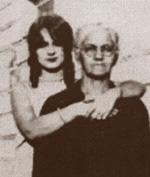
Alice Nutter Scott about 1929 with her youngest daughter, Elizabeth
Elizabeth Grace Scott (1912-1973) - When Elizabeth Scott was born, her father was
50, her mother 45. "Bess" was indeed the baby of the family, but as she grew into a beautiful
young woman with a great intellect, she became the darling of the family. Many of her brothers
and sisters held great hopes for her. Later, in middle age, Bess began writing a journal which still
survives. Like her sister Rose's work "Mother's Chicken", it chronicles much of her life through the
Great Depression, World War II and beyond. In Bess' work though, the retrospective portion (prior
to the 1950s) is somewhat telling in the parts she omits. She is very careful to "go easy" on her
father. She doesn't discuss the years immediately before her marriage when she, alone, was at
home with her parents and when she was Wes' care-giver for some time as her mother adjusted to
her blindness. She does rebuke herself for her perceived lack of initiative in not finishing business
college. She records nothing of her meeting or courtship with Willard George Peters (1910-1959),
whom everyone called "Stub", except that they were married at Sidney, Nebraska on 14 November,
1931. In fact, they had met formally at a dance several years before but had flirted with each
other in high school where Bess was a cheerleader and Stub played center on the basketball team.
Bess writes vaguely about the difficult times during the first two years of their marriage noting only
that they lived with "others" in Colorado. She and Stub headed for California in 1933 where their
only son, Scott, was born in a home they shared a home with Bess' sister Ruth and her husband.
Thereafter, they briefly returned to Holyoke, Colorado, where Stub's parents lived with a view to
taking over Stub's father's blacksmith business. However, they left for Southern California once
more and settled in Temple City and then Victorsville in the desert. Like so many of her siblings,
Bess, Stub and their son, Scott eventually went to Oregon where work was more plentiful in 1941.
Stub worked in Lapine, near Bend, Oregon for a while. In 1946, the Peters' once again followed
many of the family, this time to the Coeur d'Alene, Idaho area settling in Post Falls. Except for a
brief time in 1950 when Stub's work took him to Glenrock, Wyoming, and another period when the
returned once more to Holyoke, Colorado, Stub and Bess made their home in Post Falls for the rest
of their days. Bess' narrative reveals no sense of adventure about any of these times such as was
found in her sister Rose's narrative. Rather, Bess seems to characterize these years as a succession
of events that simply happened to her and her family, often far outside their control or even liking.
Stub died suddenly on 27 September, 1959 from his second heart attack, five years after his first
one. Since Bess' sister Rose had been widowed just over two years before, the sisters found it
mutually advantageous to move in together in 1960. They looked out for each other and developed
a far closer relationship than they had ever enjoyed as youngsters. In her widowhood, Bess worked
for a time at the Lake Medical Center with her sister Rose, but found it unrewarding, difficult,
dangerous and exhausting. After other jobs she finally found work in the office of a dentist in Post
Falls which she enjoyed and found challenging. Once her son graduated from the University of
Idaho, he moved to New York almost immediately, married and began a family. Though he
regularly encouraged his mother to move to the New York, Bess could simply not imagine living on
the east coast. She and her little family had to make do with her fairly regular, almost annual visits
until Bess suddenly died of a stroke on 31 December, 1973 at the age of 61. Until recently, Bess'
only son, Scott Willard Peters (born 1934) lived in Potomac, Maryland with his wife Nancy Rose
Vasconcellos-de-Monge, a native of Ecuador. After graduation from the University of Idaho, Scott
joined the United States Army and worked in public relations at West Point. He moved to New
York City in 1961 and pursued a career in news reporting, for many years with United Press
International, there and in the Washington DC area after 1972. His elder son, Mark David Peters
(born 1962), lives and works in real estate in Miami Beach, Florida and is unmarried. Younger son
Kevin Scott Peters (born 1967) is also unmarried and lives in Frederick, Maryland working in
surgical veterinary medicine. Daughter Jennifer Elizabeth Peters Todd (born 1965) owns her own
business and has recently relocated to Texas. She has three children. Scott Peters and his wife sold
their home in Maryland in 2004 and joined their daughter, son-in-law and grandchildren near
Austin, Texas.
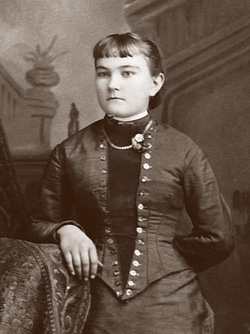
Emma Jane Nutter
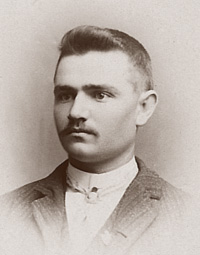
Robert William "Will" Hogg
William and Dinah Nutter's tenth child (seventh still living) was the first one born on the Nutter
homestead following them settling for a second time in Nebraska. She was born on 10 May, 1870,
and was recorded as Emma Jane Nutter when the census enumerator took the family information
just over a month later. Her mother called her "Jane" throughout her life. Everyone else called her
"Jennie".
Like her siblings, Jennie was educated in the school at nearby Shelton and eventually taught
school herself in District 8 of Buffalo County. It was during that time she met a fellow teacher
named Robert William ("Will") Hogg in 1892. Will had just returned from two years in Oregon. He
had come back to Nebraska in the autumn of 1891 to help his ailing father run his sorghum factory.
He then began teaching locally in Buffalo County after his father recovered. In no time at all after
they met, Jennie was smitten with Will Hogg and so they had much in common; Will Hogg was also
smitten with Will Hogg. Nevertheless, they made a handsome couple and were married on New
Year's Day, 1893 at Jennie's parents' home; the octagonal house on the Nutter farm between
Gibbon and Shelton, Nebraska.
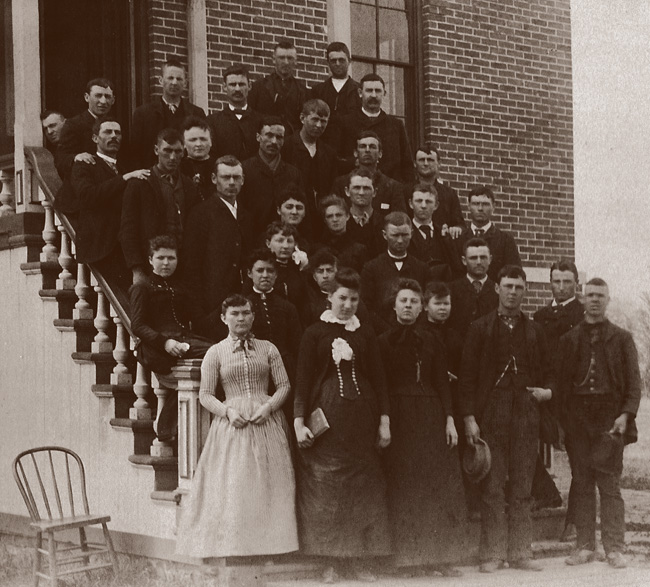
Jennie in light dress at the lower left. Will Hogg at the right in the 2nd row.
Will Hogg (1869-1952) had been born in Butler County, Pennsylvania just six months before
his parents, John Alexander Hogg and the former Margaret Hall, went across the country and
homesteaded near Rippie, Iowa. Both of Will's parents came from Irish families which had been in
the United States for just a couple of generations. The Hogg family stayed in Iowa just ten years
before moving on to Buffalo County, Nebraska where they settled and prospered. Will Hogg had
begun farming for his father when he was ten years old and attended school intermittently. This
was not problematical though as Will was a quick study. He eventually attended an agricultural
college from 1887 to 1890 after which time he borrowed fifty dollars and moved to Oregon where
he taught school for a year. His parents had called him home to Nebraska when his father was
taken very ill. It was during his brief tenure as a teacher in Buffalo County that he met and married
Jennie Nutter.
Will and Jennie had only been married a few months when Anna, the wife of her older brother
John Nutter, died. John was left with five young motherless children to raise. It was Jennie who
stepped into the breach along with her sister, Louise Nutter, to care for the little ones until John
remarried on Christmas Day, 1893. These events laid the basis for an enduring close relationship
between Jennie and these children along with their new step-mother (also named Jennie) who
happened to be close to the same age as Jennie Hogg.
The young couple leased some farm land in Buffalo County for the first two years of their
marriage, but a drought in 1894 wrought havoc on established farmers let alone those just starting
out. Will then worked for another farmer for a couple of years for twenty-five dollars a month.
They saved enough for a down payment on farm along the Platte River costing four thousand
dollars. During this time, Jennie gave birth to their eldest son, John Glenn Hogg, on 5 May, 1896 at
her parents' home. A little over two years later, on 7 December, 1898, Jennie gave birth to another
son, Ronald Valentine Hogg, at her brother John Nutter's home on Fort Farm Island.
As Jennie and Will Hogg raised their two boys, Jennie monitored the growing difficulties at her
brother John's home. Jennie's "new" sister-in-law Jennie was, to say the least, challenged by her
growing family; four children of her own, five step-children and a poorly behaved husband. When
Jennie and Will Hogg decided to move to Oregon in 1904, they offered to take with them eighteen
year old Herbert Nutter, John's oldest son. All parties seemed amenable so the Hoggs sold their
farm along the Platte and settled in West Salem.
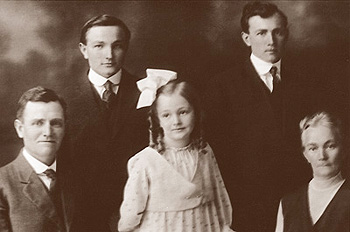
The Hogg family about 1916; Ronald and Glenn at the rear; Will, Margaret and Jennie in front.
The Hoggs bought a farm in Oregon along the Williamette River. Success came quickly and
they built a beautiful home overlooking that river on a farm that eventually included 700 acres.
About 50 acres were set aside as an orchard where they grew cherries, prunes, walnuts, apples and
peaches. Most of the farm produced small grains; corn, clover, rape, alfalfa, oats and barley. They
also had 20 Jersey Cows, Poland China Hogs, Hampshire Sheep and White Rock Chickens.
The Hoggs also had another addition to their family after moving to Oregon. Margaret Diana
Hogg was born 28 September, 1907 and named after each of her grandmothers.
The Hogg family developed into a finely-tuned machine with almost all of its energy directed to
the good of the massive farm. The Hogg sons attended Oregon Agricultural College at Corvallis,
Oregon but each returned home after earning a degree to apply their augmented expertise at the
family farm.
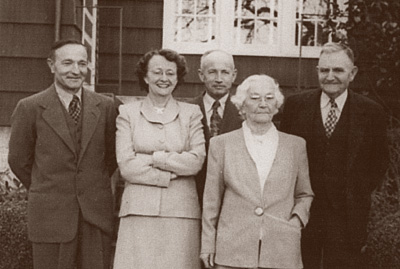
The Hogg family in 1951. The parents, Will and Jennie, are at the right. At left are their
children, Ronald, Margaret and Glenn.
After the family's farm, Will Hogg’s passion during his life in Oregon was promoting
Cooperative Agricultural Organizations. He was a charter member of the Salem Fruit Union and a
Co-op Creamery. In 1932 he formed the Polk County Farmers Union Cooperative Oil Association
and was later elected its Director and Secretary-Treasurer. In 1934, he became director of the
Pacific Supply Cooperative and the Williamette Cherry Growers Cooperative.
Not surprisingly, the farm generated enormous wealth for the Hoggs. Unfortunately, an attitude
developed within the little family which made each member of the Hogg family suspicious of any
romantic ties. The insulting premise for this was the belief that any relationship with the younger
Hoggs had to spring from a desire by some "outsider" to enjoy a share of the family's wealth.
While the parents and the three children were all quite sociable, any romantic liaison among the
children was generally viewed skeptically and was summarily sabotaged. As a result, the little
family grew old together, mutually dependant, steadily wealthier and locally renowned. Will Hogg
even ran for Senator but lost in a close election.
In 1949, Will Hogg suffered a stroke while operating a power lawn mower. Although he was
eighty years old at the time of the incident, it was only then that he retired from work on the farm
and from his active membership on various agricultural cooperative boards. He had actually almost
fully recovered from his first stroke when a second stroke landed him in a Salem hospital on 17
May, 1952. He died the next day.
Jennie survived Will by almost seven years and enjoyed relatively robust health. She died on
16 April, 1959 in a Salem, Oregon hospital just a month short of her eighty-ninth birthday after
being ill for less than two months. She was buried next to Will at Belcrest Memorial Park in
Salem.
The Children of Jennie Nutter and Robert William Hogg
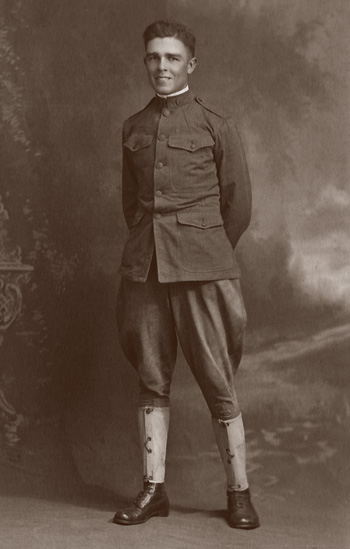
John Glenn Hogg in Americus, GA. Souther Field in Americus was a primary training airfield
and an aviation supply depot in WW I.
John Glenn Hogg (1896-1985) - who was always called by his middle name, was
born in his maternal grandparents' octagonal house between Gibbon and Shelton, Nebraska. He
moved with his family at the age of eight to Oregon and rarely returned to the state of his birth.
After graduation from high school, he was drafted into service during World War I and returned
home to Oregon after the Armistice to attend Oregon Agricultural College (now Oregon State
University) at Corvallis. He graduated in 1922 and attended business college thereafter. For the
rest of his life, he worked the family farm, first with his father, then with his brother. He never
married. He died at the same age as his mother, (just before his eighty-ninth birthday) from cancer
on the 23 February, 1985. His body was donated to science.
Ronald Valentine Hogg (1898-1994) - was born in the home of his Uncle John Nutter
at Fort Farm Island. He was so young when his family moved from Buffalo County, Nebraska to
Oregon, that he had no recollection of his years there. He attended Oregon Agricultural College at
the same time as his older brother and graduated a year later than Glenn in 1923. Ronald was a
talented farmer and a shrewd businessman and was recognized across the United States as an expert
judge of sheep and sheep herds. His expertise was in great demand for decades. Well into his
forties, he enlisted and served in the US army during World War II. He never married. During his
later years, he endured the surgical removal of his colon due to cancer. He died of a cerebral
hemorrhage on 14 September, 1994 at the age of ninety-five.
Margaret Diana Hogg (1907-2005) - lived in the same home in which she was born,
overlooking the Williamette River. She was a retired music teacher, specializing in piano theory.
She had studied both at Portland and Salem many years ago and had a studio in Salem for many
years. Her family's wealth has ultimately been concentrated into her hands, allowing her to hire
personal care givers in her later years. In tandem with her relatively good health, Margaret
continued to live on her own as she passed into her late nineties. Like her brothers, she never
married. The family's estate passed to Oregon State University as this final chapter in the story of
this solitary branch of the Hogg family played out.
Benjamin Franklin Nutter was born 22 April, 1872 at the Nutter homestead alongside the Wood
River, northwest of Shelton, Nebraska. He was the thirteenth child of his parents, the eighth one
living and the first son to survive infancy since his elder brother Will's birth almost thirteen years
before.
A story survives that, when he was a boy, he was called "Ben" and didn't care for it much.
In his young mind, "Frank" - from his middle name of Franklin - sounded manlier. His father
offered to call him by that name and he remained "Frank" for the rest of his life. Frank's father
thought there was merit in the little exercise. When Frank's youngest sister was born, she wasn't
even named until she was old enough to select a name for herself.
Frank went to school with his siblings in the facility above the Oliver brother's store in the town
of Shelton. The last few years of his education were in a newer schoolhouse built in 1882. As a
young teen, Frank was a bit pudgy, but as he assumed more duties on the family farm, the baby fat
melted away. As he approached his majority, he stood five feet seven and had a muscular, toned
body.
In the decade following his tenth birthday, Frank's older siblings married and began families of
their own. Some of the nieces born during this time had fond memories of their young uncle
Frank. They recall him being a handsome, high-spirited young man, inclined to joke, tease and
play with the young ones. These memories contrast sharply with the impressions of Frank later on
in his life.
Frank learned plenty and quickly about farming, mostly from his next eldest brother, Will,
whom he greatly admired. He was also a quick study in carpentry as he assisted Will, their father
and others during the building of the octagonal house on the Nutter farm when he was fifteen years
old.
Early in the 1890s, Frank's father, who was into his sixties, began relinquishing management of
the family farm. Frank's oldest brother, John, had married and bought quite a bit of farm land in
his own right some years before and was prospering nearby. His other older brother, Will, married
late in 1891 and bought some nearby farm land with help from their parents. These events set up
Frank and his younger brother Mirabeau as "heirs apparent". Naturally, that scenario would not
play out until after the death of their father, but in a real sense, the Nutter land was managed and
farmed by the two brothers from the mid-1890s onward for many years
As Frank's father became more and more disabled by what was probably Parkinson's Disease,
Frank's mother became more overtaxed by her duties of running the household and acting as nurse
to her husband. Frank's younger sister Louise introduced Katie Link to the family as someone who
may be able to ease Dinah's burden.
Katie (nee Katharina) Link (1869-1944) had been trained as a nurse in nearby Hastings,
Nebraska. Of course, training for nurses in those years was mainly practical, not clinical.
However, practical nursing care was precisely what Frank's father, William Nutter, needed. It was
clear that his decline was inevitable and that "only" palliative care was required. Frank's mother,
Dinah Nutter, could scarcely believe the diminutive Katie Link was capable of the heavy lifting
required in William's care. Katie simply demonstrated she was quite up to the job.
Katie was the only one in her family who was not married and she was heading toward her
thirtieth birthday when she took on the nursing position at the Nutter home. Family members
outside the octagonal house claim that Katie was less-than-subtle in her pursuit of one of the Nutter
boys - Mirabeau. He demonstrated a similar lack of subtleness in rebuffing her. Those same
family members note that Frank was an easier target. By the spring of 1899, Katie was
pregnant.
At first Frank declined to marry Katie. He was contemplating investment ventures and possibly
relocation with his brother Will and his family. Will had Frank convinced that Texas, or perhaps
even New Zealand or Australia beckoned to them. In addition, Frank’s brother John urged Frank to
do whatever was necessary to avoid the marriage.
Katie then made a shrewd move. She approached the family matriarch, Dinah Nutter. She
explained that Mirabeau's disdain for Katie was well-known. If Frank did not marry Katie and
thereby acknowledge the child as his, people in the area might jump to the conclusion that the
actual father of the child was the other man in the house; her patient and Dinah's husband, William
Nutter. After all, it was well-known that Katie was providing him with the most personal kind of
care. Dinah suddenly weighed in on Katie's side.
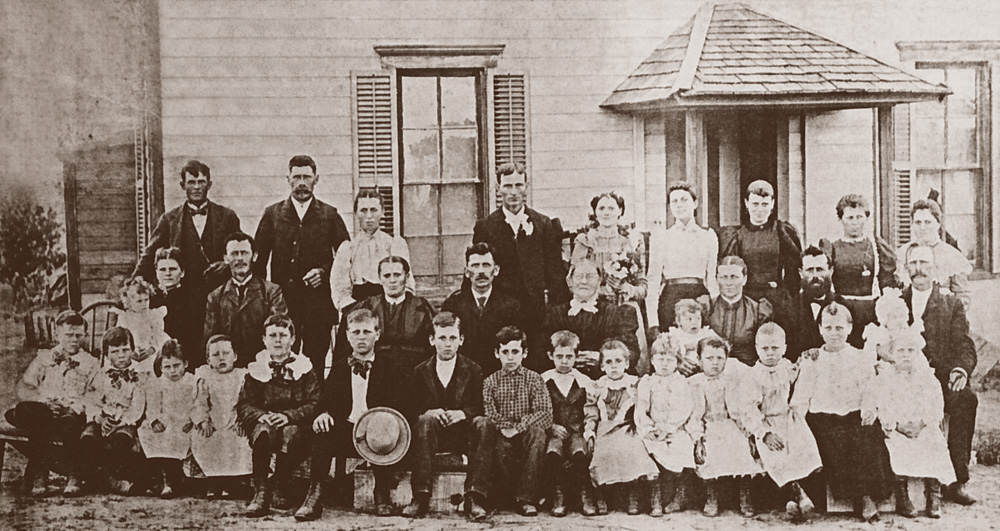 Wedding of Frank and Katie Nutter in 1899
Wedding of Frank and Katie Nutter in 1899. Others in the photo are Katie's family; her mother,
brothers, sisters, their spouses and children.
Standing L-R: Fred (foster son of Gusrav Link),
William Heusel, Sophie (Link) Heusel, Frank Nutter, Katherine (Link) Nutter, Emma Heusel Miller,
Katherine Link Swanson, Marie Link rose, Fredericka Link Urwiller.
Seated: Katharine Rapp Link,
Jacob Fred Link, Mary Link Spahr, Fred Spahr, Grandma Link (Maria Magdalea Sautter), Christiane Katherine
Fugar Link, Gustov Link, Samuel Urwiller.
All children: Carl Link, Albert Link, Sophie Link Urwiller,
Emma Link Lange, Allie Heusel Haug, Henry Heusel, Gustave E. Link (Gus' son), William Spahr, Herman
Spahr, Fredrick Spahr, Lena Spahr, Matilda Link Everet, Wilhelmenia "Minnie" Link Woehrele, Amelia
Link Whitson, Rose Link Wens, Lydia Link Hughes, Esther Urwiller Basnett, Rose Urwiller Knerl.
At half past one o'clock on Friday, 9 June, 1899, in front of 100 guests, a stoic Frank Nutter
waited in the downstairs parlor of the Link home in Luce, Nebraska. Katie descended the stairs
behind five bridesmaids, wearing a bunch of white carnations on the bodice of her wedding dress
and a wreath of orange blossoms in her hair. The couple exchanged vows before the Reverend
Hempkin of Ravenna. Some say, they never saw the fun-loving, animated side of Frank Nutter's
personality ever again.
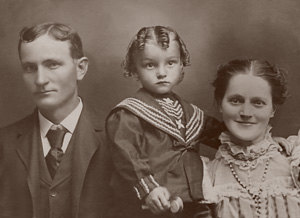
Frank Nutter, his son Lyman and wife Katie in 1901.
In fairness, Frank could have done much worse. Katie was a beautiful, hard-working, pleasant
and petite woman. A native of Mundelsheim-am-Neckar, Germany, she had immigrated with her
family in 1885 to an area north of Gibbon and Shelton, Nebraska in Cherry Creek Township. That
area of Buffalo County had been heavily settled by German speaking immigrants who, like the
Link family, came to the area after a brief layover in Michigan. Her father, Johann Jakob Link
(1825-1885) had died soon after their arrival in Nebraska leaving her mother, Maria Magdalena
Sautter Link (1831-1917) to finish raising the six living children (out of a total of twelve). Though
Katie was the last of her family to marry, she had married at least as "well" as her sisters Mary
Spahr, Sophia Heusel and Fredericka Urwiller and, unlike each of them, she had married outside
the "Bohunk" (ie. German speaking) culture with the Englishman Frank Nutter.
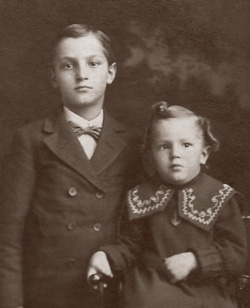
Frank and Katie Nutter's two sons: Lyman on the left, William on the right. About 1907.
Frank and Katie Nutter's son was born at the Nutter's octagonal house on 17 January, 1900.
Katie's alleged affection for Kaiser Wilhelm was possibly indicated by the child's given names of
Lyman Karl Wilhelm. The child was very small - supposedly close to two pounds at birth. Family
lore credits Lyman's survival with Katie placing the scrawny infant in a pan of warm milk on or
near the family stove.
When the census enumerator called at the Nutter's octagonal house in June, 1900, there were a
few interesting points in his data. William Nutter was still noted as a "farmer" and owner of an
unmortgaged farm even though he was totally disabled at that point. Frank, living in the same
house, was also designated as a farmer and owner of an unmortgaged farm. Younger brother
Mirabeau was simply a "farm-hand".
The health of Frank's father continued to decline until his he succumbed on 13 May, 1906.
Three weeks later on 2 June, Katie gave birth to her second son, William Benjamin Franklin Nutter,
named for his recently-deceased grandfather and father. This child was also very small when he
was born and was supposedly also immersed in a pan of warm milk on or near the stove for long
periods. Who knows if this seemingly bizarre practice had any merit? Both boys did live more
than three quarters of a century.
During these years Frank Nutter acquired an eighty acre piece of land immediately northeast of
the Nutter's home quarter section. He built a comparatively large and nicely finished wood frame
home on the property where he and Katie made their home for the rest of their lives. On this same
land, between Frank and Katie's house and the octagonal home, stood District 8 School where most
of the more extended family would attend school over many decades.
In the years following his father's death, Frank and his three brothers (John, Will and Mirabeau)
bought land, sold land and swapped acreages. The net effect of all of these transactions was that,
by 1919, Frank owned the eighty acres where he and Katie made their home, eighty more in the
section west of the octagonal house and an entire quarter section (160 acres) west of that plus
another sixty-two acres detached and east of all these acreages. None of these land holdings,
substantial as they may have been, included the original Nutter farm which was then totally in
Mirabeau's possession.
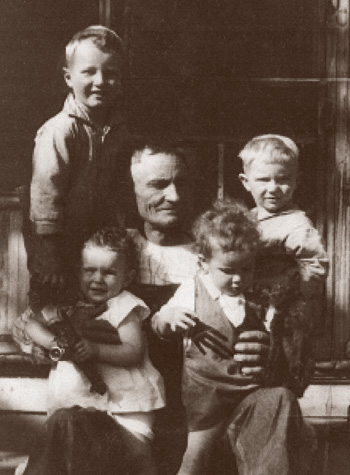
Frank Nutter with his grandsons Norden, James, Bill and Gene in the 1930s.
Frank was a very efficient and hard working farmer. Years later, it was his "thrift" which
would be touted as his most memorable quality in his obituary. In fact, family members would
recall him as being as "tight as bark on a tree". While there is substantial evidence he was a shrewd
businessman, a very successful farmer and very, very "careful", there is also evidence that he
actually spent considerable sums on items which were not really life's necessities. In fact, within
the context of the times, they could be considered luxuries.
Frank and Katie Nutter's home was one of the first in the area with hot and cold running water.
And, well before the Federal Rural Electrification Project brought electricity to virtually every home
in the state, the Nutter's spent a substantial sum electrifying their home.
Early in the 1920s, Frank and Katie also bought an organ which occupied a prominent position
in their parlor. Yet no one can ever recall either of them playing it. (Katie's sisters may have. If
so, why wasn't the organ in one of their homes?). Also, a Murphy Bed was installed in the dining
room for those times when Katie was ill and/or otherwise infirm and "unable" to remain
continuously ambulatory throughout the day.
Frank also had a number of automobiles. Though he always used draft animals on the farm, he
ventured into operating motor vehicles early on though not always with great skill and comfort. He
bought at least one car brand new from a dealership in Shelton - a Ford Model T. The salesman
gave Frank instructions on its unique method of operation (for it lacked a clutch in the traditional
sense) while standing on the car's running board as Frank drove.
Frank heard there was an opportunity for thrift in fuel consumption if he were to shut off his
car's engine and coast when going downhill. He availed himself of such opportunities when taking
Katie to visit her sisters in the hills north of Shelton and Gibbon. His boys were always transfixed
by the bulging veins and tendons in Frank's neck as their normally stoic father gripped the steering
wheel for dear life while the car hurdled down those steep hills.
Earlier than many of his neighbors, Frank Nutter's home was equipped with a telephone though
it was installed without his approval or knowledge. His son, Bill, arranged for it to enable regular
communication between Katie and her sisters. The phone was in the home for some time without
Frank actually noticing it. It was mounted right behind Frank's regular seat at the dining room. The
first time it rang during a meal, Frank nearly had to be peeled off the ceiling.
Those who were only children when they knew Frank seem to universally remember him a
"stern". Those who were adults say he was "sad and quiet". No later anecdotes seem to survive
about the lighthearted side of Frank's nature remembered by Frank's nieces before his marriage.
The logical conclusion therefore must be that the scheming, foreign bride he took broke his spirit
and trapped him in a forty year long melancholy marriage. The facts may not support this.
Over all, the extended Nutter family was not subtle about their contempt for Katie Link - in fact
most continued to poignantly call her "Katie Link" throughout her entire marriage to Frank. While it
is clear she was pregnant at the time of her marriage to Frank, it is also clear she did not become
that way by herself and, perhaps the characterization of Frank as a victim, "trapped" as it were by a
wily woman should, at the very least, be re-examined. The Nutter family was never likely to accept
Katie as she was an older woman, one of the "hired help" and who betrayed her "foreign" origins
every time she opened her mouth. There is also anecdotal evidence that she was disinclined to
provide Frank Nutter with a house full of children as her sister-in-laws had.
Katie was an intensely religious woman married to an atheist from a family of atheists.
Interestingly, she was so successfully dismissed as a religious zealot that none of her family and the
extended Nutter family was even able to identify the religious denomination under which she
practiced her zealotry. For the record, she was raised German-Lutheran ("Evangelisches") and was
buried as a Presbyterian
That is not to say Katie wasn't a religious zealot. One of her grandsons recalls approaching her
repeatedly for some information about what her life was like back in her native Germany. On each
occasion, the conversation invariably turned to religion and the boy ended up in possession of
several religious pamphlets and precious little information about Katie's homeland.
The Nutters always said "Katie enjoyed ill-health her entire life". Her immediate family does
not deny this. An injury to her spine while she was performing some work as a nurse did cause her
continued discomfort throughout her adult life. As she grew older she walked bent-over and with
some difficulty, making her appear even shorter in stature than she already was. She also had “a
bad heart" as she got older and that, in fact, proved to be her undoing.
Frank's health was nothing but robust. Though Katie is universally credited as a very good
cook, the pudginess of his youth never returned - he remained very muscled and fit. He worked
very hard on his farm and was very fastidious about his farm equipment and his tools. He
appeared to enjoy solitary work like his father before him, but was never driven by the kind of
intellectual curiosity his father and brothers were known for. Unlike his father and brothers, he
never entertained the idea of an early retirement.
One day in the spring of 1939, while Frank was engaged in what is called "sheep dipping", he
accidentally thrust a large splinter of wood into his hand at the base of his thumb as he lifted a
sheep over a wood panel. As was his custom he did his best to remove the splinter once he
returned to the house. However the wound became infected and his hand began to swell. He spent
his sixty-seventh birthday (Saturday, 22 April, 1939) in great pain. The pain and swelling was so
bad by the next day, the family insisted on summoning a doctor to the house against Frank's
wishes. When the doctor called at the house, he assessed that Frank, at the very least, needed to be
hospitalized.
As Frank headed out of the house with the doctor, he is said to have stopped before opening
the car door to take a long, circumspect look around his farm. It seemed as if, at some level, he
knew he was looking at his land for the last time.
In the General Hospital at Kearney doctors began treatment of the infection with sulfa. It was
also their opinion that his hand, certainly septic and possibly gangrenous, should be amputated.
Frank refused, noting he had come into this world with his hand and intended to leave the world
with it attached. Early the next day, 24 April, 1939, he left the world as he intended. It is doubtful
that the amputation would have actually saved his life as the septicemia was quite advanced by the
time of his arrival. He was buried at the Riverside Cemetery north of Gibbon 26 September,
1939.
Katie fared poorly after Frank's death. Her son Lyman, his wife and two (eventually three)
sons lived with her and she gradually became less and less capable of assisting in the day-to-day
running the household
By 1942, Katie's adopted country was again at war with her native country. Having been the
subject of much gossip for her alleged affection for Kaiser Wilhelm during the First World War I,
Katie felt it necessary to affirm her allegiance by purchasing small American flags, affixing them to
her clothes, displaying them around her home and distributing them to visitors.
Katie's heart disease finally proved fatal to her on 6 January, 1944 the day before her seventy-
fifth birthday. She was interred next to Frank a few days later.
The Children of Benjamin Franklin Nutter and Katharina Link
Lyman Carl Wilhelm Nutter (1900-1975) - was born on 17 January, 1900 in the
octagonal house belonging to his Grandparents Nutter. He graduated from Shelton High School in
1919 after which time he continued to assist his father with his farm work as he had done since
childhood. He met Lorena Wynn (1903-1976), whose family lived in Missouri, though she herself
was a native of Washington State. The couple was married in Kirksville, Missouri just a week
before Lyman's twenty-sixth birthday. Lyman's brother, William, married two months later, and, in
an odd symmetry, the brothers fathered two sons each in the early years of their marriages,
followed a decade and a half later by another son each, ultimately following the symmetry to the
end when each of the brothers died in the months following their seventy-fifth birthdays. After
their marriage, Lyman, Lorena and their boys lived in a small home on his father's land so
Spartan that it had a dirt floor. Late in the 1930s, the young family joined Lyman's widowed
mother in the family home and retained it as their own after Katie's death in 1944. By the time of
his death in the Kearney Hospital on 28 August, 1975, Lyman had spent his entire life within the
view of the octagonal house in which he was born. He was buried at the Riverside Cemetery north
of Gibbon. Lorena joined him there the next year, a few months after what would have been their
golden wedding anniversary. Eldest son Norden Gale Nutter (1926-2007) and middle son Franklin
James Nutter (born 1927) farmed together for years, neither marrying until about their fiftieth
birthdays. Norden served as a corporal after World War II in Okinawa and was in the reserves
thereafter. He attended Kearney State College earning a Liberal Arts degree specializing in
journalism. A retired farmer, Norden lived south of Gibbon. His wife, Ruth Krovas Campbell
(1927-2004), had children by a previous marriage. Franklin James Nutter goes by the name "Jim"
and lives on some of the land his father and grandfather farmed with his wife, the former Nadine
Ondrak. Lyman and Lorena's only grandchildren are the three children of youngest son Denten
Loyst Nutter (born 1943). He and his wife, the former Janice Basnett, also make their home on a
piece of land from the old family farm.
William Benjamin Franklin Nutter (1906-1981) - was only sixteen years old when he
finished school and began teaching. He and Susie Myrtle Baker (1906-1997), a native of Garwood,
Texas who was raised in Columbus, Texas, were both only nineteen when they married at
Hollinger, Nebraska on 21 March, 1926. For nearly thirty years they farmed some of the land on
which "Bill" had worked for his father as a boy. Early in their marriage, there were many lean
years for the Nutters and others in Nebraska. There were times when Susie had to return to her
native Texas for extended periods with the kids simply to ensure everyone had enough to eat. But
eventually they persevered. For more than two decades, Bill was at the helm of the District 8
school board and took to heart his responsibility to ensure quality education in the district. He also
maintained high visibility in the community as a member of the Masonic Lodge, the Shriners and
the Rotary Club. In 1955, Bill and Susie retired from farming and went into the motel business in
Texas and elsewhere and finally owned and operated a motel in Beloit, Kansas. Bill died of a heart
attack in Madison, Wisconsin on 15 July, 1981 while visiting his son and his family. Susie outlived
Bill by more than sixteen years. Though she contributed her part to the farming and motel
endeavors, she also became a licensed practical nurse and worked as such while they lived in
Nebraska, Colorado, Iowa and Kansas. In retirement, Susie returned to Gibbon where she lived in
her own home well through her eighties. Ill health eventually required that she move to a health
care facility in Columbus, Texas where she died on 21 December, 1997, ten days short of her
ninety-first birthday.
Bill and Susie Nutter's eldest son, William Robert Nutter (1927-1996) married Helen Fling,
another native of Garwood, Texas in 1950. After the birth of their first child, a son, the young
family moved from Kearney, Nebraska to Lake Jackson, Texas in 1954. There, two daughters and
another son were born. Sadly, their eldest son died at the age of ten in a drowning accident there.
Eventually, Bill and Helen separated and managed a rather amicable divorce. Bill's continuous
employment as a chemical technician during their life in Texas was likely the reason he contracted
lung cancer which proved fatal to him just before his seventieth birthday. Helen was with him at
the end. Only their two daughters have married from whom there are three grandsons.
Bill and Susie Nutter's middle son Gene Douglas Nutter (1929-2004) was born in Columbus,
Texas but grew up near Gibbon, Nebraska. He graduated from high school there, graduated from
the University of Nebraska at Lincoln and worked for a time thereafter at the Bureau of Standards
in Washington DC. He returned to his alma mater for his post-graduate work in physics and
mathematics. He married fellow student Mary Ann Souder there on 9 June, 1956 (his 27th
birthday) and received his Master's degree the next day. Gene and Mary Ann lived in Southern
California for the next eleven years where their son and daughter were born and where Gene
worked as a research engineer. In 1967, Gene and his family moved to Madison, Wisconsin where
he worked as a research engineer, serving as assistant director at the University of Wisconsin's
Instrumentation Systems Center, which he helped establish, and co-authored a book which has
come to be known as the "bible of radiation thermometry". Gene took a disability retirement in
1988 after more than 18 years of chronic health problems. For the next seven and a half years,
Gene and his wife traveled the United States looking for the ideal retirement location deciding
ultimately to settle in extreme western North Carolina overlooking Lake Chatuge and the state line
with Georgia. Their son Johann is a senior software engineer with his own business in Longmont,
Colorado and he has a daughter and two granddaughters. Their daughter Kathleen is a student at the
University of Wisconsin, is married and has a son.
Bill and Susie Nutter’s youngest son is Douglas Robert Nutter (born 1943). He was born in
Kearney, Nebraska where he still lives. He and his wife, the former Dorothy Volpat, have a son
Brian (born 1972) and a daughter Deborah (born 1975).
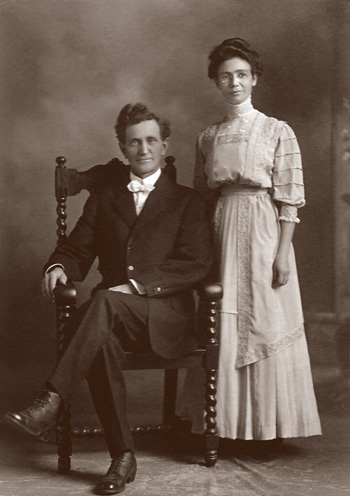
Mirabeau and Lizzie (Hogg) Nutter on the occasion of their wedding in 1910
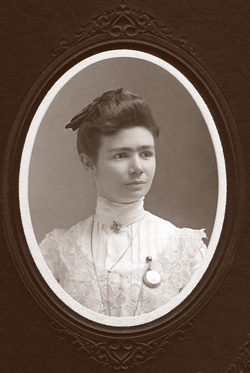
Elizabeth Amanda (Lizzie) Hogg
Sometimes William Nutter was brilliant. Sometimes he was a great thinker with a fresh view of
the world and revolutionary ideas. Sometimes, but not often, his wife Dinah found it necessary to
"rein him in". One has to wonder why she didn't do so when he proposed to name their child
"Mirabeau Diogenes" after his birth on 18 December, 1875.
Perhaps she was simply tired. Just as she passed her forty-first birthday in June, 1875, Dinah
may have noted the fact that the previous three years and three months had been the longest she
had ever gone during her marriage to William without having a baby. It would probably be about
that same time she determined she was then pregnant with their fourteenth child. The eight children
still alive were all still living with them in their twelve by eighteen foot log home along the Wood
River.
Mirabeau Diogenes got his name as a result of his father's admiration for a French Statesman
(Honore Gabriel Riquetti, Count of Mirabeau) and a Greek philosopher (Diogenes). It seems as if
everyone in his family got used to calling him Mirabeau, but his first foray outside the family didn't
go well. When he first began attending District 8 school in session upstairs from Oliver's store in
Shelton, he was registered as "Mary Bo" Nutter in the school records. We all know how cruel kids
can be.
Possibly Mirabeau's revenge was that, by the time he was a teenager, he was six feet tall,
towering over his mother and sisters and noticeably taller than his father, brothers and most other
men in the area. Additionally, he was muscular and rather nice looking with a strong jaw and a
substantial crop of curly dark hair, both inherited from his mother. In those days he was called a
"natty" dresser, remembered by his nieces as quite a "dandy". There are some who say he was
quite aware of his striking appearance. He wasn't afraid to publicly display his vocal talent and
organized a quartet in which he, his brother Frank, sister Louise and their niece Olive (Ollie) Nutter
(daughter of John) sang at special functions. He also used to call for the square dances in the
neighborhood.
After he finished school in District 8, Mirabeau was sent off to "Normal School" (the 1890s
version of a community college) at York, Nebraska to hone his agricultural skills. At the same
time, he was already acquiring prodigious skills as a carpenter under the tutelage of his elder
brother Frank. Mirabeau had prepared himself well to take over his parents' farm, with his brother
Frank.
At the turn of the century, events moved quickly to place Mirabeau in the circumstances which
would serve him well for the balance of his life. He dodged the advances of Katie Link, his
father's nurse. Instead, his brother Frank married her and began a family. Their father died in
1906 leaving his 160 acres to be divided equally between Frank and Mirabeau. Frank had bought
80 acres northeast of the farm, built a home and moved his family into it. Mirabeau then bought
Frank's 80 acres from the inheritance. By 1908, Mirabeau farmed all of the original 160 acres
owned by his parents and there was only he and his mother residing in the formidable octagonal
house. Over the next ten years, Mirabeau's older brothers would buy, sell and swap pieces of land
among themselves. Mirabeau steadily worked only with his quarter section - his parents' original
farm - though after World War II, he is known to have purchased some pasture land about seven
miles north on which his nephew, Bob Robertson, would later live.
Well into his thirties, "M. D.", (as Mirabeau usually represented himself to those outside his
family), began courting thirty-year-old Elizabeth Amanda (Lizzie) Hogg (1877-1968). She was the
daughter of John Alexander Hogg (1844-1922) and Margaret Hall Hogg (1844-1926) who were
both natives of Butler County, Pennsylvania. Lizzie's parents' families had only been in the USA
for a couple of generations since their emigration from Ireland, though the Hogg family itself was
originally from Scotland. John Alexander Hogg's grandfather, Robert Hogg Senior, had
distinguished himself in his service in the army during the War of 1812. The Hoggs left
Pennsylvania in 1869 and homesteaded near Rippie, Iowa in Poweshiek County east of Des
Moines. Though John Hogg had worked for years as a carpenter in Iowa with his father-in-law,
William Hall, he established a grocery business in the little town of Mitchellville. (It was during this
time that Lizzie was born). When his business failed, John Hogg moved further westward to
Shelton, Nebraska in 1879 where he found employment at the Shelton Mills. He purchased land
which already had a sod house on it and this is the home in which many of their children grew to
adulthood. In 1906 the Hoggs moved to Oregon to the area where elder son Robert William Hogg
(husband of Jane "Jennie" Nutter) had settled two years previously. However, they returned to
Buffalo County in 1908 when they purchased a home and property in the town of Shelton. Lizzie
was married from that home to Mirabeau Nutter on 6 July, 1910.
Mirabeau and Lizzie began their family right away. A daughter, Pauline was born in May, 1911
in the octagonal house. The next year when Lizzie was pregnant again, Mirabeau's mother Dinah
left the growing family to travel for a few months to visit extended family in New England. Upon
her return in the summer of 1912, she requested that Mirabeau have a small house built nearby so
that she could live on her own and leave the octagonal house to the new family. While his mother
visited his sisters in the northwest that same year, Mirabeau, with the assistance of his nephews Bob
and Ben Robertson, built Dinah a small, four-room home in which she lived happily for the rest of
her days.
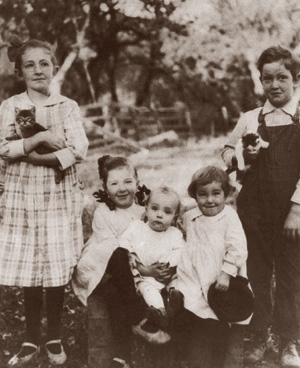
The children of Mirabeau and Lizzie Nutter (1921). (Left to right) Pauline, Elva, Lindley,
Janet and Donavan.
Mirabeau and Lizzie had a son in 1912, twin girls in 1915 (one died at birth), another daughter
in 1918 and a son in 1920. It was just two days after Christmas, 1918, when Mirabeau awoke on a
Friday morning to look out the kitchen window and see no smoke come out of the chimney of his
mother's little house. He ran into her home to find her collapsed on the floor from a stroke.
Mirabeau carried her back into the warmth of the octagonal house where she died the following
Monday.
Sometime during these years, the Nutter homestead acquired the name "Kenmore Farm". No
one knows the origin of the name and it doesn't really matter since no family members used it
much. The specialties of the farm in 1919 were listed as Chester White Hogs and S.C. Brown
Leghorn Chickens. Crops grown for sale were primarily corn, hay and alfalfa. The orchard
yielded plenty of apples, way beyond the personal needs of the family.
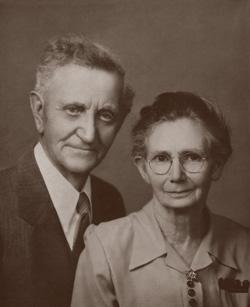
Mirabeau and Lizzie Nutter about 1940
The story of Mirabeau, Lizzie and their family on the Nutter farm during the next two or three
decades was very much like so many of the farmers in that area. There were very lean times
beginning late in the 1920s with the start of the Great Depression and the 1930s were no better with
hot, dusty summers, terrible droughts and poor crop yield.
Mirabeau and Lizzie were both very intelligent people and it should come as no surprise that
most of their children were brilliant as well. They all did well in school, adapted well to the pursuit
of higher education and were heavily encouraged by their parents. No matter how lean times were,
the Nutters did their best to lend their financial support.
However, late in the 1930s, Mirabeau badly injured his leg during farm work. Unable to meet
the day-to-day demands of the farm, Mirabeau summoned his son Donovan from his studies at
Kearney State College. The father didn't recover for months and Donovan never returned to
college. Slowly, Mirabeau began transferring his responsibilities on the farm to his son and, by
1952, when he was nearly 78, Mirabeau "retired"...as much as farmers ever retire.
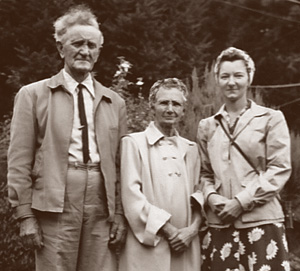
Mirabeau Nutter and Lizzie, and their daughter, Elva.
Mirabeau still gardened two or three hours a day in retirement raising potatoes, onions, squash
and other items for consumption by the family. He also kept and tended his work horses who had
mostly retired with him. The balance of his day was spent in his workshop often indulging what
had always been his passion; carpentry.
Of course Lizzie worked in the house mostly. Canning the yield from her husband's garden
was no small task by itself. Family recall she was an outstanding cook and even a better baker,
often using the wood stove in preference to the "modern" one. She was a doting grandmother,
happily with regular access to her only grandchildren - the six children of her son Donovan who
lived with their parents in a home just east of the octagonal house. For decades the house had been
the "social center" for most of the Nutter family and it remained thus during Mirabeau and Lizzie's
tenure there. Very few Sundays passed without several visitors calling in.
Sadly, late in the 1950s, Mirabeau began to suffer from memory loss similar to what would
now be associated with Alzheimer's Disease. While this was obviously problematical, it was
actually his tendency to wander which finally necessitated his confinement to a nursing home in
Kearney. He retained enough understanding to assess his new circumstances and let his family
know that he despised living in the home. Mercifully, he didn't have to endure his circumstances
for long. He died late in the evening of 7 January, 1960 in his eighty-fifth year and at the same age
as his mother, his sister Ellen, and their aunt Mary Ann. On 11 January, 1960 he was interred at the
Shelton Cemetery.
Lizzie survived Mirabeau by nearly another nine years. She lived to see six great-grandchildren
come along and she enjoyed good health as the years passed. It was trouble with her gall bladder
which proved to be her undoing, usually the problem of a much younger woman. She had surgery
to remove her gallbladder after Christmas in 1968 in Kearney. She did not survive. At the age of
ninety-one, Lizzie died a half century to the day after her beloved mother-in-law, Dinah Ingham
Nutter. She was buried next to Mirabeau.
The Children of Mirabeau Diogenes Nutter and Elizabeth Amanda Hogg
Pauline Elizabeth Nutter (1911-1980) - moved around the country in pursuit of
higher education and her career as a brilliant teacher and professor. After she graduated from
Gibbon High School and after she got her bachelor's degree at Kearney State Teachers College, she
taught home economics for several years at the state agricultural college in Logan, Utah. She
received her Master’s degree from the University of Arizona at Tucson. After that, she attended
Washington University in St. Louis, Missouri and finally received her doctorate in nutrition and
physiological chemistry at the University of Rochester in New York. Throughout her career she
also taught at Kansas State College in Manhattan, Kansas, the University of Utah at Provo and
finally, the University of Nebraska at Lincoln from which position she retired. In the midst of all
this, she married, in 1942, to Thomas Doryland (1914-2002), a student pilot who pursued a career
in aviation. Unfortunately, Doryland may have loved flying but had little affection for regular
employment. Pauline died at 69 from lung cancer. She and Thomas had no children.
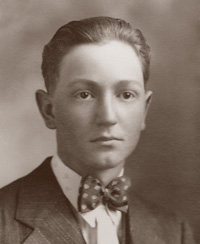
Donovan Hogg Nutter
Donovan Hogg Nutter (1912-1989) - as the only surviving son of his parents,
inherited the family farm. Though he was as brilliant as any of his siblings, his time at Kearney
State College was curtailed when he was required to return to the farm when his father badly
injured his leg. In 1940, he married a local girl named Ramona Emily Major (born 1914).
Together, they had six children whom they raised in a home built just east of the Nutter octagonal
house. Donovan gradually and successfully took over the farm from his father and ultimately, was
able to pass the enterprise onto his son and retire himself.
In retirement, doctors discovered a tumor on Donovan's pituitary gland. Surgery to remove it was
successful. Some in his family believe that the tumor and/or the surgery was somehow connected
with a cancerous liver tumor which developed later and proved fatal to him on Valentine's Day,
1989 in the Good Samaritan Hospital at Kearney. Donovan and Ramona have the only
grandchildren in Mirabeau and Lizzie's line. Eldest daughter Carol Lynn Nutter (1941-1997)
married Roger Hartge (born 1937), moved to Illinois, then Van Wert, Ohio, where she worked as a
lab technician. After a divorce in 1974, she married Franklin Delano Roby in 1981. She died of
leukemia and bone cancer in Lima, Ohio leaving a son and a daughter with Roger Hartge and five
grandchildren. Middle daughter Theda Louise Nutter (born 1947) also moved to Ohio and married
James Marion Potter there in 1969. Her son and daughter were born there and the family still
resides there after some time in New Orleans and Japan during the father's career with the US
Navy. Youngest daughter, Tovey Jill Nutter (1949-1951) died of a brain tumor. Eldest son Steven
Mirabeau Nutter (born 1943) is a retired US Air Force Lieutenant Colonel retired near Abilene,
Texas. With his wife, Kathleen Atchison (born 1946) from whom he is now divorced, he is the
father of a son and a daughter and has two granddaughters. Middle son Craig Emerson Nutter
(born 1944) is now the fourth generation of Nutters farming land near the octagonal house. With
his wife, the former Julene Kay Beck (born 1946), he has one son, three daughters and six
grandchildren.
 USS Philippine
Sea
USS Philippine
Sea - Van Donovan Nutter served on this ship for 5 years during his re-enlistment.
Youngest son Van Donovan Nutter (1954-2012). Van served in the U.S. Navy, 1972-1976,
then he obtained his associate's degree from Central Community College in Grand Island. He re-enlisted
in the Navy in 1986, served eight more years, five of which were at sea on the USS Philippine Sea. He
was a highly decorated electronics specialist. When not at sea with the Navy, Van was stationed in
Virginia. Later, he moved to Jacksonville, Florida then Merkel, Texas
where he lived with his elder brother. With his wife, Kathleen Carol Fredericks (born 1955), he
had two sons and one daughter from whom there is one grandchild. Van and Kathleen were
divorced in 1985. He died in an auto accident in 2012.
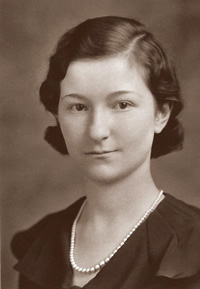
Elva Rae Nutter
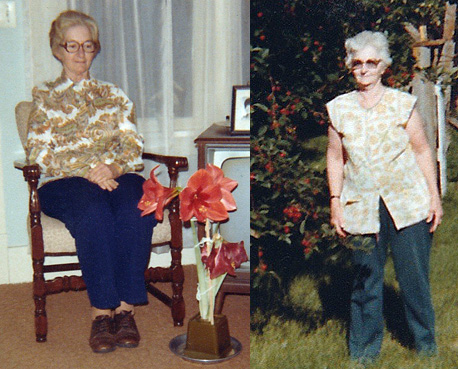
Elva Nutter showing off her flower and cherries
Elva Rae Nutter (1915-2004) and Elna Ruth Nutter (1915-1915) - were twins but
Elna died soon after birth. Elva lived with her parents in the octagonal house most of her life until
1969. She then bought a home of her own near Fairfield, Nebraska. In 1984, she retired from her
long-time position at Baldwin Manufacturing Company in Kearney. A stroke badly disabled Elva,
necessitating confinement to the Good Samaritan Nursing Home in Gibbon where she died from
heart disease in 2004.
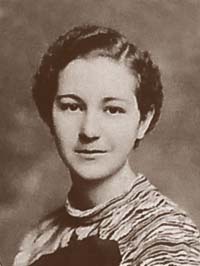
Janet Nutter - Gibbon High School - Class of 1935
Janet Yvonne Nutter (born 1918) - fought significant hearing loss all her life. Early
on she moved to the northwest and was trained there as an x-ray technician. She retired after many
years in that medical field. She continues to live in retirement near Seattle, Washington. Janet had
a companion of many decades who died several years ago.
Lindley Mirabeau Nutter (1920-1925) - was the youngest grandchild of William and
Dinah Nutter, the only one born after their deaths. His death in the waning days of summer in
1925 is surrounded by much family lore. The little boy was discovered, very ill, in the watermelon
patch. Some say Lindley's distress was from appendicitis, some say it was food poisoning.
Whatever it was it very swiftly ended his short life with less than two days having elapsed from
onset of symptoms until his death.
The fifteenth and last child of William and Dinah Nutter (the tenth living) was a daughter, born
at the Nutter homestead along the Wood River on 2 October, 1877. As has been noted in several
places in this book, her parents did not name her and allowed her to select her own name once she
grew up. In the 1880 census and even for the first year or two of her education at the District 8
School, she is listed in the records simply as "Madam".
Calling the little girl "Madam" may sound quaint and English. The truth may be quite different.
In the Lancashire dialect, if one were to refer to a little girl as being "a right little madam", it would
mean the child was assertive, strong-willed and a bit difficult. Is it possible that young Louise
Nutter (as she was eventually known) exhibited rather early on some of the characteristics for
which she was eventually known?
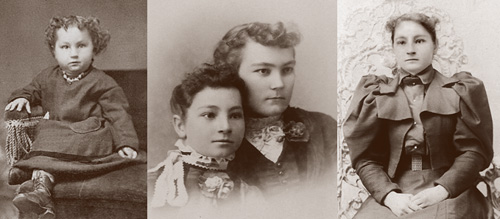
'Madam' Louise Nutter. Center-right is her older sister Jennie Nutter.
As Louise grew up she developed no particularly strong alliance with any of her siblings. She
did, however, enjoy a very close, sister-like relationship with her niece Olive, the eldest daughter of
her eldest brother, John Nutter and, to a slightly lesser extent, several of Olive’s younger sisters.
"Aunt" Louise was only just a little over four years senior to "Ollie". It's likely this close
relationship between Louise and her nieces arose in 1893 when the mother of these little nieces
died suddenly. It is known that Louise, her older sister Jennie and their mother stepped in to care
for the little girls for most of that year and intermittently thereafter.
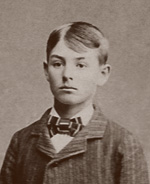
Reuban Miller (about 1890)
After Louise finished her education at the District 8 School, she found a teaching position near
Sodtown, almost fifteen miles north of her parents' home. As noted before, this was the area in the
hills where the "Bohunks" (ie. the German speaking immigrants) lived.
It was during this time that Louise met Katie Link. She brought Katie home to the octagonal
house and introduced her to the family as a prospective nurse for her ailing father. The rest, it is
said, is history. It was also during this time she met Reuben B. Miller (1878-1956).
Reuben Miller had been born in Washtenaw County, Michigan on 13 April, 1878. His father,
John Gerald Miller (Johann Gerhard Mueller) had been born in 1825 near Leipzig in what was then
Prussia and is now Germany. He married Mary (Anna Maria) Stuber (1834-1912), a native of
Luesslingen or Muhledorf, Switzerland whose family had come the USA in 1847, first to Ohio,
then to Michigan. Reuben was not yet two years old when his parents moved from southeastern
Michigan to Gardner Township in Buffalo County, Nebraska. John Gerald Miller, died on his farm
there on 4 October, 1896.
Family members note that Reuben Miller was a quiet, easy-going gentleman. They are also
quick to add that it was a good thing he was so inclined as the person he chose as his lifetime
partner, Louise Nutter, was anything but quiet and easy-going. However, Reuben would prove to
be a very shrewd businessman with a knack for making money.
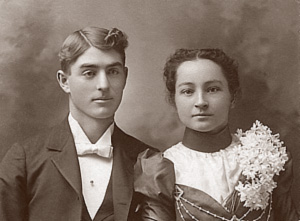
Reuben Miller and Louise Nutter on their wedding day in 1899
Reuben Miller married Louise Nutter at the Buffalo County courthouse in Kearney on 28
February, 1899. They set up housekeeping on some leased farmland a few miles southeast of
Ravenna, Nebraska in Gardner Township. Reuben's widowed mother and two of his brothers lived
a few houses away. Louise's niece, Ollie Nutter, came to stay with the young couple soon
thereafter as she got a job in the same school where Louise was teaching.
At this home in Gardner Township, Louise gave birth to their first child, Gerald Dale Miller on
6 October, 1902. The Miller's second child, a daughter named Ruby Geraldine was born 22 July,
1905 at the home of Louise's brother John Nutter at the Fort Farm Island farm near Gibbon.
Possibly Louise was availing herself of some post-natal care from John's daughter Ollie who had
moved back home.
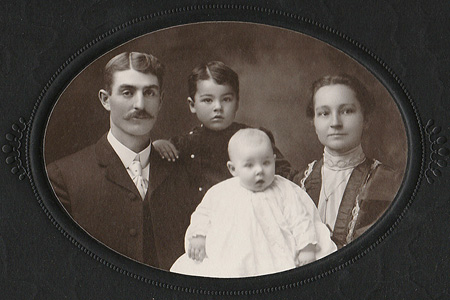
Reuben and Louise Miller with their children, Gerald and Ruby (about 1906)
After the death of Louise's father in May, 1906, she, along with Reuben and the children
accompanied Louise's mother on an extended visit to the west and northwest. They were in
attendance when Louise's niece, Ollie married Charles Holmes in February, 1907 in Denver,
Colorado. They also visited with Louise's three older sisters (Ellen, Ione and Jennie) in Oregon
with a view to settling there. For whatever reason, Louise was not inclined to transplant her young
family there so she and Reuben returned to Gardner Township in Buffalo County, Nebraska by
1908.
Perhaps there is a story which explains the wildly different circumstances of the Millers as
shown in the 1910 and 1920 censuses and in a 1919 land survey. Perhaps there is no story and
Reuben simply showed his legendary business acumen early on. Herewith are the facts. In 1910,
Reuben and Louise Miller are living with the two children on a modest farm in Gardener Township.
They owned the farm but it had a mortgage. Reuben was a farmer, Louise was still teaching. By
1919, Reuben owned three acreages in Cherry Creek Township almost due west of Ravenna
totaling 400 acres. The Miller home was on the most southern portion of land and the enterprise
was called "Wayside Farm". The census of 1920 revealed Reuben owned the land free and clear.
But, it also revealed that Reuben was living on his own without Louise and the children and with
Herbert and Flora Book, their two children and another young woman named Henrietta Thorpe age
22. Louise and the children are nowhere to be found in the township, the county or even the state.
Family members seem to recall that, as Gerald had gone off to college at York, Nebraska, Louise
and Ruby went along to "keep house" for him for some period of time.
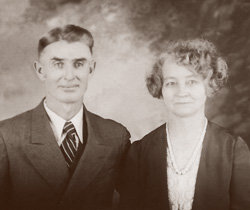
Reuben and Louise Miller
Louise had very strong and specific aspirations for each of her children; she envisioned Gerald
as a medical doctor and Ruby as a music teacher. Whether Reuben shared these ambitions with
Louise is unknown. It became a moot point starting when Ruby fell in love and married a local
farmer at the age of nineteen and began a family soon thereafter. Gerald taught school early on,
married another teacher and moved to Lincoln, Nebraska and then Manhattan, Kansas where he
continued as a professor in the agronomy department at Kansas State College.
In 1926, Reuben gave up farming and took a job in a meat rendering plant in Omaha, Nebraska.
He and Louise lived just south of the city in an area called Gilmore. Periodically, there were visits
from their only grandchildren, Ruby's children.
During the depression years and into World War II, Louise developed strong opinions about
social matters and current affairs which contrasted sharply with the views held by most of her
brothers. She harbored a bitter dislike for President Franklin Delano Roosevelt and distrusted most
organized religions but believed Roman Catholicism was particularly pernicious. She was an ardent
Anglophile and a great admirer of Winston Churchill. She was very outspoken about her views and
no one in the family was at all unsure of her points of view as she aggressively proffered them at
the drop of a hat. As usual, Reuben tended to remain silent during those times when Louise felt the
necessity of stridently voicing her opinions.
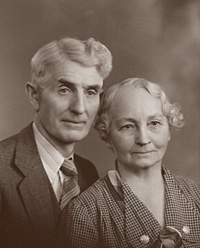
Reuben and Louise Miller
In 1943, Reuben Miller retired. Louise and he returned to the farm which they had leased to
their daughter Ruby and her husband, William Link. Eventually they sold the 100 acre portion and
three 80 acre pieces to them and moved into the town of Ravenna. One of the highlights of their
retirement was the purchase of an Airstream trailer in which they extensively toured the northwest.
This enabled a final visit between Louise and three of her sisters; Ione, Alice and Jennie, not to
mentions some of the nieces with whom she had been so close as a young woman
Reuben died of complications following a prostate operation on 23 October, 1956 at the age of
78. Louise did not adjust to widowhood very well. In the years following Reuben's death her
memory began to fail and by 1959 it was obvious she could not live on her own. Her family had
no choice but to put her in the Good Samaritan Home in Ravenna where her mind continued to
deteriorate. She died there on 17 August, 1969, just short of her ninety-second birthday, the
longest-lived of all of her siblings. Both she and Reuben are buried at the Highland Park Cemetery
in Ravenna.
The Children of Madam Louise Nutter and Reuben Miller
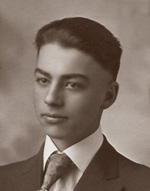
Gerald Dale Miller
Gerald Dale Miller (1902-1992) - according to his mother, should have been a
medical doctor. Instead he began teaching locally right out of high school and followed that
vocation, at one level or another, for the rest of his career. In 1928 he married a fellow teacher,
Zelma Reiker (born 1902) while he was in Agricultural College at Lincoln, Nebraska. Zelma taught
grade school in Lincoln until her retirement in 1969. Gerald taught at the University there then
transferred to the agronomy department at Kansas State University in Manhattan, Kansas, the
position from which he finally retired. Sadly, Gerald's end was much like his mother's end having
to spend years in a nursing home suffering from Alzheimer's Disease. He died in 1992. Zelma
died in 2005 in Manhatten, Kansas, aged 103. Gerald and Zelma had no children.
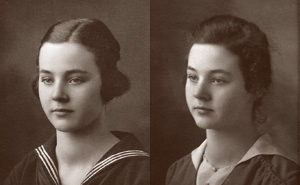
Ruby Miller
Ruby Geraldine Miller (1905-1992) - according to her mother, should have been a
music teacher. Indeed, as a young woman she became an accomplished pianist and was a charter
member of the Sodtown Band. However, Ruby let go of her mother's aspirations for her when she
met another member of that band, a young farmer who was also a student at the Grand Island
Business College. He was a local fellow named William Jacob Link (1900-1966) and was nephew
to Ruby's aunt by marriage, Katharina ("Katie") Link Nutter. Before their marriage in 1924 on the
lawn in front of her parents' home, Ruby had attended Kearney State Teachers College and she
taught school for several years after their wedding. About 1927, Ruby and Bill began leasing the
farmland belonging to Ruby's parents after the elder couple moved to the Omaha area. It was
hardly the easiest of times to attempt to make a living farming as the great depression began soon
afterwards and three children came along in fairly rapid succession. Then, the1930s were marked
by scorching summers, dust storms and drought. Still, they endured. About 1940, Bill and Ruby
purchased outright 340 acres of her parents' land and eventually did quite well. They instilled in
their children, among other things, the value of higher education and did what they could to
facilitate it. Beginning in the 1950s, eight grandchildren came along and Ruby enjoyed becoming a
nurturing, doting grandmother. In 1959 Bill Link suffered his first heart attack. His third and fatal
heart attack occurred on 3 February 1966 as he drove his truck in from one of his fields. Ruby did
her best to cope with widowhood and moved off the farm into Ravenna three years later. In 1973,
Ruby herself suffered a stroke, but substantially recovered from it. She remained an active
member in the United Methodist Church at Ravenna and as a member of the Eastern Star. She
finally gave up driving at the age of 84. When she died at the Good Samaritan Hospital in Kearney
on 31 March, 1994, she had successfully avoided, for the most part, what she had dreaded most;
the fate of her mother and brother - prolonged confinement to a nursing home. Ruby and Bill
Link's elder son is Dale Ronald Link (born 1926), a graduate of the Nebraska Agricultural College
at Lincoln. After serving two years in the service for his country in Japan, he returned to work his
parents' farm, first with his father, then on his own. With his wife Margaret Zetta Nelson, he has
two sons, five daughters and six grandchildren. Ruby and Bill's younger son, Bruce William Link
(born 1927) served two years in the US Navy then graduated from Nebraska Wesleyan University
at Lincoln. He moved several times during his career as a nuclear physicist and is now retired in
Oak Ridge, Tennessee. With his wife, Donna Lightbody, he has a son who lives in Kansas, a
daughter in Alaska and a daughter in California plus two granddaughters. Ruby and Bill's only
daughter, Sheila Lee Link (born 1931) also got her degree from Nebraska Wesleyan and taught
music. She finally settled in Oregon in 1965 and worked as a guidance counselor. She earned a
doctorate in educational psychology from the University of Oregon at Eugene and still lives nearby
in a town called Veneta. She has never married.
The Ancestry of William and Dinah (Ingham) Nutter
If the "complete" ancestry of William and Dinah (Ingham) Nutter, so far as it has been
researched, were to be included in this book, it would make this book more than ten times larger.
However, it is extremely unlikely that it would make it ten times more interesting Therefore, it is
more practical to select some of the more interesting genealogical lines and to include them
here.
In the pages that follow are several genealogies plus some accompanying commentary. They
are not complicated charts at all, but rather easy-to-follow paragraphs that show, step-by-step,
generation by generation, various lines from a remote ancestor down to either William Nutter
(1830-1906) or Dinah Ingham Nutter (1834-1918). If you are descended from the couple, these
genealogies belong to you as well.
In some of these genealogies further along, you'll notice quite a few famous people out of
ancient European history. These are not included out of conceit. They are included because, at
some point in history, it is only people who are rich and/or famous whose histories are
recorded.
Consider some numbers. Everyone has two parents, four grandparents, eight great-
grandparents, etc. and the number continues to double with each receding generation. Over thirty
generations, (about six or seven centuries), any given person will have more than thirty-three
million ancestors! The approximate population of England was about four million about the year
1400 (thanks to the bubonic plague having wiped out roughly one-third of the population about 50
years before). It is therefore very statistically probable that any one English person is likely to be
descended from most of those four million English people, many times over; be they royalty,
peasants and all those in-between. In view of these facts, claims of descent from King Edward III
(1312-1377) of England for instance, places one in a not-too-exclusive club as it is likely there are
truly millions of us.
In addition to that, because William Nutter (1830-1906) and Dinah Ingham Nutter (1834-1918)
come from the north of England and, therefore, farther away from the seat of power in London,
they were actually more likely to have royal ancestry and have people of wealth and influence in
their family history. The reason for this is simple. In the south of England the English class system
flourished. In the north, there was less distinction among the classes and there was less wealth.
There was substantial movement from one class level to another - upwards and downwards. In a
matter of a few generations, a member of one of the handful of wealthier families could pass from
upper class status to working class (middle class) simply by being the youngest son of a youngest
son of a youngest son. Similarly, a couple of "good" marriages in successive generations could
easily lift a family up from the lower class to the next level of class.
Another factor which made the north of England different than the south was the north's greater
use of the copyhold system. The copyhold system grew out of feudalism and roughly worked as
follows; A wealthy person (sometimes even the king) owned land which they let out for copyhold.
A copyholder held the land paying an annual rent of six pence per acre, a price fixed "in
perpetuity" (ie. forever). The copyholder had the right to pass his hold on the land to his heirs, he
could sub-divide it among his family, he could rent out portions to lessees at whatever rate was
agreed upon. Essentially, the copyholder had virtually all the rights a free holding landowner had
provided he continued to pay his six pence per acre per year. The net effect of this system was to
enrich and empower an upper middle class stratum for several centuries.
There were many of these copyholders, contemporarily called "yeoman", among William and
Dinah Nutter's ancestors. There were also those who were designated as a "Gentleman" among
them too. This described a free holding landowner whose income resulted from others working his
farmland. Finally, there were ancestors called "husbandmen" which generally and simply means
"farmer". However, in years gone by, husbandmen were working overseers of a well-established,
large farms, often lessees of land "in service" to a wealthier land-owning relative.
In truth, the overwhelming majority of the ancestors of William and Dinah Nutter were simply
farmers and, in more recent generations, laborers in some facet of the woolen or cotton
manufacturing industry. However, as has been stated, these pages are an attempt to present the
more interesting people in their histories.
The genealogy which follows is the product of many decades of research by several people
often working in concert with each other. The genealogy of the Nutter family as a whole has been
the subject of study by many people for years due to the fact that so many people named Nutter are
still in the area and so many figure in local genealogies. Also, throughout the history of the local
area, Nutters have figured heavily.
Over the past few decades, members of the Mormon Church have copied and indexed almost
all of the parish registers of England. Examination of that data shows, as certainly as can be
known, that anyone with the surname Nutter is descended from a few people living in eastern
Lancashire and west Yorkshire in Northern England in the late fourteenth and early fifteenth
centuries. In addition, there is substantial evidence that the large Nuttall family, found mostly in
the Rossendale Valley (just south of the area where the Nutters flourished), are likely also
descended from the same progenitors.
The name Nutter is actually a product of the Middle English words "Not-herd" - referring to one
who herds cattle. It has nothing to do with nuts - the kind one eats or the kind one may find in a
mental institution. Unfortunately though, in modern Britain, "Nutter" has recently crept into
modern vernacular as a term describing a person of questionable sanity.
Perhaps the most daunting aspect of researching the Nutter family is their high concentration in
a very small area and their aggravating use and reuse of a small pool of Christian names,
particularly; John, Robert, Henry and Ellis. Most people would probably not have a problem
believing there were plenty of John, Robert and Henry Nutters - but Ellis?
In the middle decades of the 1600s, there were twelve Ellis Nutters, of varying ages, living
within a few miles of each other around Burnley in Lancashire. In fact, when one of these Ellis
Nutters died in 1666, his widow Ann married yet another Ellis Nutter the next year. He was the
first Ellis' third cousin, once removed and a neighbor. These Nutter lines were very difficult to sort
out.
In the first of the two genealogies that follow, these Nutter men in the first six generations were
among the wealthiest residents of Pendle Forest. Ellis Nutter (c.1530-1603) had enriched his estate
significantly and in 1566 he arranged a marriage for his eldest son Henry, to Alice, a daughter from
the wealthy Halstead family. However, that marriage was childless. After Alice's death in 1604,
Henry married a distant cousin, Rosamund Nutter, with whom he fathered four children while he
was in his fifties. Had those children never been born, the substantial wealth would have passed to
the line from which "our" William Nutter (1830-1906) was descended.
It is interesting to note that John Nutter (1567-1641) married an Ingham in 1597. In fact,
William Nutter and Dinah Ingham were related to each other in several different ways through the
Nutters, Knowles, Baileys and Smiths. There are also several cases where these ancestors
themselves married distant cousins. For instance, Ellis Nutter (1602-1675) married Mary Moore
whose mother, Mary Nutter Moore Parker was his third cousin (see that genealogy a few pages
ahead).
Perhaps this particular genealogy best shows the determination required of people who do
genealogical research. Jean Nutter Nelson, who did so much of the research on this work, was able
to assemble the information on the last four generations of this genealogy (from Robert Nutter, the
wool comber of Barley Green on down) in one or two afternoons of research in the registers of
Newchurch-in-Pendle. It took her nearly another twenty years to find information which
confirmed Robert the wool comber's correct baptism and thereby bridge to his parents.
Note; The William Noter below is likely a descendant of Roger de Noteho (living 1256), father
of Adam de Noteho who held some land in Colne manor (1323), father of Henry de Notehagh of
Colne manor (1324) whose son Roger de Noutherde was also mentioned in the same year.
William Noter - may have been one man or a father and son with the same name;
yeoman of Barnside at Foulridge in the Manor of Colne, Lancashire, England, England in 1406;
appointed Master of the Forest of Pendle near Burnley Lancashire in 1423 and was granted a free
tenancy there in 1426 at "Forester's Dole" near Wheatley Lane in Goldshaw Booth; He probably
married one of the several illegitimate daughters of Sir Henry de Hoghton of Pendleton near
Clitheroe who, as Chief Forester of Blackburnshire (East Lancashire) appointed William as Master
of Pendle Forest; they had at least two sons, the elder of which was...
John Nutter (c.1423-after 1498) - yeoman of Goldshaw Booth in Pendle Forest near
Burnley, Lancashire, England; with his wife, whose name is unknown, he had several sons, among
them...
Robert Nutter (c.1453-1524) - yeoman, of New Laund in Pendle Forest, near
Burnley, Lancashire, England; He was the agister of New Laund in 1507 when he was granted
copyhold status of that same land plus some land in adjacent Goldshaw Booth; He married a
daughter of John Robinson, gentleman of Old Laund and through this marriage secured his claims
on the aforementioned lands; they had at least one daughter and three sons; Before his own death,
he had divided his copyhold lands equally among his three sons, namely Henry (died 1513),
Christopher (died 1520), who both predeceased him, and his youngest son...
Ellis Nutter (c.1480-1547) - yeoman, of the Waterside portion of New Laund, near
Burnley, Lancashire, England; He was granted additional freehold land at Filly Close by Sir John
Towneley in 1506 and later acquired land at adjacent Reedley Hallows by virtue of his marriage to
Towneley's kinswoman, Ellen, daughter of Miles Parker by Elizabeth, daughter of Lawrence
Towneley; They had at least two sons; The younger son, John (c.1513-1585) inherited Waterside
and Reedley Hallows was inherited by his elder son...
Henry Nutter (c.1510-1558) - yeoman of Reedley Hallows, near Burnley, Lancashire,
England; He married Sybil (died 1593), probably the daughter of Henry Barcroft and had three
daughters and six sons, (one of which was born after his death); his eldest son and heir was...
Ellis Nutter (c.1530-1603) - yeoman of Reedley Hallows, near Burnley, Lancashire,
England; He married Ann, an illegitimate, but acknowledged daughter of Oliver Ormerod yeoman
of Crawshaw Booth, Rossendale and significantly enriched his estate including some lands at Little
Marsden; He arranged the marriage of his eldest son, Henry, to Alice, a daughter of the wealthy
local Halstead family in 1566, but the marriage was childless and it appeared likely Ellis' wealth
would eventually pass to a younger son. However, after his death, his eldest son Henry's wife
Alice Halstead died in 1604 and he married again fathering several children in his fifties to whom
the wealth passed; One of the younger sons of Ellis, who might have inherited substantial wealth
had his brother Henry not remarried and had children was...
John Nutter (1567-1641) - husbandman of Heyhead in Little Marsden, near Colne
and Burnley, Lancashire, England; married in 1597 to Ann (1568-1630), daughter of Henry Ingham
of Halgh Row, Reedley Hallows, near Burnley, Lancashire; their eldest son was...
Ellis Nutter (1602-1675) - husbandman of Heyhead in Little Marsden, near Colne and
Burnley, Lancashire, England; married about 1626 to Mary (1597-1681) daughter of Hugh Moore
of Higham, near Burnley and who was an aunt to the famous English mathematician and
astronomer Sir Jonas Moore; their eldest son was...
John Nutter (1628-1692) - husbandman of Little Marsden, near Colne and Burnley,
Lancashire, England; married sometime before 1662 to Elizabeth who died in 1708; they had at
least six children of whom the eldest son was...
John Nutter (1667-1698/1707) husbandman of Little Marsden, near Colne and
Burnley, Lancashire, England; married in 1692 to Grace (born 1671) daughter of Michael Pickles
of Little Marsden and had a daughter and a son...
William Nutter (1693-1744) - of Colne, Lancashire, England, England; after fathering
two illegitimate sons with Sarah Hartley, he married in 1716 to Ellen (1690-1741) daughter of John
Smith of Raygill in Colne; The eldest of their eight children was...
John Nutter (1717-1772) - husbandman of Little Marsden, near Colne, Lancashire,
England, England; married in 1734 to Elizabeth (1716-1770) daughter of William Berry of Little
Marsden, near Colne. The eldest son among their seven children was...
Robert Nutter (1742-1785) - wool comber of Barley Green, near Newchurch-in-
Pendle, Lancashire, England, England; He married in 1767 to Mary (1747-1818) daughter of
Bernard Bailey of Twiston near Clitheroe; She survived him by 33 years and also survived 5 of her
6 children of whom the eldest was...
John Nutter (1769-1800/02) - weaver of Barley, near Newchurch-in-Pendle,
Lancashire, England, England; He married in 1791 to Grace (1772-1836) daughter of John
Wildman with whom he had two sons; After he died in his early thirties, she remarried to George
Heyworth with whom she had 3 more children; John and Grace's eldest son was...
John Nutter (1795-1848) - weaver of Whitehough and Narrowgates Farms, Barley,
near Newchurch-in-Pendle, Lancashire, England, England; married in 1814 to Elizabeth (1795-
1872) illegitimate daughter of Ann Knowles with whom he fathered at least 18 children; among
these was...
William Nutter (1830-1906) - who married in 1852 to Dinah Ingham (1834-
1918) - the main subjects of this book and the parents of 15 children
In 1443, there was a William Ingham, yeoman, living at Fulledge in Burnley who had a
substantial estate. It is likely that he was a grandfather or great-grandfather to the first Ingham in
the following genealogy. It is also likely that he was ancestral to the numerous Ingham family
branches that still survive within a fifty mile radius of Burnley and beyond.
Like the name Nutter, the Ingham name seems to have its roots in east Lancashire and west
Yorkshire. The name comes from the Norse for "Ing's settlement" - Ing being a common
Scandinavian first name, the "ham" part surviving still in our English word "hamlet".
The Inghams in this line did not enjoy the wealth and social status that the Nutters had, but they
were not desperately poor either. This was because they consistently married "well".
Edmund Ingham's married in 1565 to Jane Holden, a month after she had given birth to their
son. Jane was the daughter of Richard Holden, a wealthy Catholic gentleman of considerable estate
at Chaigley, just over the county boundary in Yorkshire. Richard Holden was not particularly
happy with his daughter's marriage but the wealthy family of his wife, Ann Nowell, at Read, near
Whalley, looked after the interests of the couple and their eleven children for many years.
Their youngest son Henry Ingham (born 1578) moved from Read to West Close, near Higham
on the outskirts of Burnley with many of his siblings. At 41 he married Jenet, daughter of John
Pollard, a wealthy clothier. He secured a hold on land at West Close and passed it on to his only
son John Ingham (1623-1693) who lived on that land his entire life. His wife Margaret (1626-
1693) was the daughter of Christopher Dodgson, a wealthy yeoman of nearby Padiham. They had
8 children, among them three sons who farmed the land at West Close.
When their middle son Thomas (1661-1718) was widowed in 1697 he married within months to
his third cousin Anna Birtwistle (1662-1736). Anna already had two illegitimate sons and
proceeded to have eight more children with Thomas Ingham over the next eleven years, the last
one, John, born when Anna was 47 years old.
As the youngest son, John Ingham (1709-1792) lost any connection with the family land at
West Close. His marriage to Isabel Bailey (1712-1746) did nothing to enrich them though the
Baileys were wealthy copyholders in Goldshaw Booth and were descended from the Nutter family
in two different lines. John and Isabel had 6 sons and, after her death, he had 2 more sons with a
second wife, all of whom, along with his sister Ellen's 2 illegitimate sons (who bore the name
Ingham) quickly made "Ingham" the most common surname in the area.
Because they each lived until almost 80, Thomas Ingham (1736-1816) and his wife, Margaret
Knowles (1737-1816) seem to introduce longevity into this line. (Margaret's father, Jonas Knowles,
died in 1795 age almost 90). Several of their children lived into their eighties but not Dinah's
grandfather, their oldest son Jonas Ingham (1758-1818), who died at 58. However, there is a
family tradition that Jonas' death was premature and occurred as a result of a gruesome
accident.
Dinah Ingham Nutter's father William Ingham (1790-1855) kept up the family tradition of
"marrying above his station". Leonard Heyworth (1772-1836), father of William's bride Olive
(1798-1840) was far wealthier than the Inghams and made sure that his disobedient daughter and
her low-class groom benefited not at all from their forbidden nuptials.
John Ingham (died 1545/7) - husbandman of Read, near Whalley, Lancashire,
England had a son...
Thomas Ingham (c.1500-1573/4) - husbandman of Read, near Whalley, Lancashire,
England; he married Agnes (died 1566) and had at least 7 children, among them...
Edmund Ingham (before 1538-1597) - husbandman of Read, near Whalley,
Lancashire, England; he married in 1565 a month after the birth of their first child, to Jane (c.1545-
1587?), daughter of Richard Holden, gentleman of Chaigley manor in Yorkshire; Among their 11
children, the youngest son was...
Henry Ingham (1578- ? ) - husbandman of Read then of West Close, near Padiham,
Lancashire, England; he married late in life (1619) to Jenet (born 1595) daughter of John Pollard of
Habergham Eaves, near Burnley; their only child was...
John Ingham (1623-1693) - husbandman of West Close, near Padiham, Lancashire,
England; he married in 1646 to Margaret (1626-1693) daughter of Christopher Dodgson of
Padiham; John and Margaret died within two weeks of each other near Christmas, 1693 and their
farm passed to their eldest son John; a younger son among their 8 children was...
Thomas Ingham (1661-1718) - husbandman of West Close, near Padiham,
Lancashire, England; four months after his first wife died in 1697, he married secondly to Anna
(1662-1736) daughter of John Birtwistle of Higham near Padiham with whom he had 8 children in
the next eleven years; the last child, born when Anna was 47 years old, was...
John Ingham (1709- ? ) - husbandman of Higham, near Padiham, Lancashire,
England; he married in 1732 to Isabel (1712-1746) daughter of Edmund Bailey and had 6 sons with
her; after her death, he married secondly in 1747 to Mary Crabtree (1723-1800) and had 2 more
sons with her; because he had 8 sons and because his sister Ellen had 2 illegitimate sons bearing the
surname of Ingham, they became ancestral to descendants carrying the most common surname in
the district; among the family with his first wife was...
Thomas Ingham (1736-1814) - weaver and wool comber of Fence Gate, Higham, near
Padiham, Lancashire, England; he married in 1757 to Margaret (1737-1816) daughter of Jonas
Knowles and they had 5 sons and 3 daughters; their eldest son was...
Jonas Ingham (1758-1818) - weaver of Higham, near Padiham, Lancashire, England;
he married in 1788 at the age of 30 to a woman nine years his senior, Grace (1749-1823) daughter
of William Kenyon, an innkeeper in the Gisburn, Yorkshire area; They had two sons, the younger
of which was...
William Ingham (1790-1855) - weaver, coachman, butcher of Higham, Goldshaw and
Old Laund Booths, all near Burnley, Lancashire, England; He served in his majesty's army in the
United States during the War of 1812 and in Europe during the Napoleonic Wars; he married in
1822 to Olive (1798-1840) daughter of Leonard Heyworth of Goldshaw Booth and fathered 7
children among whom was...
Dinah Ingham (1834-1918) married in 1852 to William Nutter (1830-1906)
- the main subjects of this book and the parents of 15 children
The Story of the "Lancashire Witches"
The next two genealogies show the connection of William Nutter (1830-1906) and his wife
Dinah Ingham (1834-1918) to characters in a tragic episode of the history of Pendle Forest. Like
the history that Salem, Massachusetts in the United States would later have, Pendle Forest is known
for witch trials.
The story actually spans nearly twenty years. Beginning with the deaths of Christopher Nutter
in 1593, then his son Robert Nutter in 1595, both yeoman of the Greenhead portion of New Laund,
the local populace in Pendle Forest accepted that each had been bewitched to death. Two old
women, Elizabeth Southerns (nicknamed Demdike) and Anne Whittle (called Chattox) took credit
for the witchcraft and began wielding influence with the locals threatening many with their
"powers" and occasionally they were enlisted to cure sick people and animals. In the years that
followed, fifteen more people died, supposedly as a result of the practice of the "black arts" by
Demdike, Chattox, their relatives and associates. An ancestor to William Nutter (1830-1906), Hugh
Moore, was one of these 15 additional victims
Then in March, 1612, Alizon Device, Demdike's granddaughter, was accused of laming John
Law by his son, Abraham Law. Law brought the girl to the attention of the authorities, notably
Justice of the Peace Roger Nowell. Nowell was well aware that his diligent prosecution of this
"outbreak" would earn him favor with King James I. James had ascended the throne in 1603 and
had made ridding Britain of the evils of witchcraft a high priority - (rather like a 17th century
George W. Bush).
Roger Nowell prosecuted this outbreak of witchcraft vigorously. These hapless "witches"
eagerly told of their "powers" and, sadly, they informed on each other. In addition to the
desperately poor among them, several out of the yeoman class were also accused; Alice Nutter of
Roughlee plus her daughter, Elizabeth Hargreaves along with her husband Christopher Hargreaves
of Thornyholme (all ancestral to Dinah Ingham Nutter as shown in the second following
genealogy). Also, Alice's sister-in-law, Jane Nutter Bulcock and her son John Bulcock were among
the accused. (For some reason, charges against Elizabeth and Christopher Hargreaves were
dropped). In all, eleven people were hung at Lancaster pursuant to Roger Nowell's investigation
including all the aforementioned defendants.
The Story of the Lancashire Martyrs
William Nutter (1830-1906) was descended from Mary Nutter Moore Parker (c.1561-1614) as
shown on the first of the next two genealogies. Her father, Robert Nutter (c.1510-1570?) was the
patriarch of a family with great prospects - he was wealthy and had a large family (mostly sons) of
whom Mary was the youngest.
In 1557, Robert Nutter arranged for his eldest son Christopher to marry the daughter of his
cousin Ellis Nutter, thus reuniting two thirds of the copyhold land of New Laund and making
Robert and his son two of the richest men in Pendle Forest. By the time Robert died, probably in
1570, he had 3 grandsons, several sons with university degrees (or in the process of getting them),
male descendants galore insuring the survival of his name and great wealth.
Sadly, it all began unraveling soon afterwards.
Eldest son Christopher died in 1593 supposedly as a result of being bewitched by Demdike.
Then Christopher's eldest son Robert was reputedly bewitched to death two years later in his late
thirties leaving three little girls. Christopher's second son, Ellis, died in 1600 before his fortieth
birthday leaving only one son, John, who became very wealthy, influential and respected locally,
but who died childless after two marriages at the age of 72 in 1656. Christopher's youngest son
Christopher, died childless in 1606 age 41.
Robert Nutter's youngest son Richard was a ne'er do well who fathered only an illegitimate
daughter. Robert's son Henry died at the age of almost 90 in 1642 after a childless marriage that
had lasted 55 years. Robert's son James was a staunch Catholic who died in 1620 when he was
nearly 80. He had only one son, Ellis, who became a priest in 1601 and died a few years later.
Robert Nutter's two remaining sons, John and Robert, each graduated from university - John
from Cambridge, Robert from Oxford. Each went to the continent to study for the priesthood and
was ordained at Rheims in France - John in 1582, Robert in 1581. Each returned to mission work
in England and was martyred for their faith.
John met his fate relatively quickly when he was shipwrecked upon his return to England. He
was imprisoned at Marshalea Prison, convicted of treason for attempting to carry out his priestly
duties. He was hung, drawn and quartered 12 February, 1585 at the Tower of Tyburn near
Holborn.
Robert entered England in 1584, was tortured and imprisoned in the Tower of London before
he was exiled to Normandy in France. He returned to England, was recaptured and imprisoned first
at Newgate, then at the Marshalea. He escaped in 1590, he was hidden by family and friends for
nearly a decade. He was recaptured in 1600 and imprisoned at Lancaster Castle where he was hung
drawn and quartered on 26 July, 1600.
Both brothers were raised to "Venerable" status by the Roman Catholic Church and await
canonization as saints.
In less than a century after "old" Robert Nutter's death, not one of his descendants carried his
surname. His substantial estate had been divided among more than two dozen descendants through
female lines.
William Noter - may have been one man or a father and son with the same name;
yeoman of Barnside at Foulridge in the Manor of Colne, Lancashire, England, England in 1406;
appointed Master of the Forest of Pendle near Burnley Lancashire in 1423 and was granted a free
tenancy there in 1426 at "Forester's Dole" near Wheatley Lane in Goldshaw Booth; He probably
married one of the several illegitimate daughters of Sir Henry de Hoghton of Pendleton near
Clitheroe who, as Chief Forester of Blackburnshire (east Lancashire) appointed William as Master
of Pendle Forest; they had at least two sons, the elder of which was...
John Nutter (c.1423-after 1498) - yeoman of Goldshaw Booth in Pendle Forest near
Burnley, Lancashire, England; with his wife, whose name is unknown, he had several sons, among
them...
Robert Nutter (c.1453-1524) yeoman, of New Laund in Pendle Forest, near Burnley,
Lancashire, England; He was the agister of New Laund in 1507 when he was granted copyhold
status of that same land plus some land in adjacent Goldshaw Booth; He married a daughter of
John Robinson, gentleman of Old Laund and through this marriage secured his claims on the
aforementioned lands; they had at least one daughter and three sons; Before his own death, he had
divided his copyhold lands equally among his three sons, namely Henry (died 1513), Ellis (died
1547), and his middle son...
Christopher Nutter (c.1476-1520) - yeoman, heir of the Greenhead portion of his
father's copyhold at New Laund; he married Elizabeth Whitaker who survived him by at least 25
years; their eldest son was...
Robert Nutter (c.1510-1570?) - yeoman of Greenhead, New Laund Booth, near
Burnley, Lancashire, England; he married first to Alice, daughter of James Hartley (died 1565);
their family suffered much from their adherence to Roman Catholicism long after it was healthy to
do so in England; Their sons John Nutter (c.1547-1584) and Robert Nutter (1550-1600) both
became priests; John went to Cambridge University then the Catholic Seminary in Douay, Belgium
and was was ordained at Rheims, France in 1582: He was shipwrecked upon returning to England
and was imprisoned for his "treasonous" beliefs at the Marshalea Prison; He was hung, drawn and
quartered in 1584 at the Tower of Tyburn, near Holborn, England; His brother Robert Nutter was
an Oxford University graduate who studied the priesthood at Rheims, France and was ordained
there in 1581; Upon return to England, he was imprisoned and tortured in the Tower of London but
was later exiled to Normandy; He returned to England, was imprisoned at Newgate and the
Marshalea before escaping north in 1590; He was hidden by his family and friends for ten
years but was recaptured, imprisoned at Lancaster where he was hung, drawn and quartered in
1600; Both John and Robert Nutter have been elevated to "venerable" by the Catholic Church, the
last step before sainthood; Their brother James' son Ellis was also ordained a priest at Rome in
1601 and was martyred in England in 1603; The youngest daughter in the family, by Robert's
second wife, Elizabeth, was...
Mary Nutter (c.1561-1614) - who married in 1590 Hugh Moore, yeoman of White
Lee, Higham, near Padiham, Lancashire England; after having six children with him, he died,
supposedly after being "bewitched" by Ann Whittle (called Chattox) and others in 1599. Mary's
eldest brother, Christopher Nutter (c.1535-1593) and his son Robert Nutter (c.1558-1595) had also
both supposedly suffered similar fates in recent years; these accusations and others led to the
Lancashire Witch Trials of 1612 where many of the accused were hung at Lancaster for their
"crimes". Despite this entanglement with superstition, the son of Mary's eldest son Hugh Moore
became one of the greatest scientists of his time; Sir Jonas Moore (1616-1679) was a mathematician
and astronomer whose work resulted in the establishment of Greenwich Mean Time for the world;
In 1602, Mary married again to a very wealthy yeoman named Henry Parker (c.1573-1651) a
clothier of Wheatley Lane near Burnley and had 3 more children with him, the last of which was
born when she was about forty-seven (1608), but it was with her first husband, Hugh Moore with
whom she had a daughter...
Mary Moore (1597-1681) - who married Ellis Nutter (1602-1675) yeoman of
Heyhead in Little Marsden near Burnley and Colne, Lancashire, England, England; their eldest son
was...
John Nutter (1628-1692) - husbandman of Little Marsden, near Colne and Burnley,
Lancashire, England; married sometime before 1662 to Elizabeth who died in 1708; they had at
least six children of whom the eldest son was...
John Nutter (1667-1698/1707) - husbandman of Little Marsden, near Colne and
Burnley, Lancashire, England; married in 1692 to Grace (born 1671) daughter of Michael Pickles
of Little Marsden and had a daughter and a son...
William Nutter (1693-1744) - of Colne, Lancashire, England, England; after fathering
two illegitimate sons with Sarah Hartley, he married in 1716 to Ellen (1690-1741) daughter of John
Smith of Raygill in Colne; The eldest of their eight children was...
John Nutter (1717-1772) - husbandman of Little Marsden, near Colne, Lancashire,
England, England; married in 1734 to Elizabeth (1716-1770) daughter of William Berry of Little
Marsden, near Colne. The eldest son among their seven children was...
Robert Nutter (1742-1785) - wool comber of Barley Green, near Newchurch-in-
Pendle, Lancashire, England, England; He married in 1767 to Mary (1747-1818) daughter of
Bernard Bailey of Twiston near Clitheroe; She survived him by 33 years and also survived 5 of her
6 children of whom the eldest was...
John Nutter (1769-1800/02) - weaver of Barley, near Newchurch-in-Pendle,
Lancashire, England, England;
He married in 1791 to Grace (1772-1836) daughter of John Wildman with whom he had two
sons; After he died in his early thirties, she remarried to George Heyworth with whom she had 3
more children; John and Grace's eldest son was...
John Nutter (1795-1848) - weaver of Whitehough and Narrowgates Farms, Barley,
near Newchurch-in-Pendle, Lancashire, England, England; married in 1814 to Elizabeth (1795-
1872) illegitimate daughter of Ann Knowles with whom he fathered at least 18 children; among
these was...
William Nutter (1830-1906) who married in 1852 to Dinah Ingham (1834-
1918) - the main subjects of this book and the parents of 15 children.
William Noter may have been one man or a father and son with the same name;
yeoman of Barnside at Foulridge in the Manor of Colne, Lancashire, England, England in 1406;
appointed Master of the Forest of Pendle near Burnley Lancashire in 1423 and was granted a free
tenancy there in 1426 at "Forester's Dole" near Wheatley Lane in Goldshaw Booth; He probably
married one of the several illegitimate daughters of Sir Henry de Hoghton of Pendleton near
Clitheroe who, as Chief Forester of Blackburnshire (east Lancashire) appointed William as Master
of Pendle Forest; they had at least two sons, the younger of which was...
William Nutter (c.1430-after 1474) yeoman of Roughlee Booth in Pendle Forest near
Burnley, Lancashire, England; He married Margaret (?) and had at least three children
including...
Richard Nutter (c.1460-c.1507) yeoman of Roughlee Booth in Pendle Forest near
Burnley, Lancashire, England; With his wife, whose name is unknown he was the father of...
Miles Nutter (1486-after 1563) yeoman of Roughlee Booth in Pendle Forest near
Burnley, Lancashire, England; when he was close to 50 years old, he married Elizabeth (died
1580); they had two sons of whom one was;
Richard Nutter (c.1535-1584) - yeoman of Roughlee Booth in Pendle Forest near
Burnley, Lancashire, England; About 1561 he married to Alice Whitaker (c.1545-1612) daughter
of Giles Whitaker, yeoman of Huncoat near Padiham, Lancashire with whom she had four sons
and one daughter; In her widowhood, Alice, a woman of some means, mixed socially with some
of the desperately poor women in the area and as a result, she was accused of witchcraft along with
them; After a brief trial at Lancaster, most were condemned to death by hanging; The sentence
was carried out on 20 August, 1612 securing her place in local history as "Mistress Alice Nutter, the
elegant witch"; Her only daughter was...
Elizabeth Nutter (c.1582-1648) - married Christopher Hargreaves (died 1639)
yeoman of Thorney Holme in Goldshaw Booth near Burnley, Lancashire, England; At first, both of
them were accused of witchcraft along with Elizabeth's mother in 1612 but inexplicably, the
charges were dropped against them; Among their large family was a daughter...
Elizabeth Hargreaves (1614-1698) - married in 1642 to Thomas Jackson of
Goldshaw Booth, near Burnley, Lancashire, England; their eldest daughter was...
Helen Jackson (1646-1702) - married in 1668 to John Crook (1640-1713) of
Padiham, Lancashire, England, Innkeeper; their son was...
John Crook (1679-after 1736) - Innkeeper at Padiham and at the Thorne Hotel in
Burnley, Lancashire, England; He married in 1709 to Mary (1688-1767) daughter of Christopher
Almond, Innkeeper of Padiham; their daughter was...
Ellen Crook (1714- ? ) - married in 1737 to William Kenyon (1716-1760) Innkeeper
of the Gisburn area in Yorkshire, England and at Clitheroe, Lancashire; Among their children
was...
Grace Kenyon (1749-1823) - married in 1788 after getting pregnant in her thirty-
ninth year by weaver Jonas Ingham (1758-1818) of Higham, near Padiham, Lancashire, who was
nine years her junior; their second son was...
William Ingham (1790-1855) - weaver, coachman, butcher of Higham, Goldshaw and
Old Laund Booths, all near Burnley, Lancashire, England; He served in his majesty's army in the
United States during the War of 1812 and in Europe during the Napoleonic Wars; he married in
1822 to Olive (1798-1840) daughter of Leonard Heyworth of Goldshaw Booth and fathered 7
children among whom was...
Dinah Ingham (1834-1918) - married in 1852 to William Nutter (1830-
1906) - the main subjects of this book and the parents of 15 children
Only one line of royal descent has been discovered for William Nutter (1830-1906). This
genealogy is "less royal" than the many connections in his wife's ancestry as it meets up with
royalty way back in 1090 with the birth of Robert de Caen, one of 21 illegitimate children of Henry
I, King of England. (Dinah's lines connect to royalty more recently, in the mid-1300s, with the
great-great-great-great-great grandson of Henry I).
Like many of the royal genealogies shown in the following pages, this one begins with
Charlemagne. Most people have heard of him, but most really don't know why he was important in
European history. Perhaps the best explanation, unfortunately, begins with Adolf Hitler.
Have you ever wondered why Hitler's tenure was called the "Third Reich"? What was a
"Reich" and what happened to the first and second ones? "Reich" is the German word for empire
and Charlemagne essentially assembled the first "Reich" when he was crowned Holy Roman
Emperor by Pope Leo III in Rome on Christmas Day, 800. The pope made it holy, Rome made it
Roman, Charlemagne was emperor - Holy Roman Emperor - get it?
Charlemagne's empire included most of France, Germany, Italy, Belgium, the Netherlands and
Luxembourg - basically Western Europe. Western Europe had been in chaos since the fall of the
Roman Empire in 476. Charlemagne restored order to most of a continent, assured an enduring
Christian influence, preserved much of western civilization and fostered the climate in which it
would flourish for centuries. Not bad credentials for anyone's resume. Is it any wonder he is
called "Charlemagne" (ie. Charles the Great)?
The Holy Roman Empire (The first Reich) continued in some form or another until a greatly
diminished empire passed from existence in 1804. The second Reich or Empire was assembled
from 1871 to 1914 as the Germans tried to exert influence over Western Europe once more. The
Third Reich, as we know, flourished briefly through World War II.
After Charlemagne died in 814, much of his empire got divided among his descendants into
smaller kingdoms, principalities, duchies, etc. The net effect was that Charlemagne became
ancestral to virtually every royal family in Europe. That is why he shows up at the top of so many
of these charts showing royal ancestry.
This chart shows descent through the influential Counts of Flanders (in Belgium). Note these
counts augmented that influence as they married into various royal families (Saxon England, Italy,
France). Finally, a daughter of a Count of Flanders married William, Duke of Normandy in France.
He conquered England in 1066 and became William "the Conqueror", King of England. His son,
Henry I, was nicknamed "Beauclerc" meaning "good scholar". He apparently indulged in
something apart from scholarly pursuits as he left a passel of 21 illegitimate children. According to
one encyclopedia, Robert de Caen was the "most important bastard child". He married the daughter
of the Earl of Gloucester and eventually inherited that title. After all, "most important bastard
child" probably didn't buy him much status.
Robert's son William married Hawise Beaumont, daughter of the Earl of Leicester and the great-
granddaughter of Henri I, King of France and Anna, daughter of the man some historians call "the
first Czar of Russia". Their daughter married the Earl of Hereford.
The line passes out of the gentry to Maud de Clare who marries a veteran from the Third
Crusade, Roger de Lacy, who eventually became Constable of Chester. His daughter was granted
lands at Tunliea (Towneley) near Burnley upon her marriage to Geoffrey, Dean of Whalley in
Lancashire. This was the defining moment in history for what would become the Towneley family.
They were suddenly the wealthiest, largest land-owning family in the area around Burnley in
Lancashire for next several centuries.
Wealthy families often have younger daughters of younger sons who get married to men a step
or two below their station. That was the case with Elizabeth Towneley who married Miles Parker.
In turn, their daughter Ellen Parker married Ellis Nutter and apparently did not enjoy an idyllic
marriage. A church court records that, in 1537, after about thirty years of marriage, Ellis "drove his
wife from his house". The reconciliation, if there was one, is not recorded. They only had two
sons so perhaps their differences had started many years before.
The descent from these two love-birds is the same as in the first genealogy of this series.
Genealogy Showing the Royal Descent of William Nutter
Charlemagne (742-814) King of the Franks 742-814 - crowned Holy Roman
Emperor by the pope in 800 and reigned over most of western Europe; with his third wife,
Hildegarde of Swabia (758-783) he had 3 sons among whom he split his empire into three portions
which are now (roughly) France, Germany and Italy; his eldest son was...
Louis I (778-840) - called "the Pious" or "le Debonnair"; Holy Roman Emperor
813-840; he further divided his empire among his four sons from his two marriages; with his
second wife, Judith of Bavaria (800-843) he had a son...
Charles II (823-877) - called "the Bald", Holy Roman Emperor and King of
France; he married first to Ermantrude of Orleans (died 869) with whom he had a
daughter...
Judith, Princess of the Franks (born 843) - after marriages to two successive Kings of
Wessex (England), a father and a son, she eloped in 863 with Baldwin I (died 879) who had been
created Count of Flanders; they had three children among whom was...
Baldwin II (died 918) Count of Flanders - married Aelfthryth (872-929) daughter of
Alfred the Great, First King of all England; the eldest of their three children was...
Arnulf I (900-965) Count of Flanders - married Adela (died 959) daughter of
Heribert II, Count of Vermandois (in France); their eldest son was...
Baldwin III (940-962) - was Count of Flanders very briefly until his father
reassumed the title upon his premature death at 22 years old; he married to Mathilde (died 1008)
daughter of Hermann Billung, Duke of Saxony (in Germany) who survived him by 46 years and
who survived her son and daughter-in-law; the couple had only one son...
Arnulf II (961-988) Count of Flanders - assumed the title when he was just 4 years
old; he married Rosila (955-1003) daughter of Berenger II, King of Italy (a great-great grandson of
Charlemagne) with whom he had a son...
Baldwin IV (980-1036) Count of Flanders - married Otgiva (died 1030), daughter of
Frederic, Count of Luxembourg (great-great-great-great-great grandson of Charlemagne) with whom
he had a son...
Baldwin V (1012-1067) Count of Flanders - married Adela (died 1079), daughter of
Robert II, King of France (great-great-great grandson of Charlemagne) and had, among others, a
daughter...
Matilda, Princess of Flanders (1032-1083) - married William, Duke of Normandy
(1028-1087) who, in 1066, invaded and conquered England earning him his place in history as
William the Conqueror. Together, they had 10 children, among them...
Henry I (1068-1135) King of England - married and had 3 children plus 21 other
children with more than seven mistresses; Among his 6 children with his mistress Sybil Corbet
was...
Robert de Caen (1090-1147) Earl of Gloucester - married Mabel (died 1157)
daughter of Robert Fitz Hammon, Earl of Gloucester and had 2 children, one of which was...
William Fitz Robert (1121-1183) Earl of Gloucester - married Hawise de Beaumont
(died 1197) daughter of Robert de Beaumont, Earl of Leicester whose grandparents were Henry I,
King of France (son of Robert II noted previously) and Anna, Princess of Kiev, daughter of
Jaroslav, called by some "the first czar of Russia"; William and Hawise had a daughter...
Amice Fitz Robert (1160-1224) - married Richard de Clare (1162-1218) Fourth Earl
of Hereford and had a daughter...
Maud de Clare (c.1177-1213) - married Roger de Lacy (died 1211) a crusader who
was made 7th Constable of Chester with whom she had a daughter...
Alice de Lacy - who, when she married Geoffrey, Dean of Whalley, Lancashire,
brought with her as a dower substantial lands at "Tunliea" (Towneley) near Burnley; Their eldest
son was...
Geoffrey "the younger" Dean of Whalley - who inherited Towneley and whose
wife's name is unknown; their elder son Roger was the last Dean of Whalley and their younger son
was...
Richard de Towneley (died 1295) - Lord of Towneley near Burnley, Lancashire; He
married Cecilia who survived him and with whom he fathered a daughter...
Cecilia de Towneley - heiress of Towneley manor who married John de la Legh (died
about 1331) with whom she had three sons; the eldest married twice but had no children; the
second son was...
Richard de la Legh de Towneley - Lord of Towneley; he was the Sheriff of County
of Lancaster (Lancashire) and assumed his mother's surname; with his wife Elena their eldest son
was...
John de Towneley (1343-1399) - gentleman of Towneley manor; married Isabella,
daughter of William Rixton; their eldest son was...
Richard de Towneley (1387-1454) - gentleman of Towneley manor; married Alice
who survived him and with whom he had...
John de Towneley (died before 1473) - gentleman of Towneley manor; married
Isabella, daughter of Richard Sherburne of Stoneyhurst, near Mitton, Yorkshire, England; their
second son was...
Lawrence Towneley (died after 1474) - of Barnside, near Colne, Lancashire,
England; with his wife, whose name is not known, he had a daughter...
Elizabeth Towneley - married Miles Parker, yeoman of Brownbrinks farm in Old
Laund Booth, near Burnley, Lancashire; he died after 1525 and after fathering...
Ellen Parker - married Ellis Nutter (c.1480-1547) Yeoman of the Waterside portion of
the New Laund copyhold, near Burnley, Lancashire, England. He was granted additional freehold
land at Filly Close by Sir John Towneley in 1506 and later acquired land at adjacent Reedley
Hallows by virtue of his marriage to Towneley's kinswoman, Ellen. They had at least two sons; the
younger son, John (c.1513-1585) inherited Waterside and Reedley Hallows was inherited by elder
son...
Henry Nutter (c.1510-1558) - yeoman of Reedley Hallows, near Burnley, Lancashire,
England; He married Sybil (died 1593), probably the daughter of Henry Barcroft and had three
daughters and six sons, (one of which was born after his father's death); his eldest son and heir
was...
Ellis Nutter (c.1530-1603) - yeoman of Reedley Hallows, near Burnley, Lancashire,
England; He married Ann, an illegitimate but acknowledged daughter of Oliver Ormerod yeoman of
Crawshaw Booth, Rossendale and significantly enriched his estate including some lands at Little
Marsden; He arranged the marriage of his eldest son, Henry, to Alice, a daughter of the wealthy
local Halstead family in 1566, but the marriage was childless and it appeared likely Ellis' wealth
would eventually pass to a younger son. However, a year after his death, his eldest son Henry's
wife Alice Halstead also died and Ellis married again fathering several children in his fifties to
whom the wealth passed; One of the younger sons of Henry, who might have inherited substantial
wealth had his brother Henry not remarried and had children was...
John Nutter (1567-1641) - husbandman of Heyhead in Little Marsden, near Colne
and Burnley, Lancashire, England; married in 1597 to Ann (1568-1630), daughter of Henry Ingham
of Halgh Row, Reedley Hallows, near Burnley, Lancashire; their eldest son was...
Ellis Nutter (1602-1675) - husbandman of Heyhead in Little Marsden, near Colne and
Burnley, Lancashire, England; married about 1626 to Mary (1597-1681) daughter of Hugh Moore
of Higham, near Burnley and who was an aunt to the famous English mathematician and
astronomer Sir Jonas Moore; their eldest son was...
John Nutter (1628-1692) - husbandman of Little Marsden, near Colne and Burnley,
Lancashire, England; married sometime before 1662 to Elizabeth who died in 1708; they had at
least six children of whom the eldest son was...
John Nutter (1667-1698/1707) - husbandman of Little Marsden, near Colne and
Burnley, Lancashire, England; married in 1692 to Grace (born 1671) daughter of Michael Pickles
of Little Marsden and had a daughter and a son...
William Nutter (1693-1744) - of Colne, Lancashire, England, England; after fathering
two illegitimate sons with Sarah Hartley, he married in 1716 to Ellen (1690-1741) daughter of John
Smith of Raygill in Colne; The eldest of their eight children was...
John Nutter (1717-1772) - husbandman of Little Marsden, near Colne, Lancashire,
England, England; married in 1734 to Elizabeth (1716-1770) daughter of William Berry of Little
Marsden, near Colne. The eldest son among their seven children was...
Robert Nutter (1742-1785) - wool comber of Barley Green, near Newchurch-in-
Pendle, Lancashire, England, England; He married in 1767 to Mary (1747-1818) daughter of
Bernard Bailey of Twiston near Clitheroe; She survived him by 33 years and also survived 5 of her
6 children of whom the eldest was...
John Nutter (1769-1800/02) - weaver of Barley, near Newchurch-in-Pendle,
Lancashire, England, England; He married in 1791 to Grace (1772-1836) daughter of John
Wildman with whom he had two sons; After he died in his early thirties, she remarried to George
Heyworth with whom she had 3 more children; John and Grace's eldest son was...
John Nutter (1795-1848) - weaver of Whitehough and Narrowgates Farms, Barley,
near Newchurch-in-Pendle, Lancashire, England, England; married in 1814 to Elizabeth (1795-
1872) illegitimate daughter of Ann Knowles with whom he fathered at least 18 children; among
these was...
William Nutter (1830-1906) - who married in 1852 to Dinah Ingham (1834-
1918) - the main subjects of this book and the parents of 15 children
Like the previous genealogy, this one begins with Charlemagne. For the sake of variety, it
shows a different line, through an Italian ruling family beginning with Gisela, Princess of the Franks
marrying Eberhard, Count of Friuli, who was later canonized as a saint. (There are more saints to
come - some with better names).
After five generations of the family in Italy, Princess Rosila married one of those influential
Counts of Flanders from the previous genealogy and the descent proceeds through to the
aforementioned Henry I, King of England. This time the family descends from a "legitimate" child.
Henry's wife Matilda was a Scottish Princess. Her grandfather, King Duncan, was murdered by his
cousin, Macbeth, about whom Shakespeare wrote some sort of play. Matilda's mother was a pre-
conquest English Princess - St. Margaret. (Another saint, better name).
Ironically, King Henry I of England, father of 21 illegitimate children, fathered only three
"legitimate" children; two sons and a daughter with his wife. And by the time he died, those two
sons were dead. This left only his daughter, Matilda, who styled herself as "Empress" and who
engaged her cousin Stephen in a civil war over the disputed succession of the English crown to a
female. Ultimately, the cousins made peace, allowing Stephen to continue as king but Matilda's
heirs to inherit the throne.
Matilda's heir was Henry II. He was a massively powerful European leader, controlling,
through inheritance from each of his parents and through his marriage to Eleanor of Aquitaine, all
of Britain and most of France (Normandy, Brittany, Maine, Anjou, Touraine, Aquitaine and
Gascony). Henry brilliantly managed and added to his empire. However, it was his personal
relationships where he failed miserably. Many American filmgoers became aware of these failures
in the 1960s when two films both starring Peter O'Toole as Henry ("Becket" and "The Lion in
Winter"). These films detailed his difficulties with his friend Thomas a Becket and with his
estranged wife and sons.
Henry was succeeded by his son Richard "the Lionheart" who, in turn, was succeeded by his
brother John who lost many of the crown's French holdings. Even after he signed the "Magna
Carta" and gave away substantial powers, England still fell into another civil war. John died of
dysentery before the conflict was resolved.
John's 9-year-old son Henry (III) succeeded him and reigned for the next 56 years. His reign
was marked by further loss of territory in France but is remembered for commissioning the building
of Westminster Abbey.
After Henry III's death in 1272 began a succession of three very different King Edwards which
lasted just over a century. Edward I conquered Wales and made many brutal incursions into
Scotland, efforts detailed in the film "Braveheart". He made his son "Prince of Wales" the title
every heir apparent since then has held. That prince became Edward II and the presence of his
"favorites", (a euphemism for his homosexual lovers), in court life were a constant source of
irritation for the barons, not to mention Edward II's wife Isabelle of France. The queen entered into
an adulterous alliance with Roger Mortimer and the lovers engineered Edward II's abdication,
imprisonment and likely, his brutal murder. His son, Edward III began his 50 year reign over
England at age 14.
Because Edward III was the grandson of Philippe IV, King of France and because his wife
Philippa was the granddaughter of Philippe IV's brother, Edward III saw an opportunity to claim
succession to the French crown. His challenge began the "Hundred Years War" between England
and France which obviously extended beyond his own life.
One might expect that Edward III having 13 children and more than 21 grandchildren seemed
likely to ensure the smooth succession to the throne. In fact, quite the opposite occurred. When
Richard II, son of his eldest son Edward, the Black Prince, (who predeceased Edward III) died
without children, descendants of Edward III’s other sons began a thirty year fight for the throne in a
conflict known as the "War of the Roses". The family of Edward III's son John of Gaunt, Duke of
Lancaster, had as their badge a red rose for Lancashire. The family of Edmund, Duke of York,
was the white rose faction for Yorkshire. The whole conflict was sorted out ultimately at the Battle
of Bosworth in 1485. Henry Tudor (a descendant of John of Gaunt) defeated and killed Richard
III (a descendant of John of Gaunt, Edmund, Duke of York and Lionel, Duke of Clarence - all sons
of Edward III). Then he married the niece of Richard III and became father to the infamous Henry
VIII. One problem solved - another created.
While the rest of the monarchy is descended from three sons of Edward III, Dinah Ingham can
only claim one - John of Gaunt. John wasn't at all gaunt. He was born in Ghent (Gand) in Belgium
where his mother's family lived and "Gaunt" was the contemporary British rendition of that city's
name. John's three sons and one daughter by his mistress Katherine Roet Swynford were
legitimized by the pope after their marriage in 1396. (It is nice to have influential friends).
The retroactively legitimized daughter Joan married Sir Ralph Neville, Earl of Westmorland.
Their son Richard Neville became Earl of Salisbury after his marriage to Alice Montagu, daughter
of the former Earl of Salisbury and sided with the York faction in the War of the Roses. Ironically,
the family arrives in the County of the Red Rose (Lancashire) with the marriage of their daughter
Eleanor to Thomas Stanley, Earl of Derby.
Their son, James Stanley was in holy orders but fathered and acknowledged an illegitimate son,
John. Illustrative of the mores of the times is that the name of the mother of this son is recorded
nowhere. John's daughter Margaret moved west to Clayton-le-Moors with her marriage into the
Grimshaw family. Her daughter moved over the county border into Yorkshire with her marriage
into the Holden family at Chaigley Manor.
The Holden family remained Catholic well beyond the time it was healthy to be so.
Apparently, their influence had not waned to the point where they could not arrange a marriage
with one of the most influential families in east Lancashire - the Nowells. Richard Holden married
Ann Nowell of Read in Lancashire - a cousin of Roger Nowell who so successfully prosecuted the
Lancashire "Witches".
Their daughter, Jane Holden, married Edmund Ingham in 1565. The notes on the descent from
them to Dinah Ingham Nutter are set out a few pages previously under Dinah's paternal
ancestry.
Genealogy Showing the Royal Descent of Dinah (Ingham) Nutter
Charlemagne (742-814) King of the Franks 742-814 - crowned Holy Roman
Emperor by the pope in 800 and reigned over most of western Europe; with his third wife,
Hildegarde of Swabia (758-783) he had 3 sons among whom he split his empire into three portions
which are now (roughly) France, Germany and Italy; his eldest son was...
Louis I (778-840) - called "the Pious" or "le Debonnair"; Holy Roman Emperor
813-840; he further divided his empire among his four sons from his two marriages; with his
second wife, Judith of Bavaria (800-843) he had a daughter...
Gisela, Princess of the Franks (820-874) - married to Eberhard, Count of Friuli in
Italy (died 864); (Eberhard was later canonized as a saint); they had a son...
Berenger I, King of Italy (died 924) - who ruled most of Italy and was briefly a Holy
Roman Emperor; he was deposed in old age and was murdered while a prisoner at Bamberg in
Germany; he married Berthilda of Spoleto (died c. 915) with whom he had a daughter...
Gisela, Princess of Italy (died 910) - married Adelbert, Margrave of Ivrea in Italy
(died 924) and was mother to...
Berenger II (900-966) King of Italy - married Willa, daughter of Boson, Count of
Arles in France with whom he had a daughter....
Rosila (955-1002) Princess of Italy - who married Arnulf II (961-988), Count of
Flanders with whom she had one son...
Baldwin IV (980-1036) Count of Flanders - married Otgiva (died 1030), daughter of
Frederic, Count of Luxembourg (great-great-great-great-great grandson of Charlemagne) with whom
he had a son...
Baldwin V (1012-1067) Count of Flanders - married Adela (died 1079), daughter of
Robert II, King of France (great-great-great grandson of Charlemagne) and had, among others, a
daughter...
Matilda, Princess of Flanders (1032-1083) - married William, Duke of Normandy
(1028-1087) who, in 1066, invaded and conquered England earning him his place in history as
William the Conqueror. Together, they had 10 children, among them...
Henry I (1068-1135) King of England - he married first to Matilda (c.1079-1118),
Princess of Scotland, daughter of Malcolm III, King of Scotland and his wife, St. Margaret of
Wessex; In addition to 21 illegitimate children by various mistresses, he had two sons with his wife,
each of whom died before their father, and a daughter...
Matilda (c.1102-1169) Empress of England - struggled with her cousin, Stephen of
Blois to succeed her father and rule England throughout her entire reign; At the age of 12 she was
married to Henry V, Holy Roman Emperor who was 21 years her senior and after his death in
1125, she married two years later to 14 year old Geoffrey "Planta Genesta" (Plantagenet) (1113-
1151); she secured the English throne for their descendants thereby founding the House of
Plantagenet which ruled England for the next three centuries; their eldest son was...
Henry II (1133-1189) King of England - married to Eleanor (c.1122-1204) daughter
of William, Duke of Aquitaine and divorced wife of Louis VII, King of France; they had 5 sons
and 3 daughters; but only two sons would survive Henry II - Richard I "the Lionheart" and the
youngest...
John I (1166-1216) King of England - who was forced by his barons to sign the
Magna Carta in which he relinquished the absolute power of English monarchs; married first to
Isabella (1188-1246) daughter of Aymer Taillefer, Count of Angouleme in France by his wife who
was a granddaughter of the King of France; their eldest son was...
Henry III (1207-1272) King of England - who became king at the age of 9 and
reigned 56 years; He married in 1236 to Eleanor (c.1223-1291) daughter of Raymond Berengar,
Count of Provence in France and descendant of many ancient Spanish monarchs and some Polish
and Russian Dukes; Their eldest son was...
Edward I (1239-1307), King of England - known as "Long Shanks" for his great
height; he married first in 1254 to Eleanor (1241-1290) daughter of Fernando (Ferdinand) King of
Castile and Leon (Spain) and descended from King Henri II of France; they had 14 children among
whom the youngest son was...
Edward II (1284-1327), King of England - he was the first "Prince of Wales", so
designated after the Welsh were conquered and annexed by England; he was deposed and
abdicated in 1327, imprisoned at Berkeley Castle, Gloucester, he was horribly murdered that same
year; his wife, Isabelle (1292-1358) daughter of Philippe IV, King of France was his second
cousin, twice removed and was descended from, among others, the Dukes of Savoy and Provence,
King Henry II of England, the Kings of Aragon, Castile and Hungary plus the early czars of Russia
and the Emperors of Byzantium (Constantinople); Isabelle was responsible, along with her lover,
Roger Mortimer for Edward II being deposed in favor of his 14 year old son...
Edward III (1312-1377) King of England - who reigned for 50 years and fathered 13
children with his wife, Philippa (1311-1369) daughter of William V, Count of Hainault (in
Belgium), the count being married to Edward's first cousin; Philippa was descended from the Kings
of France in two lines, the Kings of Hungary, Castile and Aragon et al; It was the struggle for
succession to the throne among the descendants of the children of Edward III and Philippa which
caused the thirty year War of the Roses nearly a century later; still, Edward and Philippa are
ancestors of all the subsequent monarchs of England, not to mention several million other people;
Their fourth son was...
John of Gaunt (1340-1399) Duke of Lancaster - who married three times; through his
first wife, he was ancestral to the Aziz dynasty in Portugal and three English Kings, through his
second wife he was ancestral to the Kings of Aragon and great-grandfather to Isabella of the
Ferdinand and Isabella who financed Columbus' voyages to the New World; through his third wife
Katherine (c.1350-1403), a daughter of Sir Payne Roet, he is ancestral to the House of Tudor and
the Kings of Scotland after James I ; Their youngest daughter was...
Joan de Beaufort Plantagenet (c.1379-1440) - who married Ralph Neville K.G.,
(1364-1425) Earl of Westmorland with whom she had 14 children among whom was...
Richard Neville (c.1400-1460) Earl of Salisbury - who married in 1421 to Alice,
daughter of Thomas Montagu, Earl of Salisbury and they had a daughter...
Lady Eleanor Neville - who married Thomas Stanley (1435-1504) Earl of Derby (in
Lancashire), King of the Isle of Man, descendant of the Royal Houses of England, Ireland,
Scotland and Wales; Among their sons was...
James Stanley (died 1522) - Bishop Of Ely, Cambridgeshire and later Warden of
Manchester in Lancashire; He fathered an illegitimate, though acknowledged son...
John Stanley - son and heir of his father's estates, he married Isabel, daughter of Sir
John Harrington leaving a daughter...
Margaret Stanley - who married in 1507 to Thomas Grimshaw (1467-1539)
Gentleman of Clayton-le-Moors, Lancashire whose daughter was...
Ann Grimshaw - who married John Holden, Gentleman of Chaigley Manor in
Yorkshire; they had a son...
Richard Holden - Gentleman of Chaigley Manor in Yorkshire who married Ann,
daughter of Roger Nowell of Read, near Whalley, Lancashire; they had a daughter...
Jane Holden (c.1547-1587?) - who married in 1565 to Edmund Ingham (c.1536-
1597) of Read, near Whalley, Lancashire; among their many children was...
Henry Ingham (1578- ? ) - husbandman of Read then of West Close, near Padiham,
Lancashire, England; he married late in life (1619) to Jenet (born 1595) daughter of John Pollard of
Habergham Eaves, near Burnley; their only child was...
John Ingham (1623-1693) - husbandman of West Close, near Padiham, Lancashire,
England; he married in 1646 to Margaret (1626-1693) daughter of Christopher Dodgson of
Padiham; John and Margaret died within two weeks of each other near Christmas, 1693 and their
farm passed to their eldest son John; a younger son among their 8 children was...
Thomas Ingham (1661-1718) - husbandman of West Close, near Padiham,
Lancashire, England; four months after his first wife died in 1697, he married secondly to Anna
(1662-1736) daughter of John Birtwistle of Higham near Padiham with whom he had 8 children in
the next eleven years; the last child, born when Anna was 47 years old was...
John Ingham (1709-1792) - husbandman of Higham, near Padiham, Lancashire,
England; he married in 1732 to Isabel (1712-1746) daughter of Edmund Bailey and had 6 sons with
her; after her death, he married secondly in 1747 to Mary Crabtree (1723-1800) and had 2 more
sons with her; because he had 8 sons and because his sister Ellen had 2 illegitimate sons bearing the
surname of Ingham, they became ancestral to descendants who carried the most common surname
in the district; among the family with his first wife was...
Thomas Ingham (1736-1814) - weaver and wool comber of Fence Gate, Higham, near
Padiham, Lancashire, England; he married in 1757 to Margaret (1737-1816) daughter of Jonas
Knowles and they had 5 sons and 3 daughters; their eldest son was...
Jonas Ingham (1758-1818) - weaver of Higham, near Padiham, Lancashire, England;
he married in 1788 at the age of 30 to a woman nine years his senior, Grace (1749-1823) daughter
of William Kenyon, an innkeeper in the Gisburn, Yorkshire area; They had two sons, the younger
of which was...
William Ingham (1790-1855) - weaver, coachman, butcher of Higham, Goldshaw and
Old Laund Booths, all near Burnley, Lancashire, England; He served in his majesty's army in the
United States during the War of 1812 and in Europe during the Napoleonic Wars; he married in
1822 to Olive (1798-1840) daughter of Leonard Heyworth of Goldshaw Booth and fathered 7
children among whom was...
Dinah Ingham (1834-1918) - married in 1852 to William Nutter (1830-
1906) - the main subjects of this book and the parents of 15 children
The following genealogy starts with - who else? - Charlemagne. (Okay, this is the last time).
This genealogy takes a detour through just over a dozen generations of French Kings - the earliest
of the "Capetian" kings of France who would continue to rule France nearly a millennium.
None of the early Capetian (ie. descendants of Hughes Capet) kings were particularly great
monarchs. However, inadvertently they provided for their young country something a young
dynasty needs; secure, uninterrupted, uncontested succession of one king to another - father to
eldest surviving son for eleven generations represented here and beyond. This kind of consistent
succession is virtually unknown elsewhere in history among European dynasties.
Additionally, the kings of France established some extraordinary liaisons early on through
opportunistic marriages. Hughes "Capat”, the Great Count of Paris, virtual "King of France"
married a daughter of, arguably, one of the greatest early German Kings, Henry "the Fowler" and
his wife, St. Matilda. Henri I married a daughter of the Grand Duke of Kiev in Russia, (son of St.
Vladimir, called by some the first Czar of Russia) and a daughter of St. Olav, King of Sweden.
Some of the later French kings built many liaisons with their neighbors to the south in Spain with
marriages into the royal families of Castile, Aragon and Navarre.
King Philippe II, called "Augustus", is regarded by historians as the greatest medieval French
kings. He regained much of the territory lost to England (Normandy, Brittany, Anjou, Maine and
Touraine). He also joined the Third Crusade in 1191 and was the instrument of great social reform
in France, essentially eliminating serfdom.
Louis IX called "the Saint" because he was - according to the Catholic Church which is in
charge of these matters. He was the grandson of Philippe II, but was not the social reformer his
grandfather was. In fact, he was often away from his kingdom on several of the crusades making
him quite a better Catholic than a Frenchman. But he did get that "saint thing" in recognition of his
efforts in the Holy Land.
The last of the French kings ancestral to Dinah Ingham was Philippe IV. Even though his
grandfather was a saint, Philippe quarreled often with the Pope Boniface VIII. Philippe actually
sent his army to seize the pope in 1303 but the old pontiff died soon thereafter and Philippe then
engineered the election of a Frenchman as Pope Clement V. He then arranged to have the papacy
moved to Avignon in France sowing the seeds of a chaotic period for the papacy called the "Great
Schism" during which there were often 2 or 3 competing popes.
Philippe's daughter Isabelle married Edward II, King of England. Then, his niece's daughter
married Edward III, King of England (son of Isabelle and Edward II). Descent from Edward II
down through Lady Eleanor Neville is duplicated in the previous genealogy and in the notes about
that genealogy.
This genealogy goes through George Stanley, another son of Thomas Stanley and Lady Eleanor
Neville. George Stanley inherited the title "Lord Strange" by marrying Jane, daughter and heiress of
John Strange who held lands at Knockyn in Staffordshire south of Lancashire. His son, Sir James
Stanley spent his adult life at Cross Hall back in Lancashire near the town of Chorley. His son and
grandson moved onto family land at Bickerstaff near the ancient town of Ormskirk.
Out of this family, Elizabeth Stanley married a bit beneath her station to George Jackson of
Altham in Lancashire, some 30 miles away. Her granddaughter, married into a younger branch of
the locally influential Rishton family. Her son, Nicholas Rishton, was a boatman on the River
Calder transporting people and goods back and forth between Clayton-le-Moors and Burnley.
Nicholas was married, widowed twice and had no children when he moved to Burnley and married
a third wife named Sarah Holden in 1719. Three years later, Nicholas was dead at the age of 40
leaving Sarah a widow with twin baby daughters, Mary and Martha, plus a newborn son
Nicholas.
One of the twins, Martha, remained unmarried through her entire life but had at least one
daughter, Hannah, with one Oliver Ashworth from Newchurch-in-Rossendale, a town in the next
valley over from Burnley. His origins are obscure because there were actually five Oliver
Ashworths in that area. His role in Martha and Hannah's life is also unclear though there must have
been an enduring relationship. (It is unlikely that the name "Olive" shows up two generations later
coincidentally). Perhaps Oliver Ashworth fathered Hannah but was otherwise "engaged" - ie.
married with children elsewhere.
Hannah married well - to William Heyworth, a gentleman farmer. Their son Leonard enjoyed
similar status. Leonard Heyworth married his first cousin and fathered Olive Heyworth, mother of
Dinah Ingham Nutter (1834-1918), the main subject of this book. In turn, Dinah and other children
of Olive’s named their daughters the uncommon name of "Olive" and the name was passed down
among dozens of their descendants over several generations
Another Genealogy Showing the Royal Descent of Dinah Ingham Nutter
Charlemagne (742-814) King of the Franks 742-814 - crowned Holy Roman
Emperor by the pope in 800 and reigned over most of western Europe; with his third wife,
Hildegarde of Swabia (758-783) he had 3 sons among whom he split his empire into three portions
which are now (roughly) France, Germany and Italy; his eldest son was...
Louis I (778-840) - called "the Pious" or "le Debonnair"; Holy Roman Emperor
813-840; he further divided his empire among his four sons from his two marriages; with his
second wife, Judith of Bavaria (800-843) he had a daughter...
Adelaide, Princess of the Franks - married Robert "the Strong", Count of Anjou and
Blois in France (died 866); their son was...
Robert I (c.865-923) King of the Franks - he married Beatrice of Vermandois in
France, was elected King of the Franks by the nobles in 922 and died in battle a year later; their son
was...
Hughes "Capat" the Great Count of Paris (died 956) - who married Hedwig,
daughter of Heinrich "Henry the Fowler" King of Germany; their son was...
Hughes Capet (c.939-996) King of France - who was elected by the nobles in 987
and thereby founded the "Capetian" line of French Kings who ruled France for nearly nine
centuries; he married Adelaide (c.954-1004) daughter of Guillaume III, Duke of Aquitaine in
France; their son was...
Robert II (966-1031) King of France - called "the Pious", he married Constance (died
1032), daughter of Guillaume, Count of Provence in France with whom he had a son...
Henri I (1008-1060) King of France - who married Anna (1024-1075) daughter of
Jaroslav, Grand Duke of Kiev (himself the son of St. Vladimir, called by some the first Czar of
Russia) by Ingirith, daughter of St. Olav King of Sweden; their son was...
Philippe I (1052-1108) King of France - who married Bertha (1055-1093) daughter of
Floris, Count of Holland; their son was...
Louis VI (1081-1137) King of France - called "the Fat" who married Adelaide (1094-
1154) daughter of Umberto, Count of Savoy in France; their son was...
Louis VII (c.1120-1180) King of France - who married Alix (1140-1206) daughter of
Thibaut IV, Count of Blois, Chartres and Champagne in France with whom he had a son...
Philippe II "Augustus" (1165-1223) King of France - who married Isabelle (1170-
1190) daughter of Baldwin V, Count of Hainault in Belgium; their son was...
Louis VIII (1187-1226) King of France - called "the Lion" who married Blanche
(Bianca) (1188-1252), daughter of Alphonso VIII, King of Castile, part of Spain,by Eleanor,
daughter of Henry II, King of England; their son was...
St. Louis IX (1215-1270) King of France - who married Marguerite (1211-1295)
daughter of Raymond-Berengar IV, Count of Provence in France with whom he had a son...
Philippe III (1245-1285) King of France - called "the Bold" who married Isabella
(1247-1271) daughter of Jaime I, King of Aragon in Spain with whom he had a son...
Philippe IV (1268-1314) King of France - who married Jeanne (1273-1305), daughter
of Henri III, Count of Champagne in France and later King of Navarre in Spain; their daughter
was...
Isabelle (1292-1358) Princess of France - she married Edward II (1284-1327) King
of England and first "Prince of Wales" after his father, Edward I, annexed Wales; they had a
son...
Edward III (1312-1377) King of England - who reigned for 50 years and fathered 13
children with his wife, Philippa (1311-1369) daughter of William V, Count of Hainault (in
Belgium), the count being married to Edward's first cousin; Philippa was descended from the Kings
of France in two lines, the Kings of Hungary, Castile and Aragon et al; It was the struggle for
succession to the throne among the descendants of the children of Edward III and Philippa which
caused the thirty year War of the Roses nearly a century later; still, Edward and Philippa are
ancestors of all the subsequent monarchs of England, not to mention several million other people;
Their fourth son was...
John of Gaunt (1340-1399) Duke of Lancaster - who married three times; through his
first wife, he was ancestral to the Aziz dynasty in Portugal and three English Kings, through his
second wife he was ancestral to the Kings of Aragon and great-grandfather to Isabella of the
Ferdinand and Isabella who financed Columbus' voyages to the New World; through his third wife
Katherine (c.1350-1403), a daughter of Sir Payne Roet he is ancestral to the House of Tudor and
the Kings of Scotland after James I ; Their youngest daughter was...
Joan de Beaufort Plantagenet (c.1379-1440) - who married Ralph Neville K.G.,
(1364-1425) Earl of Westmorland with whom she had 14 children among whom was...
Richard Neville (c.1400-1460) Earl of Salisbury - who married in 1421 to Alice,
daughter of Thomas Montagu, Earl of Salisbury and they had a daughter...
Lady Eleanor Neville - who married Thomas Stanley (1435-1504) Earl of Derby (in
Lancashire), King of the Isle of Man, descendant of the Royal Houses of England, Ireland,
Scotland and Wales; Among their sons was...
George Stanley (died 1497) - who inherited the title "Lord Strange" and lands at
Knockyn in Staffordshire, England upon his marriage to Jane, daughter and heiress of John Strange
of Knockyn; they had a son...
Sir James Stanley - of Cross Hall near Chorley in Lancashire; Marshall of Ireland;
Married Anne, daughter of John Hart of Lullington Castle in Kent; their son was...
Henry Stanley (1515-1598) - Gentleman of Aughton and Bickerstaff, near Ormskirk,
Lancashire; married Margaret, daughter of Peter Stanley Esq. of Bickerstaff, a distant cousin, and
they had a son...
Sir Edward Stanley (1560-1640) - of Bickerstaff, near Ormskirk, Lancashire; he
married Catherine, daughter of Sir Randall Mainwairing of Over Peover, Cheshire; their daughter
was...
Elizabeth Stanley (1584-1665) who married George Jackson (1584- ? ) of Altham,
Lancashire; they had a son...
Lawrence Jackson (1617-1654) - of Rishton in Lancashire; with his wife, whose
name is unknown, he had a daughter...
Elizabeth Jackson (1643- ? ) - who married Edmund Rishton of Clayton-le-Moors
in Lancashire, (son of Nicholas Rishton); their son was...
Nicholas Rishton (Rushton) (1681-1721) - a boatman of Clayton-le-Moors and of
Burnley in Lancashire; with his third wife, Sarah (1694- ? ), daughter of Robert Holden of
Accrington, Lancashire, he had twin daughters and a son among whom was...
Martha Rushton (1720-1775) - who, with Oliver Ashworth of Newchurch-in-
Rossendale in Lancashire, had an illegitimate child...
Hannah Rushton (1743-1831) - who married in 1765 to William Heyworth (1739-
1814) Gentleman of Pendle Side Farm, near Barley in Pendle Forest; they had 10 children among
whom was...
Leonard Heyworth (1773-1836) - Gentleman of Goldshaw Booth in Pendle Forest
near Burnley, Lancashire who married first to his first cousin Diana (Dinah) Heyworth (1764-1800)
daughter of his uncle Robert Heyworth and had three children of whom the only daughter
was...
Olive Heyworth (1798-1840) - who married in 1822 to William Ingham (1789-1866)
a weaver, butcher and coachman of Goldshaw and Old Laund Booths in Pendle Forest; they had
seven children among whom was...
Dinah Ingham (1834-1918) - who married in 1852 to William Nutter (1830-
1906); they had 15 children and are the main subjects of this book.
It has probably happened to many of us. It is March 17th - St. Patrick's Day. You are in a
drinking establishment wistfully contemplating what it would be like to be "ethnic" - in this case,
Irish. Suddenly, some ale-soaked Irishman condescendingly consoles you with "Never mind mate,
it's St. Paddy's Day - today we are all Irish". If you are a descendant of Dinah Ingham Nutter, you
are now holding the ultimate trump card; Brian Boru is your ancestor.
Chances are slim that the ale-addled Irishman will even know who Brian Boru is. Brian Boru
was the simply the first, last and only native king of all Ireland. Ireland had been divided into five
kingdoms for most of history; Ulster, Munster, Leinster, Connaught and Meath. For centuries, these
kingdoms (and alliances thereof) fought with each other. (Imagine that…the Irish fighting amongst
themselves). Ultimately, the Irish assassinated their "High King" Brian Boru in 1014 and returned
to fighting among themselves.
Fast forward just over a century and a half. Brian Boru's great-great-great-great grandson,
Diarmait MacEnna (more popularly known in history as Dermot MacMurrough) is deposed as King
of Leinster in 1168. He flees to England, approaches King Henry II and asks the English to invade
Ireland on his behalf. King Henry sends Richard Clare, Earl of Pembroke to Ireland. Pembroke
subjugates much of Ireland, including Dublin and wins the hand of Diarmaid's daughter in marriage
for his trouble. Diarmaid dies suddenly. Pembroke continues occupying Ireland. The Irish
complain, write poetry, songs, etc. for the next eight centuries about the English presence on the
Emerald Isle despite the fact the English were invited there by the Irish.
(Though these are the facts, you may want to keep them to yourselves. The Irish hate to be
reminded of this part of their history. On the slim chance you encounter an Irishman who has a
short temper or a penchant for fisticuffs; it is probably safer to keep silent about this part of your
ancestry).
The genealogical line passes through the Mortimer family and the Earls of Arundel (the
FitzAlans), arguably among the most influential people in England during the thirteenth and
fourteenth centuries. Some married grandchildren of reigning kings of England.
Coincidentally down the line, Lady Elizabeth Fitz Alan marries Sir Robert Goushill and they
have a daughter Joan who marries an English Baron, Sir Thomas Stanley who serves as Lord
Lieutenant of Ireland. From there down to Dinah Ingham Nutter is a genealogical line repeated
from elsewhere in this book.
Genealogy Showing the Descent of Dinah Ingham Nutter from Irish Royalty
Brian Boru (926-1014) King of Munster, later King of all Ireland - assassinated
after the battle of Clontarf; He was the only King of all Ireland inclusive of all five kingdoms of
ancient Ireland, namely Ulster, Munster, Connaught, Meath and Leinster; with his wife Gormlaithe
mac Finn, daughter of Murchad mac Finn, King of Leinster, he fathered a son...
Donnchad mac Brian, King of Munster (died 1064) - who, with his wife, whose
name is unknown, had a daughter...
Deabforgial, Princess of Munster (died 1080) - who married Diarmait mac
Maelnamo, King of Leinster (died 1072) with whom she had 3 children of whom one was...
Murchad mac Diarmait, King of Leinster (died 1070) - who, with his wife, whose
name is unknown, had a son...
Donnchad mac Murchad, King of Leinster (died 1115) - who, with his wife, whose
name is unknown, had a son...
Enna mac Murchad, King of Leinster (died 1126) - who, with his wife, whose name
is unknown, had a son...
Diarmait mac Enna (1110-1171) Last King of Leinster - sometimes known as
Dermott Mac Murrough, banished by his enemies in 1168, he returned to Ireland two years later
with his English son-in-law (Richard de Clare, called "Strongbow", Earl of Pembroke) and their men
to recoup his Kingdom; with his wife, whose name is unknown, he had a daughter...
Adive (Eva) mac Dermott, Princess of Leinster - she married Richard de Clare
(1130-1176) called "Strongbow", Earl of Pembroke, who successfully subdued most of Eastern
Ireland and began the English rule over Ireland which has lasted, in varying degrees, for nine
centuries; this marriage produced only one daughter...
Isabella de Clare (died 1220) Heiress and Countess of Pembroke - who married
William Marshall (1146-1219), who by virtue of his marriage, became Earl of Pembroke; they had
10 children among whom was...
Eva Marshall (died 1246) - her second husband was William de Braose of Brenock in
Wales with whom she had four children, among them...
Maud de Braose (died 1301) married Sir Roger Mortimer (1246-1272), Lord of
Wigmore Castle in Herefordshire, England with whom she had three children; among them...
Isabella Mortimer - who married John Fitz Alan (1246-1272) 6th Earl of Arundel in
Sussex with whom she had only one child, a son...
Richard Fitz Alan (1267-1302) 7th Earl of Arundel - married Alicia, daughter of
Thomas, Marquis of Saluzzo in Italy; they had a son...
Edmund Fitz Alan (1285-1327) 8th Earl of Arundel - he was executed at Hereford
by the partisans of Queen Isabelle for his allegiance to King Edward II; He married Alice de
Warenne (died 1338), daughter of William de Warenne, Earl of Surrey in England with whom he
had 5 children, the eldest of which was...
Sir Richard Fitz Alan (1306-1376) 9th Earl of Arundel - he married Eleanor
Plantagenet (1318-1372) daughter of Henry Plantagenet, Earl of Grosmont, grandson of Henry II,
King of England; they had seven children among whom was
Richard Fitz Alan (1346-1397) 10th Earl of Arundel - after serving on the governing
council during King Richard II minority, he was later executed by the same king for treason; he
married to Elizabeth de Bohun (died 1385) daughter of William de Bohun, Earl of Northampton
and grandson of Edward I, King of England; they had three children among whom was...
Elizabeth Fitz Alan (died 1425) - married Sir Robert Goushill of Heveringham,
Nottinghamshire in England; among their seven children was a daughter...
Joan Goushill - who married Sir Thomas Stanley (died 1459) a baron who was First
Lord Stanley and Lord Lieutenant of Ireland; among their children was...
Thomas Stanley (1435-1504) Earl of Derby - in Lancashire, King of the Isle of Man;
he married secondly to Margaret, daughter of John, Duke of Somerset and widow of Edmund
Tudor, Earl of Richmond (thereby she was grandmother to King Henry VIII); with his first wife,
Lady Eleanor Neville, he fathered several sons, among them...
George Stanley (died 1497) - who inherited the title "Lord Strange" and lands at
Knockyn in Staffordshire, England upon his marriage to Jane, daughter and heiress of John Strange
of Knockyn; they had a son...
Sir James Stanley - of Cross Hall near Chorley in Lancashire; Marshall of Ireland;
Married Anne, daughter of John Hart of Lullington Castle in Kent; their son was...
Henry Stanley (1515-1598) - Gentleman of Aughton and Bickerstaff, near Ormskirk,
Lancashire; married Margaret, daughter of Peter Stanley Esq. of Bickerstaff, a distant cousin, and
they had a son...
Sir Edward Stanley (1560-1640) - of Bickerstaff, near Ormskirk, Lancashire; he
married Catherine, daughter of Sir Randall Mainwairing of Over Peover, Cheshire; their daughter
was...
Elizabeth Stanley (1584-1665) - who married George Jackson (1584-? ) of Altham,
Lancashire; they had a son...
Lawrence Jackson (1617-1654) - of Rishton in Lancashire; with his wife, whose
name is unknown, he had a daughter...
Elizabeth Jackson (1643-? ) - who married Edmund Rishton of Clayton-le-Moors in
Lancashire, (son of Nicholas Rishton); their son was...
Nicholas Rishton (Rushton) (1681-1721) - a boatman of Clayton-le-Moors and of
Burnley in Lancashire; with his third wife, Sarah (1694- ), daughter of Robert Holden of
Accrington, Lancashire, he had twin daughters and a son among whom was...
Martha Rushton (1720-1775) - who, with Oliver Ashworth of Newchurch-in-
Rossendale in Lancashire, had illegitimate children among whom was...
Hannah Rushton (1743-1831) - who married in 1765 to William Heyworth (1739-
1814) Gentleman of Pendle Side Farm, near Barley in Pendle Forest; they had 10 children among
whom was...
Leonard Heyworth (1773-1836) - Gentleman of Goldshaw Booth in Pendle Forest
near Burnley, Lancashire who married first to his first cousin Diana (Dinah) Heywoth (1764-1800)
daughter of his uncle Robert Heyworth and had three children of whom the only daughter
was...
Olive Heyworth (1798-1840) - who married in 1822 to William Ingham (1789-1866)
a weaver, butcher and coachman of Goldshaw and Old Laund Booths in Pendle Forest; they had
seven children among whom was...
Dinah Ingham (1834-1918) - who married in 1852 to William Nutter (1830-
1906) ; they had 15 children and are the main subjects of this book.
Saint Patrick's day has now receded into a distant memory. It is now summer and you find
yourself at the "Highland Games", a celebration of the Scottish culture often held in the suburban
areas around major metropolitan centers throughout the United States.
You see large, red-haired men in plaid skirts hurling telephone poles. Other men in skirts
squeeze what appear to be old vacuum cleaner bags while blowing into reedy things to create a
sound akin to a cat being slowly lowered into a blender. At a nearby kiosk, someone is selling
haggis (sheep bladders filled with oats and ground organ meat). Young "lassies" dance not so far
away like poodles on a hot griddle.
You contemplate your own "vanilla" ethnicity - your Englishness. You again wistfully
contemplate what it would be like to be "ethnic" - Scottish, for instance.
Well, if you are descended from Dinah Ingham Nutter, you, in fact, have Scottish blood
coursing through your veins - Royal Scottish Blood no less. Yes, when the Celts, Picts, Scots and
Angles all finally got together and called their land "Scotland", the fellow in charge was an ancestor
of Dinah Ingham Nutter.
The Royal house of Scotland was founded by Fergus Mor Mac Erc, a Christian Irish chieftain,
who extended the Kingdom of Dal Riata in Northern Ireland across the sea into southwestern
Scotland about the year 503. His descendants gradually increased their territory and influence over
the next three centuries until Kenneth Mac Alpin became king over most of the land now called
Scotland.
The business of being a Scottish king was difficult. Few died natural deaths. Though the
genealogy following looks like a neat, father-to-son hand off from generation to generation, note
the many gaps between the reigns of the fathers and the sons. This is a result of the practice of
"tanistry" for succession in the Scottish royal house. Tanistry required a reigning king to name a
living relative as his successor, seldom his son, as the "most qualified" to serve after him. Of
course, this led to somewhat more chaos than usual over royal succession as the royals changed
their minds, were murdered by their chosen successors and as their sons tried to rectify the
supposedly impaired judgment on the part of their fathers.
The Royal House of Scotland during these times contained few "celebrities". However, William
Shakespeare did do some publicity for at least three of them in writing his play "Macbeth". While
the title character is not ancestral to Dinah Ingham Nutter, the king he murdered (Duncan Mac
Crinan) and the king who arranged for his demise (Malcolm III) loom importantly in the bard's
work.
Also, Malcolm's wife, St. Margaret, (herself an English Princess) is the patron saint of Scotland.
She is revered by the Scots to this day which perhaps explains why seemingly every Scottish
woman who is not named Jean is named Margaret. She is remembered for fostering many socio-
political reforms, often in the name of religion, throughout Scotland in these dark times.
Once Matilda, the daughter of King Malcolm III and St. Margaret married King Henry I of
England, the notes on that genealogy are the same as printed previously in this book.
Genealogy Showing the Descent of Dinah (Ingham) Nutter
from Scottish Royalty
Fergus Mor "the Great" MacErc (c.440-501) King of Dal Riata 498-501 - in
southwestern Scotland; he came with his brothers, Angus and Loarn, to Scotland from Northern
Ireland establishing their domain, a Dal Riatan homeland in Scotland; as a youth, he supposedly
met St. Patrick who predicted he would be the father of a nation; his son was...
Domangart (died 507) King of Dal Riata 501-507 - his brief reign was described as
"turbulent", probably through internal conflict with his cousins; with his wife, an Irish Princess
called Fedlim the Fair he had a son...
Gabhran (died 558) King of Dal Riata 538-558 - married Luan, daughter of Brychan
of the Gododdin and had a son...
Aedan Mac Gabhran (c.532-608) King of Dal Riata 574-608 - he was anointed king
by his distant cousin, St. Columba; with one of his three wives, and among at least seven sons
was...
Eochaide Buide "the Yellow-Haired" (c.583-629) King of Dal Riata 608-629 - he
was selected as his father's successor as a child in 590 by St. Columba and, by 608, was in fact the
only one of his brothers surviving; with his wife, whose name is unrecorded, was a son...
Domnall Brecc "the Pock-Marked" (died 642) King of Dal Riata 629-642 - Killed in
battle at Strathcarron, near Falkirk, attempting to extend his domain over the Strathclyde Britons;
with an unnamed wife, he fathered...
Domangart II MacDonald (died 673) King of Dal Riata 660-673 King of Scotland 660-
673 - first king to amalgamate most of Scotland under his rule; with an unnamed wife, he
fathered...
Eochaide II "the Crooked-Nose" (died 697) King of Dal Riata 695?-697 -
Murdered by agents of his cousin after a brief reign; with an unnamed wife he fathered...
Eochaide III (died 733) King of Dal Riata 726-733 - after his death, the Pictish Kings
defeated the ruling families of Dal Riata for some years; with an unnamed wife he fathered...
Aed Find "the Fair" (died 778) King of Dal Riata (750-778) - he re-established the
kingdom of Dal Riata; with an unnamed wife, he fathered...
Eochaide IV "the Poisonous" King of Kintyre about 781 - he married his cousin
Fergusa, daughter of Fergus MacEochaide (son of Eochaide III above) with whom he had a
son...
Alpin, sub-King of Galloway in 834 - he married a Pictish princess and had a
son...
Kenneth Mac Alpin(died 858) King of the Scots 840-858 King of the Picts 847-858 -
actually the first King of most of what is now Scotland; by an unnamed wife he fathered...
Constantine I (died 877) King of the Scots and the Picts (863-877) - he was killed in
battle at Crail in Scotland; by an unnamed wife he fathered...
Donald II (died 900) King of Scotland 889-900 - he died in battle at Forres in
Scotland having married an unnamed wife with whom he fathered...
Malcolm I (died 954) King of Scotland 943-954 - he died in the battle of Fetteresso,
near Dunnottar in Scotland having married an unnamed wife with whom he fathered...
Kenneth II (died 995) King of Scotland 971-995 - he ruled Scotland over a period of
great rivalry over succession to the Scottish throne, but was the first to suggest that the throne pass
“patrilinearly”; from father to son; this concept was ultimately adopted among his descendants; he
died, under mysterious circumstances at Finella's Castle near Fettercairn in Scotland having married
an unnamed wife with whom he fathered...
Malcolm II MacKenneth (c.954-1034) King of Scotland 1005-1034 - after his father
did so much to insure the succession to male heirs of monarchs, Malcolm II fathered only
daughters with his unnamed wife; In his old age he did whatever he could to insure the succession
of his daughter's son Duncan including slaughtering some relatives; his elder daughter was...
Bethoc, Princess of Scotland - she married Crinan "the Thane" (c.975-1045) Earl of
Atholl and Lay Abbott of Dunkeld, Scotland and were the parents of...
Duncan I Mac Crinan (c.1001-1040) King of Scotland 1034-1040 - he married
Sybilla of Northumberland and was murdered by his cousin and general; his son was...
Malcolm III (c.1031-1093) King of Scotland (1054-1093) - battled often with the
English ultimately dying in one of those battles; his wife, St. Margaret (c.1045-1093), was the
daughter of Edward Atheling, Prince of Wessex in England with his wife, Agatha, a Hungarian
Princess; Margaret died 3 days after finding out her husband and son had been killed in battle; their
daughter was...
Matilda, Princess of Scotland (c. 1079-1118) - married Henry I (1068-1135) King of
England with whom she had a daughter...
Matilda (c.1102-1169) Empress of England - struggled with her cousin, Stephen of
Blois to succeed her father and rule England throughout her entire reign; At the age of 12 she was
married to Henry V, Holy Roman Emperor who was 21 years her senior and after his death in
1125, she married two years later to 14 year old Geoffrey "Planta Genesta" (Plantagenet) (1113-
1151); she secured the English throne for their descendants thereby founding the House of
Plantagenet which ruled England for the next three centuries; their eldest son was...
Henry II (1133-1189) King of England - married to Eleanor (c.1122-1204) daughter
of William, Duke of Aquitaine and divorced wife of Louis VII, King of France; they had 5 sons
and 3 daughters; two sons would survive Henry II - Richard I "the Lionheart" and the
youngest...
John I (1166-1216) King of England - who was forced by his barons to sign the
Magna Carta in which he relinquished the absolute power of English monarchs; married first to
Isabella (1188-1246) daughter of Aymer Taillefer, Count of Angouleme in France by his wife who
was a granddaughter of the King of France; their eldest son was...
Henry III (1207-1272) King of England - who became king at the age of 9 and
reigned 56 years; He married in 1236 to Eleanor (c.1223-1291) daughter of Raymond Berengar,
Count of Provence in France and descendant of many ancient Spanish monarchs and some Polish
and Russian Dukes; Their eldest son was...
Edward I (1239-1307), King of England - known as "Long Shanks" for his great
height; he married first in 1254 to Eleanor (1241-1290) daughter of Fernando (Ferdinand) King of
Castile and Leon (Spain) and descended from King Henri II of France; they had 14 children among
whom the youngest son was...
Edward II (1284-1327), King of England - he was the first "Prince of Wales", so
designated after the Welsh were conquered and annexed by England; he was deposed and
abdicated in 1327, imprisoned at Berkeley Castle, Gloucester, he was horribly murdered that same
year; his wife, Isabelle (1292-1358) daughter of Philippe IV, King of France was his second
cousin, twice removed and was descended from, among others, the Dukes of Savoy and Provence,
King Henry II of England, the Kings of Aragon, Castile and Hungary plus the early czars of Russia
and the Emperors of Byzantium (Constantinople); Isabelle was responsible, along with her lover,
Roger Mortimer for Edward II being deposed in favor of his 14 year old son...
Edward III (1312-1377) King of England - who reigned for 50 years and fathered 13
children with his wife, Philippa (1311-1369) daughter of William V, Count of Hainault (in
Belgium), the count being married to Edward's first cousin; Philippa was descended from the Kings
of France in two lines, the Kings of Hungary, Castile and Aragon et al; It was the struggle for
succession to the throne among the descendants of the children of Edward III and Philippa which
caused the thirty year War of the Roses nearly a century later; still, Edward and Philippa are
ancestors of all the subsequent monarchs of England, not to mention several million other people;
Their fourth son was...
John of Gaunt (1340-1399) Duke of Lancaster - who married three times; through his
first wife, he was ancestral to the Aziz dynasty in Portugal and three English Kings, through his
second wife he was ancestral to the Kings of Aragon and great-grandfather to Isabella of the
Ferdinand and Isabella who financed Columbus' voyages to the New World; through his third wife
Katherine (c.1350-1403), a daughter of Sir Payne Roet, he is ancestral to the House of Tudor and
the Kings of Scotland after James I ; Their youngest daughter was...
Joan de Beaufort Plantagenet (c.1379-1440) - who married Ralph Neville K.G.,
(1364-1425) Earl of Westmorland with whom she had 14 children among whom was...
Richard Neville (c.1400-1460) Earl of Salisbury - who married in 1421 to Alice,
daughter of Thomas Montagu, Earl of Salisbury and they had a daughter...
Lady Eleanor Neville - who married Thomas Stanley (1435-1504) Earl of Derby (in
Lancashire), King of the Isle of Man, descendant of the Royal Houses of England, Ireland,
Scotland and Wales; Among their sons was...
James Stanley (died 1522) - Bishop of Ely, Cambridgeshire and later Warden of
Manchester in Lancashire; He fathered an illegitimate, though acknowledged son...
John Stanley - son and heir of his father's estates, he married Isabel, daughter of Sir
John Harrington leaving a daughter...
Margaret Stanley - who married in 1507 to Thomas Grimshaw (1467-1539)
Gentleman of Clayton-le-Moors, Lancashire whose daughter was...
Ann Grimshaw - who married John Holden, Gentleman of Chaigley Manor in
Yorkshire; they had a son...
Richard Holden - Gentleman of Chaigley Manor in Yorkshire who married Ann,
daughter of Roger Nowell of Read, near Whalley, Lancashire; they had a daughter...
Jane Holden (c.1547-1587?) - who married in 1565 to Edmund Ingham (c.1536-
1597) of Read, near Whalley, Lancashire; among their many children was...
Henry Ingham (1578- ? ) - husbandman of Read then of West Close, near Padiham,
Lancashire, England; he married late in life (1619) to Jenet (born 1595) daughter of John Pollard of
Habergham Eaves, near Burnley; their only child was...
John Ingham (1623-1693) - husbandman of West Close, near Padiham, Lancashire,
England; he married in 1646 to Margaret (1626-1693) daughter of Christopher Dodgson of
Padiham; John and Margaret died within two weeks of each other near Christmas, 1693 and their
farm passed to their eldest son John; a younger son among their 8 children was...
Thomas Ingham (1661-1718) - husbandman of West Close, near Padiham,
Lancashire, England; four months after his first wife died in 1697, he married secondly to Anna
(1662-1736) daughter of John Birtwistle of Higham near Padiham with whom he had 8 children in
the next eleven years; the last child, born when Anna was 47 years old was...
John Ingham (17091792) - husbandman of Higham, near Padiham, Lancashire,
England; he married in 1732 to Isabel (1712-1746) daughter of Edmund Bailey and had 6 sons with
her; after her death, he married secondly in 1747 to Mary Crabtree (1723-1800) and had 2 more
sons with her; because he had 8 sons and because his sister Ellen had 2 illegitimate sons bearing the
surname of Ingham, they became ancestral to descendants who carried the most common surname
in the district; among the family with his first wife was...
Thomas Ingham (1736-1814) - weaver and wool comber of Fence Gate, Higham, near
Padiham, Lancashire, England; he married in 1757 to Margaret (1737-1816) daughter of Jonas
Knowles and they had 5 sons and 3 daughters; their eldest son was...
Jonas Ingham (1758-1818) - weaver of Higham, near Padiham, Lancashire, England;
he married in 1788 at the age of 30 to a woman nine years his senior, Grace (1749-1823) daughter
of William Kenyon, an innkeeper in the Gisburn, Yorkshire area; They had two sons, the younger
of which was...
William Ingham (1790-1855) - weaver, coachman, butcher of Higham, Goldshaw and
Old Laund Booths, all near Burnley, Lancashire, England; He served in his majesty's army in the
United States during the War of 1812 and in Europe during the Napoleonic Wars; he married in
1822 to Olive (1798-1840) daughter of Leonard Heyworth of Goldshaw Booth and fathered 7
children among whom was...
Dinah Ingham (1834-1918) - married in 1852 to William Nutter (1830-
1906) - the main subjects of this book and the parents of 15 children.
The Siblings of William and Dinah Nutter
William Nutter and Dinah Ingham were both middle children from
comparatively large families. Both remained in contact with some of their
siblings long after they settled in Nebraska. Both had nephews and nieces who
eventually came to the United States. What follows are the stories of their
siblings and the descendants of those siblings.
In the baptismal entry of William Nutter’s second youngest sister
(Rebecca), Archdeacon Rushton made a notation that she was the eighteenth
child of her parents. Therefore, the next (last) child (Nancy) should be the
nineteenth. In the registers of Newchurch-in-Pendle, there are records of “only”
eighteen in total.
Among the descendants of the aforementioned Nancy, the family lore says
she was actually the youngest of twenty-one children. Since stillborn children
and miscarried children were not baptized, there were “opportunities” for
stillbirths and miscarriages which could have been unrecorded in the normal
records.
Perhaps the “real” story lies in the fact that, when the mother of these 18-21
children died in 1872, she had survived all but five of her brood.
The stories of her children are as follows;
John Nutter (1814-1855) was first born and first of his family to
marry (in 1836 at Colne). With his wife, Rebecca Folds, he had three
daughters; Eleanor, Elizabeth and Martha. Before 1850, he and the family
moved to Bradford in Yorkshire where he died a few years later. Rebecca
married again to a widower, Eli Broadbent, who also had a family. She died in
1878.
Thomas Nutter (1816-1848) also married in 1836. With his
wife, Margaret Hartley, they lived at Roughlee for many years early in their
marriage. They moved around the other side of Pendle Hill about 1846 to
Clitheroe where Thomas and the oldest son, Henry, both died in 1848.
Margaret moved back to Barrowford with their three daughters (Mary, Ann
and Nancy) and a son, Thomas. She married again to Stephen Howarth in
1861.
Susannah Nutter (1818-1860) was married to a neighbor lad,
James Singleton of Whitehough, in 1839. Over the next fourteen years, they
became the parents of eight children; Mary Ann(1840), Margaret (1841),
Susannah (1843), Ellen (1845), James (1847), Sophia (1849), Jane (1852) and
John (1854). Susannah died in 1860 at the age of 42 after a long illness and
soon thereafter, her mother, Betty Knowles Nutter took over housekeeping for
the family. The Singletons moved down to Byerden (now Barden) Lane nearer
to Burnley and James Singleton Senior took a second wife, Elizabeth Ibbotson
in 1861 and summarily sent his former mother-in-law to live with her son
James Nutter and his family. Over the next few years, all but the youngest
Singleton child was married and each settled locally near Burnley. However,
the oldest daughter, Mary Ann (1840-1908), had wed Joseph Buck (1836-1919)
at Burnley in 1860 and began their family of fourteen children there.
When her Uncle William and Aunt Dinah Nutter returned from the American
frontier in 1865, Joseph Buck was intrigued by their testament about
opportunities on the Great Plains. In 1869, Joseph Buck emigrated to the
USA, worked for a year with the Union Pacific Railroad before he sent for
Mary Ann and the children. The rest of the Buck children were born on their
homestead southeast of Shelton, Nebraska. Three of their four surviving sons
married and had families. Six daughters survived to adulthood; Fanny
(committed suicide at age 28 by drinking lye), Sophia (died during surgery at
age 24), Ada (married John Stock), Lena (married Everett Amos), Elizabeth
(married Halleck Stonebarger) and Suzanne (married John Newton). Most of
the Nutters were well aware of their nearby cousins and mixed with them
somewhat sparingly. There seems to be a lasting impression among some
family members that the Bucks were the “poor relations”.
Grace Nutter (1819-1847) married in 1838 to another neighbor
lad, Robinson Hargreaves (1816-1888) of Narrowgates. Their two eldest sons,
Richard and Thomas died as infants. Their next two sons, Robinson (born
1841) and James (born 1842) each married and had families in the Burnley
area. Daughters Margaret (born 1843) and Elizabeth (born 1845) lived with
various aunts and uncles after her mother’s death. Margaret finally married
James Dearden when she was forty. Another son called Nutter Hargreaves
(born 1846) appears to have died in infancy. It was the birth of the last son,
Henry Hargreaves which proved fatal to his mother in 1847. He grew up,
married and fathered a family in the Burnley area. Grace Nutter Hargreaves
had delivered eight children in nine years. Had she kept up that pace and
survived, she might have matched her mother’s dubious procreation
record.
Ellen Nutter (1821-1893) and William Duckworth had banns for
their marriage called three times in July of 1843, but there is no record that the
marriage ever occurred. Perhaps he was unsure that Ellen’s son, Adam Nutter
(1840-1886), was actually his. In the 1851 census, we find Ellen Nutter, age
30, living with her mother and noted as “unmarried”. Then, on 3 October,
1852, Ellen Nutter, age 31, a spinster of Blackburn (and a daughter of a John
Nutter) marries at Blackburn to her sister Grace’s widower, Robinson
Hargreaves. He and Ellen appear in the 1861 census in Habergham Eaves,
Burnley with his children by Grace. Thereafter, Robinson Hargreaves shows
up as a boarder (and widower) with a family in Colne in the 1871 and 1881
censuses. Where did Ellen go? It is known through family documents that she
ended up married to Thomas Leaver. That marriage took place in the Spring
of 1870 following a divorce or an annulment, it is hoped. (Incidentally,
Thomas Leaver, who was a gamekeeper at an estate east of Burnley, had been
married first to a woman named Ellen Whitaker. He also had a relative in the
same area, whose name was also Thomas, who married a woman named Ellen
Duckworth – that’s three Thomas and Ellen Leavers in a short time and small
area). Ellen died on 31 December, 1893, and Thomas Leaver died in 1902.
Ellen’s only child, Adam Nutter, had been mostly raised by Ellen’s mother,
Betty Knowles Nutter. Adam was working in a brewery when he died,
unmarried, in 1886.
Mary Nutter (1822-1823) only lived a few months.
Peggy Nutter (1823-1832) died at the age of nine.
Elizabeth Nutter (1824-1834) was also nine when she died.
James Nutter (1825-1889) was the brother with whom William
Nutter was the closest. James married in 1849 to Mary Heyworth (1829-1890)
and they had a daughter, Alice in 1850 and a son John in 1855. Sadly, Alice
died in 1869. When William, Dinah and the children returned from the
American frontier, they went to James’ house first in Barrowford, in part, no
doubt, because their mother (Betty Knowles Nutter) lived there. Eventually,
James, Mary, their son John and Betty Nutter went to Leeds Street in Burnley
to live. Young John Nutter married and raised his family in the home he
shared with his parents. James Nutter died in 1889; his wife Mary died the
next year.
Robinson Nutter (1827-1828) was less than a year old when he
died.
Adam Nutter (1829-1829) died soon after birth.
William Nutter (1830-1906) is the major subject of this
narrative.
Sarah Nutter (1831-1834) died a week before her elder sister
Elizabeth.
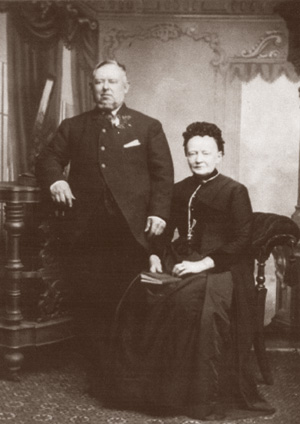
James and Jane (Nutter) Whynall
Jane Nutter (1837-1897) had a son, Thomas Nutter (1850-
1892/1900) before she was married, in 1854, to her neighbor James Whynall
(1829-1900). They had six daughters together; Elizabeth Ellen (1857- ?), Mary
(1859-1859), Eleanor (1862-?), Susannah (1864-1866 ), Ruth (1866-1952)
who was married to John Pickup in 1886 and Sarah Emma (1875-1962 ) who
was married to John Butterworth in 1900. The family moved to the Rochdale
area in the 1880s. From there the Whynall daughters would write letters to
William and Dinah in the USA on behalf of their mother who could not write.
The family returned to Burnley before Jane’s death. Their two youngest
daughters each raised families in Burnley; Ruth Pickup had a son and a
daughter, Sarah Emma Butterworth had two sons and two daughters.
Isabella Nutter (1834-1834) died at the age of five months and
just six months after two of her sisters.
Hannah Nutter (1835-1836) lived only thirteen months.
Rebecca Nutter (1836-1837) was noted as the “eighteenth child”,
but sadly, she only lived two months.
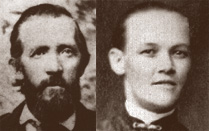
Samuel and Nancy Alice (Nutter) Stanworth
Nancy Nutter (1838-1923) was the only family member William
Nutter was successful in converting to the Mormon faith. She married Samuel
Stanworth (1835-1886) in Burnley in 1886 and they delayed beginning a
family to save for the journey to Salt Lake City with William and Dinah. In
1860 the Stanworths with their infant daughter Elizabeth arrived in
Philadelphia, met William, Dinah and their sons and accompanied them on the
long journey to Utah. On the way, their baby daughter died of whooping
cough and was buried next to the trail. Once in Utah, Samuel and Nancy
Stanworth adapted well to the Mormon ways and stayed in the area around
Salt Lake City for the rest of their lives keeping up only sporadic contact with
William, Dinah and the family. In her widowhood, Nancy married William
Wallace Hammond. Most of her children, Ambrose Nutter Stanworth (born
1861), Nancy Alice Stanworth Hinton (1863-1950), Samuel Nutter Stanworth
(1865-1947), George Washington Nutter Stanworth (1866-1868), John Nutter
Stanworth (1868-1887), James Nutter Stanworth (1869-1941) and Emmanuel
Nutter Stanworth (1873-1949) married and raised Mormon families.
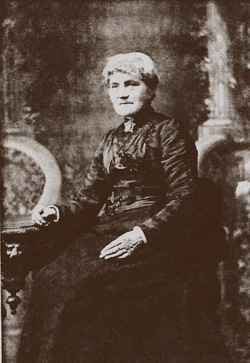
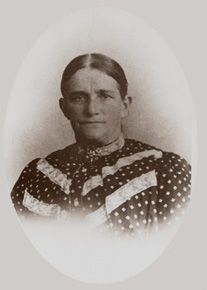
Grace Ingham (left) and Dinah Ingham Barrowclough - Grace's daughter (right)
Grace Ingham (1822-1895) - became the de facto mother to the younger children as
her mother's health and ability deteriorated. She, in fact, found the mother, Olive Heyworth
Ingham, dead in bed when their youngest sister, Mary Ann, was just 6 months old (1840). She
virtually raised Mary Ann and sisters Dinah (age 6) and Margaret (age 3) and also nursed their ailing
brother Thomas (age 16) who died from his tuberculosis five years later. Grace never married but
gave birth to five children. Some of Grace's children "weren't right" and that, combined with some
other family folklore, suggests that as many as three may have been the result of incest with her
father or brother William. Both were alcoholic and both were remembered to be verbally and
physically abusive with her. Grace's two eldest daughters died young; Alice (1845-1851) and Olive
(1849-1862). Her first son, William, died soon after his birth in 1856. Son Thomas (1859-about
1902) married twice and had several children with each wife. Daughter Dinah (1852-1914) was
born as a result of a liaison between Grace and one Levi Ingham (no close relation). Dinah married
John Barrowclough (1850-1933) in 1876 with whom she had nine children and their descendants
remain primarily in England though one grandson did emigrate to Australia where his descendants
still reside. Dinah and Jack always provided a home for Grace whom they revered and respected.
Grace suffered from epileptic seizures most of her life. One of these finally proved fatal to her as
she approached her seventy-third birthday.
Thomas Ingham (1824-1845) - spent almost his entire short life in ill health. He had
tuberculosis and his sisters remembered only that he spent most of his time in bed or in a chair
wrapped up in a shawl. His sisters remembered him with great fondness though; all four sisters
named at least one of their sons after him. (The four sisters honored their mother similarly, each
naming a daughter Olive). Thomas died of a massive pulmonary hemorrhage after his twenty-first
birthday in March, 1845.
William Ingham (1826-1891) - was remembered by his sisters as a tyrant and an
abusive alcoholic. Sadly, some lore passed down through the family suggests he actually may have
fathered at least two of his sister Grace's children. His tyranny over his sisters (except Dinah who
had gotten married) increased after the death of their father in 1855 and his control over their lives
included control over the money they earned in the mills. It is likely he blocked or at least,
delayed, marriages for Grace, Margaret and MaryAnn, protecting these sources of additional
income for a while. However, after MaryAnn eloped in 1860, William was basically left with his
sister Grace and her children in his household. This situation uncomfortably resembled
responsibility for him.
As a result, he proceeded to "wander" (as his sisters termed it) for the next thirty years. He
simply does not appear in the censuses of 1861, 1871 and 1881 anywhere in England. A story
survives that he briefly reappeared in the Pendle area late in the 1860s for some time and was very
ill and infirm. His sisters had no problem turning their backs on him in his predicament.
Ironically, it was MaryAnn's soft-hearted husband William Tattersall who arranged for
accommodations and care for William Ingham until he was well again. William Ingham then
appears to have continued his "wanderings" until his final illness early in 1891. He is known to
have briefly lived at 12 Thorn Street in Burnley. He worked as a coal miner until his condition
deteriorated to the point that he required constant care. He then entered the Burnley Union
Workhouse, a sort of hospital and convalescent care center for the indigent. The resident doctor at
the workhouse diagnosed “enteritis", a general term for gastro-intestinal disease which, in his case,
was likely the result of years of alcohol abuse. He was desperately ill for at least a month.
Nevertheless, none of his sisters visited or gave him any assistance whatsoever. Only his niece,
Susan Tattersall (daughter of his sister MaryAnn and the aforementioned William Tattersall) looked
in on him sporadically. At an age similar to his father and from basically the same illness, William
Ingham died on 14 April, 1891. His niece Susan bought a grave for his burial at Wheatley Lane
Cemetery near where the family called home. His sister MaryAnn joined him there in that grave
thirty-three years later. Susan was buried there fifteen years after that.
Henry Ingham (1831/2-1833) - was "above a year old" when he was baptized on 16
April, 1833. It was odd that he was baptized at all; his eldest sister Grace was the only other one of
the Ingham children ever baptized. Only another entry in the burial registers five days later would
explain why he was christened; "On 21 April, 1833, Henry, son of William & Olive Ingham of
Wheatley Lane, above a year old, was buried (scalded to death)". Henry was apparently only
baptized following the accident which precipitated his death; he had fallen into a mop bucket of
scalding hot water. One can only imagine the horror of the incident itself. Can we possibly
comprehend the four days that followed as the parents and elder siblings watched the horrendously
disfigured child slowly and painfully die? Nearly eighty years later, his younger sister (who was
yet unborn at the time of his death) would bolt from her chair when her own great -grandchild, a
toddler, ventured too near a bucket of hot water. Her dramatic response spoke volumes about how
indelibly the incident had to have been etched into her mind - merely from the retelling of it.
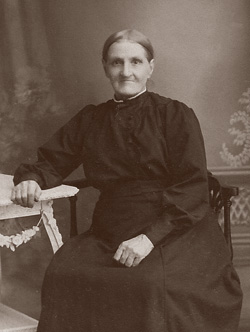
Margaret (Ingham) Simpson - circa 1919
Margaret Ingham (1837-1929) - along with her elder sister Dinah, for some reason Margaret
seems to have enjoyed immunity from their father's alcoholic abuse. The net result was a
childhood alliance between the two sisters. It did not last through their long adulthoods though.
After Dinah married and began a family of her own, Margaret followed in the footsteps of their
sister Grace giving birth, without marrying, to a son, Thomas, on 1 June 1854 while she was still
just sixteen years old. The child's father may have been the man she later married but it was a moot
point as her own father and brother did not allow her to marry. It is likely not coincidental that
Margaret finally did marry just over three months after she turned twenty-one and could therefore
marry whomever she wished. With husband Thomas Simpson (1822-1897), a farm laborer, she
had three daughters and one more son born at Royal Oak in Barrowford. When her sister Dinah
returned from America in 1865, their relatively brief reunion turned sour in the months that
followed. Dinah had named the daughter she gave birth to in December of that year "Margaret" but
poignantly changed the child's name to Elizabeth shortly thereafter. Whatever the cause of the rift
between the sisters is forever lost to history, but the antipathy between Margaret and Dinah also
extended to Grace and MaryAnn resulting in Margaret's complete estrangement from all of her
siblings despite the fact that she lived within a mile or two of her sisters Grace and MaryAnn for the
remainder of their days. Margaret's husband, Thomas Simpson died in March, 1897. After a night
of drinking at a local pub, he died after passing out face first in what was little more than a puddle.
Margaret continued to live at their home at 7 Mount Street in Barrowford among her family.. Her
one daughter Mary Procter, who married and had a family, occupied the house next door. As the
final count for Mary's family reached an even dozen, her family spilled over into Margaret's house
in her old age and even a few great-grandchildren were among the visitors or short-term residents at
Margaret's house. She died a few months short of her ninety-second birthday in April, 1929.
Sadly, her children did not inherit her relatively extreme longevity. Elder son, Thomas Ingham
(1854-1929), died the same year as his mother having married and fathered at least two daughters
and two sons. Younger son, Robert Simpson (1869-1952), never married and was a farm laborer
all of his life in the area of Barrowford. Daughter Margaret Jane Simpson (1862-1930) married
Thomas Duerden but had no children and died just the year after her mother and brother. Daughter
Olive Simpson (1863-1864) had died young in a typhoid epidemic. Daughter Mary Simpson
(1865-1934) married in 1885 to William Procter and gave birth to twelve children but only eleven
grandchildren populated the next generation. The family remained mostly in England except for
Alice Procter (1896-1964) who married a minister, Frank Hartley (1895-1971) in 1922. The
following year, they emigrated to the Upper Peninsula of Michigan where their son and daughter
were born. Their son died in service during World War II when his ship was sunk off the coast of
Algeria. Their daughter still lives in Michigan with her husband, a retired physician. Most of their
five children and grandchildren live outside Michigan in Pennsylvania, Colorado and
California.
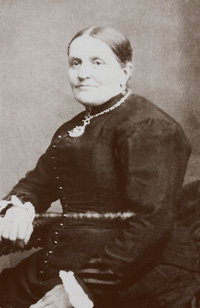
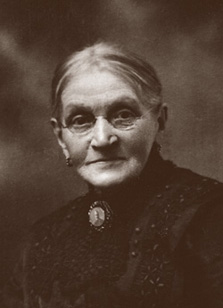
MaryAnn Ingham Tattersall Bottomley - circa 1880 (left) and 1910 (right)
MaryAnn Ingham (1839-1924) - was exactly six months old when, on 24 February,
1840, her cries woke up everyone in the family's home. Eldest sister Grace discovered the infant
still attempting to nurse from their mother who had died during the night. It appears that the abuse
that followed, first from her father (who blamed her for his wife's death), then later from her
brother, did not break her spirit. In fact, later in life she would credit her emotional survival to the
love and kindness of her sister Grace in addition to the affection, support and love she later
received from a local lad, William (Bill) Tattersall. She married Bill Tattersall (1840-1869) in 1860,
not coincidentally, the week after her twenty-first birthday. A month later, she gave birth to her
second daughter with Bill, followed by three more daughters and a son during their brief, idyllic
marriage. Clearly, Bill Tattersall was the love of MaryAnn's life. The mere mention of his name,
even when MaryAnn was elderly, would unfailingly bring a tear to the steely old woman's eye. In
1869, a thief slipped poison in his ale at a local pub as he returned from his aunt's funeral, took
him into the back street and there he relieved him of his money, his gold watch and his suit. Taken
to his home in Greenfield, Colne, MaryAnn took care of him until his death less than a week later.
Thus began the most dreadful decade in MaryAnn's life. At first, Bill's father, now over seventy,
was of great assistance in caring for the younger children. As the years passed however, the old
man became child-like himself. Then MaryAnn took solace from Bill's best friend and her boss,
Albion Hartley, a married man. (Later, he became the father of Wallace Henry Hartley, the
bandmaster on the HMS "Titanic"). MaryAnn had twin boys with Hartley whom she named
Thomas and William. One child lived a day, the other lived eleven months. Naturally, she felt the
need to put some distance between her, Albion Hartley and the scandal - she moved to the Burnley
Lane area of Burnley a few miles away and lived there the remainder of her life. Then she met
James Bottomley (1824-1890) an older, recently widowed mill worker with a family similar in size
to hers. They married in the summer of 1876 when she was six months pregnant and blended their
families together with little success. After she had two sons with Bottomley and endured two years
of chaos and abuse, MaryAnn left him taking with her the eight children. She set up her own
household just in time for a thirteen week long cotton-operative strike which brought the family to
the brink of starvation. Gradually thereafter, she settled into the roles she enjoyed the rest of her
life; head of the household, grand matriarch of an extended family and well-known character in the
neighborhood. MaryAnn was a respected midwife in the area and would often prepare the dead to
be laid out and buried. She never took any money for her services and actually never worked for a
wage of any sort after the mid-1880s. Instead, her family dutifully "tipped-up" their wages to her
which she used to run the household and the wage-earners in turn were granted an allowance. She
raised several grandchildren in her home and the extended family reveled in her stories, her acerbic
wit and regularly sought out her company and mostly deferred to her opinions. At the turn of the
twentieth century, a series of emigrations began among MaryAnn's family. Eventually, three of
MaryAnn's children went to the United States and the vast majority of her grandchildren would
settle there or in Canada and New Zealand. MaryAnn herself visited the United States in 1904 and
1912, the second time being the occasion of a reunion with her sister Dinah Nutter after a 46 year
separation. After MaryAnn returned to England, she remained vital and healthy. She "held court"
day and night with frequent visits from various family members. She assisted her daughter in the
shop she had purchased and chatted with customers who came in for the midday meal. She carried
on what appeared to be a courtship with Jack Barrowclough (1850-1933), the widower of her niece
Dinah. She smoked a pipe, played innumerable games of dominoes, took snuff and occasionally
used cocaine as an elixir. Her health remained robust until her last few days. On 10 January,
1924, a bout with pneumonia proved fatal nearly halfway to her eighty-fifth birthday.
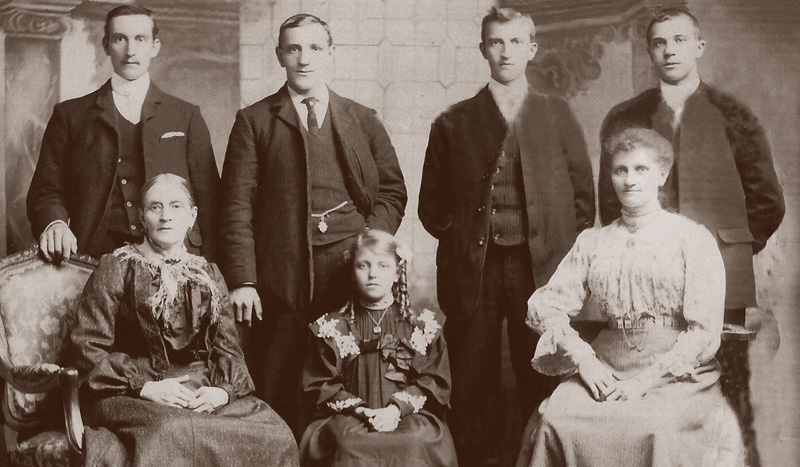
All members of MaryAnn Ingham Tattersall Bottomley's household in 1906; left to right, standing;
son, Tom Tattersall; grandson Charles Holden; son Willie Tattersall; grandson John Albion Holden;
seated, left to right; MaryAnn; granddaughter Alice Holden; daughter, Olive Tattersall Holden
MaryAnn had six children with her first husband, William Tattersall and two with her second
husband, James Bottomley. However, when she left her second husband, she never divorced him
but did reassume her first husband's surname and eventually changed the surname of her two
children by James Bottomley to Tattersall. Some abridged information on MaryAnn's children and
their families is as follows;
Alice Ingham (1858-1930) - married William Henry Totterdell (1855-1906) and had seven
children of whom four survived infancy. She remained in England and never travelled abroad,
living rather meagerly until she married secondly to Friend Goddard (1865-1933) in 1921. Her
eldest son Charles Totterdell (1880-1921) also remained in England as did his two children, both of
whom died childless. The younger son Walter Totterdell (1896-1938) moved to Lima, Peru,
working as an engineer on a steamship. His widow and two daughters eventually resettled in
Halifax, Nova Scotia. Some of their descendants still live near there, but most live near Vancouver
British Columbia. Alice's elder daughter Grace Totterdell (1891-1968) married a French Canadian,
emigrated to Bermuda, then Pennsylvania, then Ontario and died childless. Her younger daughter
Ethel Totterdell (1894-1983) emigrated to New York, then Bermuda, then Australia, then Bermuda
again, then Virginia, then Mexico, then Virginia again. Her one son by the first of her two
husbands lives in Bermuda. His children live in Bermuda and South Africa.
Susan Tattersall (1860-1939) - moved with her brother to Lewiston, Maine in 1889 but returned
to England soon afterwards. She joined her sister and brother in Connecticut years later but
ultimately returned to England in 1919. She never married.
Olive Tattersall (1862-1934) - married William Henry Holden (1862-1944) in 1882 but his
alcoholism and her mother's dislike for him caused the marriage to fail a little over two years later.
She never divorced him but made her home with her mother for the next four decades. She
worked in cotton mills for years but finally bought a shop in Burnley which doubled as a small
cafe. She traveled extensively in 1925 and 1926 visiting relatives in Ontario and British Columbia,
Canada and then in New England in the USA. She retired thereafter and lived with her sister Susan
in Brierfield, near Burnley until her death. Her eldest son Charles Holden (1883-1936) emigrated
to Indiana, then Connecticut and Rhode Island in 1910 where his family of four remained as do
some of their descendants. Others are in Massachusetts, California, Ohio, South Carolina and
Missouri. Her younger son John Albion Holden (1885-1967) emigrated to Connecticut in 1910 but
returned to England in 1912. He emigrated again with his family in 1923 to Ontario, Canada, then
Michigan. His descendants are in Michigan, Delaware, Indiana, Nevada, California and Toronto,
Ontario, Canada. Olive's only daughter Alice Holden (1894-1988), who was the result of her
relationship with Mark Lund, married a Canadian and emigrated to Vancouver, British Columbia,
where she spent the rest of her life. Her only son drowned at age 14.
Sarah Tattersall (1865-1936) - married Henry Windle (1861-1923) in 1885. She lived her entire
life in the area of Burnley. She accompanied her mother to New England in 1904 and traveled to
Australia once and to New Zealand twice after her daughters had emigrated there. Her elder
daughter Susy Windle (1886-1981) made her fortune in New Zealand where her two daughters and
five granddaughters were born. Some of her descendants now live in Australia and some are also
in Florida in the USA. Her younger daughter Mary Windle (1891-1965) had a son and a daughter.
The son married late in life and died childless in Australia. The daughter died in New Zealand
leaving a son and daughter who are both childless.
Albion Tattersall (1867-1925) - married Martha Jane Lund (1865-1933) in 1886. Albion
emigrated to Lewiston, Maine in 1889 with his sister, Susan, but returned to England shortly
thereafter. He emigrated again in 1900 to Pawcatuck, Connecticut where he prospered. For a while
he worked in the local weaving trade but eventually bought a saloon and became very influential in
local politics. It was he who arranged the reunion between his mother and her sister Dinah Nutter
in 1912 and his summer cottage at Watch Hill in Rhode Island was where the sisters stayed together
for an extended time. Albion and Martha had six children of whom only two survived infancy.
Son William Tattersall (1887-1942) worked in the textile industry all of his life. He was father to
seventeen children who all remained in the area during their working lives; however, the
grandchildren are now spread across more than 20 states. Albion's daughter Olive Blanche
Tattersall (1894-1977) had two sons of whom one was killed in World War II at the Battle of
Casino. The other son and his descendants remained in the area.
Grace Tattersall (1868-1947) - married Benjamin Haworth (1870-1953) in 1896. They emigrated
several years later to Connecticut, then to Rhode Island where her husband continued to work as a
boiler operator and engineer. Grace engineered very successful investments and they became
comparatively wealthy. She also was a voracious reader and avidly followed current events and
the arts. Many family members and friends were beneficiaries of her philanthropy. The Haworths
had only one daughter who in turn had only one daughter. She has no children and lived on Cape
Cod, Massachusetts.
Tom (Bottomley) Tattersall (1876-1925) - married Ellen Hewitt (1881-1953) in 1906. He
worked as a winder in the local coal pits. He committed suicide in the wake of difficult divorce
proceedings leaving his widow with six children to raise (three others had died in infancy). All of
the family remained in England, mostly in the area of Burnley. Edna Tattersall (1911-1999) had
two daughters. Tom Tattersall (1912-1985) had one daughter. Clifford Tattersall (1915-1999) has
a son and a daughter and is the only one of his siblings to have grandchildren and great-
grandchildren. Clarence Tattersall (1916-1944) was shot down near Liesse, France in World War
II. Ada Tattersall (1920- 2008) died a widow and was childless. Edmund Hewitt Tattersall (1922-
2003) was survived by a daughter who died childless.
William (Bottomley) Tattersall (1878-1950) - married Annie Elizabeth Wiseman (1881-1968) in
1911. It was, in fact, this marriage which precipitated his mother's petulant and impulsive journey
to the USA in 1912. "Willie" and Annie had no children. They oversaw the settlement of several
of Willie's half-sisters estates as none who remained in England had children living locally. As a
result, Willie and Annie ended up owning the shop and three adjacent homes in Burnley and other
real estate. Before World War II, they sold it all and moved to the English resort town of Blackpool
where they lived until their deaths.
The Lancashire Dialect
Throughout this book, there are a number of references to the Lancashire Dialect spoken by
William Nutter and Dinah Ingham as they grew up and into adulthood. This chapter is being written
to further clarify what the dialect is, facilitate some understanding of it and give some examples of
it. Though volumes upon volumes have been written on this subject, this will be but a brief
introduction to the mode of speech the family used, which is part of the family heritage.
The dialect is not a matter of English with some sort of strong accent. It is, in fact, almost an
entirely different language. There is evidence that William and Dinah would revert to their "old
way" of speaking if they wished the children not to understand what they were talking about.
One demonstration of how profoundly different the dialect is from our spoken American
English (while still, nevertheless, being English) is the following scenario. If any one of the Nutters'
descendants could be transported back in time to 1853 (when Dinah was still illiterate), most of
what Dinah had to say would be utterly unintelligible to them. Yet ironically, it is likely Dinah
would actually understand most of what the person from the twenty-first century had to say
provided they didn't speak of televisions, airplanes, etc.
Some have challenged me on the idea that an illiterate dialect speaker might understand
someone speaking "standard" English yet comfortably speak a dialect. However, an etymologist (a
language expert) agreed with me and an episode in my own personal life verified it as well. In the
1970s, a custodian where I worked was an illiterate black gentleman from Alabama. He
understood my mid-western accent and I understood his Alabama accent. But his cousin showed
up one day at his work and these two guys spoke "country" - their dialect - between themselves. I
had no idea what they were saying.
Possibly the most essential difference in the Lancashire dialect is the use of "thee" and "thou" in
regular conversation. Both German and French and, for that matter, several other languages have
two words for "you" - one formal, one familiar. Most of us recognize these terms from their use in
prayer instead of "you". While it may seem formal in prayer and, therefore counterintuitive, "thee"
and "thou" are, in fact, the "familiar" form of "you". The theory was that, when one talks to god,
one should use the familiar form out of love for their heavenly father.
But dialects grow out of convenience of speech so the mouthfuls "has thou", "art thou" and
"will thou" become "asta" and "arta" and "wilta". Dialect speakers would say
"Wur asta bin?" (Where have you been?), "arta gooin' 'oom?" ("are you going home?")
and "wilta be thur?" ("will you be there?").
They also don't say "something", "anything" and "nothing". It's "summat", "owt" and "nowt".
They signify the beginning of a thought or sentence with "nay", "'ey", "'ey up"
or "'appen" for "perhaps". They often add "like" at the end for no good reason at all.
They practice a peculiar economy in seldom using the whole word "the". Instead, they blend it
in with the adjacent word. "Appen 'e'll goo to't shop like" means "Perhaps he'll go to the store".
"Ey, asta got owt from't shop?" means "Have you gotten anything from the store?". "Nay, Ahv left
th'oven dooer oppen" means "I have left the oven door open".
Then there are differences in pronunciation. The Lancashire dialect speakers dislike the letter
"L" unless it begins a word; "old Liverpool and Bolton" is pronounced "owd Liverpoo' and
Bowton". A "U" is almost always said with one's lips thrusted out as is a double "O". "Cook" and
"Book" rhyme with "Duke". A double "T" in the middle of a word is much like a glottal stop -
making a bottle sound more like a "bokkul".
Very seldom is something "good" in Lancashire. Rather, it is "gradely" or "grand" (pronounced
"grond"). "Very" is seldom used as an intensifier - never is anything "very grand" or "very
gradely". It is "right grand" or "right gradely" - but "right" must rhyme with "eight".
"Fur" is another intensifier used instead of "quite". So, if you're "flaid" (frightened)
of someone but really frightened of someone else, then you're "fur-flaid" of the someone else.
Families consist of a "fayther" (or, in some villages,"father" rhyming with "gather"),
"mootha" (or "mum") and "t' childer". Sometimes there was a "Grondad" or
"Grammar" and "broothers" and "sesters". Whenever someone refers to someone in
their own family, they claim them as "our" Tom or "our" Alice. However, when children are
little, they are, with great affection, called "it" as in "give it summat ta eight" (give
it something to eat).
Lancashire dialect speakers love the shortest way through a thought, sometimes adopting ugly
little Scandinavian words instead of the old Germanic stand bys. One's mouth, ears, teeth and head
suddenly become a gob, lugs, peggies and a noggin.
One has to wonder why they have so many terms for being drunk: druffen, bottled, sozzled,
tight, palatic (a corruption of paralytic). The same question arises for the numerous terms for
stupid; gawmless, daft, dozy, barmy, pottie, simple and thick.
A good fight has several names as well; bash, baste, lambaste, punch-up, paste
and wallop.
In Lancashire, if you're pleased or happy, you're "chuffed" or "fain". If you're not, you're
"dischuffed" and perhaps you "have a face like a wet week". If you're worried, you're "mithering".
If you're deprived, you're "oined".
Clearly, the Lancashire dialect is much more than a strong accent. It was a colorful pallet which
William and Dinah Nutter, along with their families and neighbors, used in regular conversation
among themselves. Their often somewhat limited knowledge of "formal" English was reserved
mainly for church, school, letters and legal proceedings. Most folks were able, but not necessarily
comfortable, with the "formal" language.
If Dinah could speak to you about her family from 1853, it might sound like this;
Ey, Ah 'am reight fain to sithee lad (lass). Asta eerd owt abeht me famly? Futch tha cheer up
to't table - sit thee deawn.
Me fayther were a weigh-ver an bootcher cowd Willyum Hingum. 'E is allus fur addled wi'
suppin' ale. Tha' knaws 'e'll drink 'issel' to't dee-ath!
Me brootha Will's a baddun but air Tom were allreight. 'E wur allus poorly. 'E deed as 'e made
up full age. Mogret and air MurryAnn were babbies when us moother deed. Air Grace wurt best.
She wur lak a moother to uzall. "Ers 'ad childer but she in't wed.
A careful read through the last three paragraphs may produce some understanding of what's
being said. The real test is to have someone read it to you. Chances are slim you'll be able to
understand much, if anything.
In "English", the translation is as follows;
I am very glad to see thee lad (lass). Have you heard anything about my family? Fetch your
chair up to the table and sit down.
My father was a weaver and a butcher called William Ingham. He is always quite addled from
drinking ale. You know, he will drink himself to death.
My brother Will is a bad one but Tom was alright. He was always ill. He died as he turned full
age. Margaret and our MaryAnn were babies when our mother died. Our Grace was the best. She
was like a mother to us all. She has had children but she isn't married.
For those with access to a computer, there are numerous sites dedicated to the Lancashire
accent. Some even feature recordings which allow one to actually listen to the spoken dialect. Of
course, there is always the alternative of traveling to the Pendle area of Lancashire and listening to
the local folk. Virtually everyone who visits the land of our ancestors falls in love with it, the
people and even their unusual manner of speech.
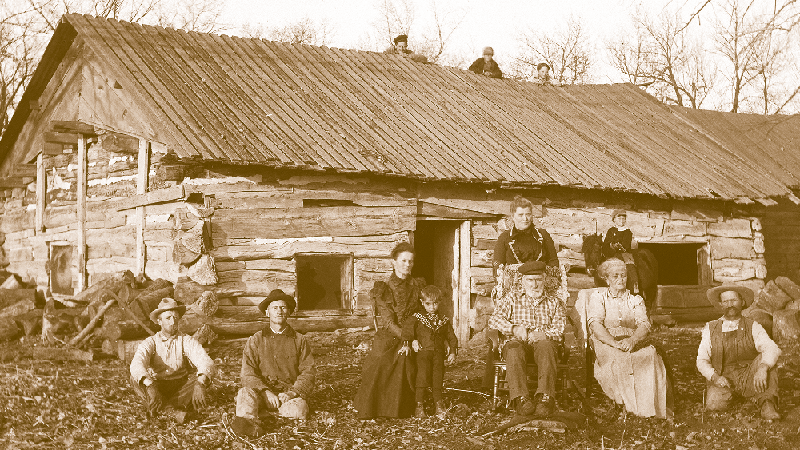
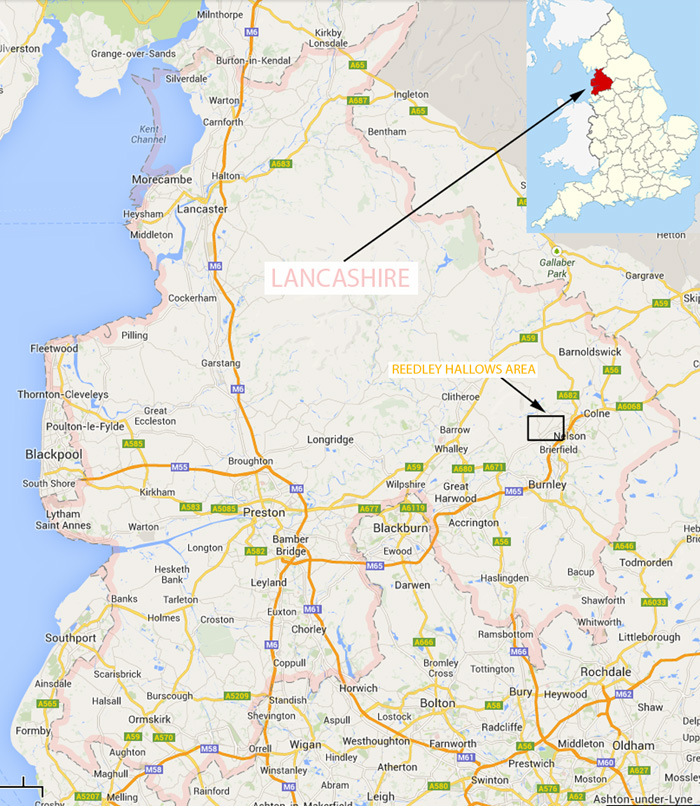
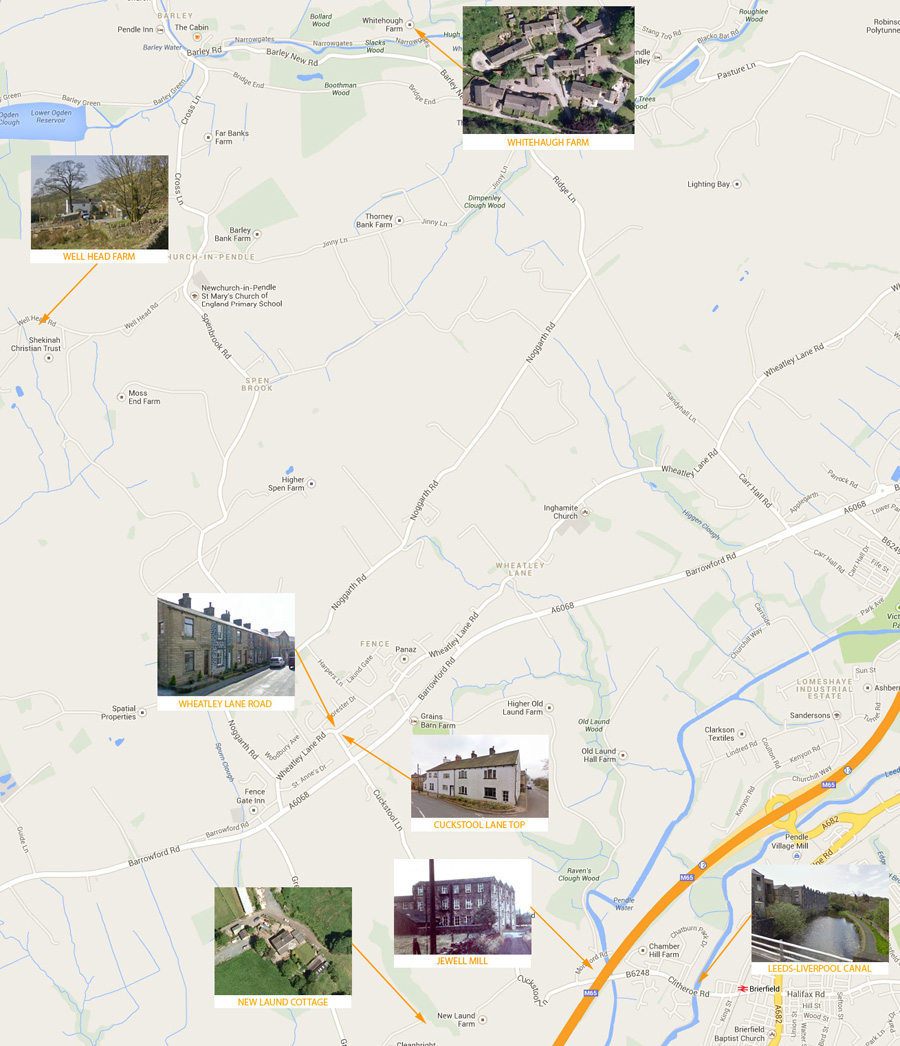
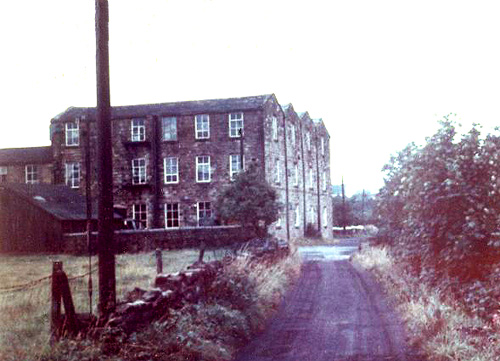
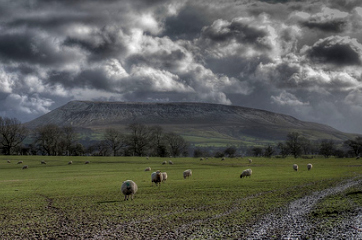 Pendle Hill (viewed from the north northeast)
Pendle Hill (viewed from the north northeast)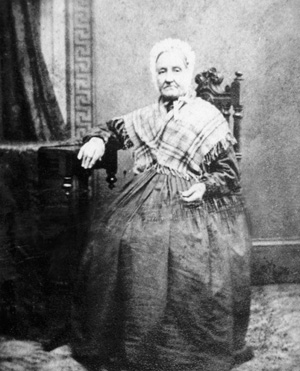
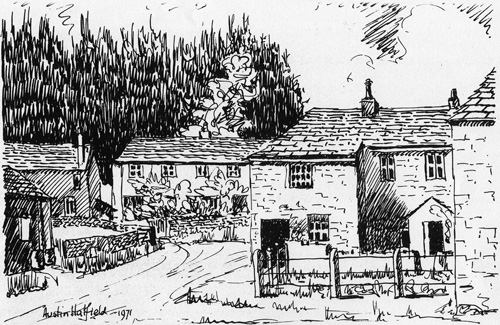
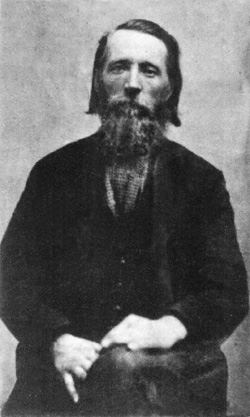
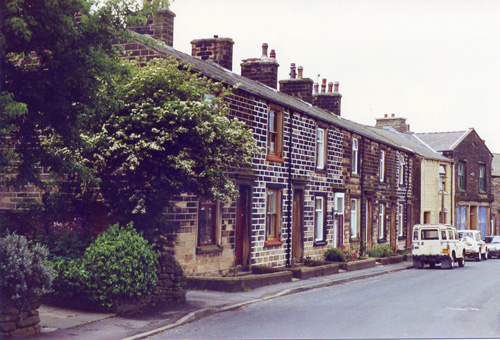
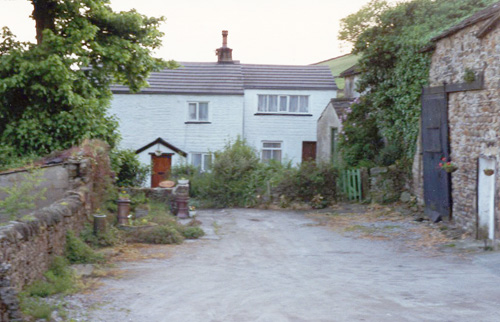
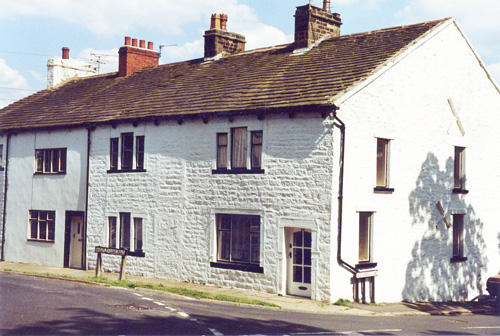
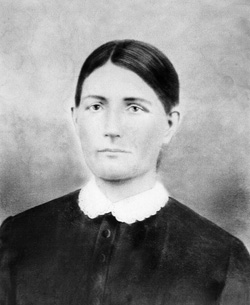
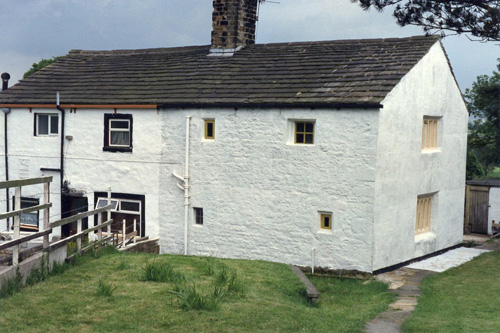
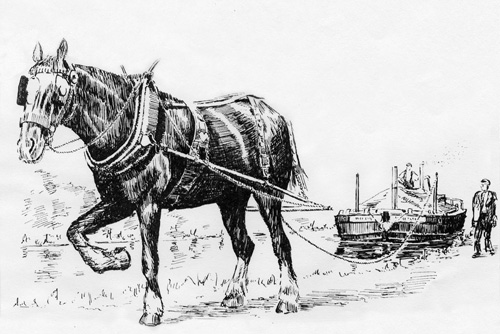
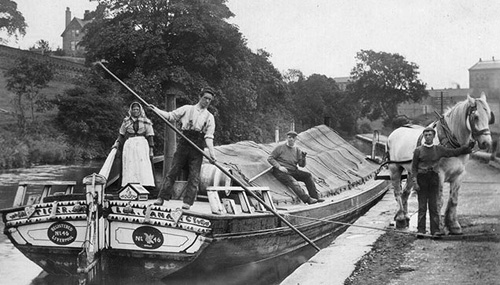
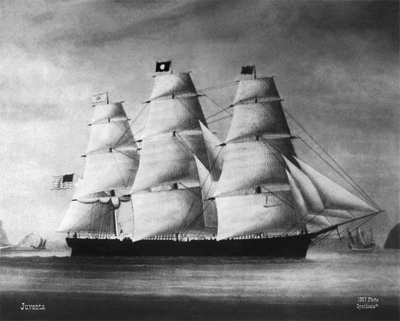 The Juventa - The Juventa was of U.S. registry. It had the capacity to carry a load of 1,187 tons.
Its rigging type classified it as a ship. It was built at Thomaston, ME. The ship was owned by the
Eastern Star Line & the Black Diamond Line. The Juventa departed Liverpool, England on Saturday
March 31, 1855. It arrived 35 days later at Philadelphia, PA on May 5, 1855. The ship master was
A. Watts and the LDS company leader was W. Glover. There were 573 LDS passengers. According to
The Juventa - The Juventa was of U.S. registry. It had the capacity to carry a load of 1,187 tons.
Its rigging type classified it as a ship. It was built at Thomaston, ME. The ship was owned by the
Eastern Star Line & the Black Diamond Line. The Juventa departed Liverpool, England on Saturday
March 31, 1855. It arrived 35 days later at Philadelphia, PA on May 5, 1855. The ship master was
A. Watts and the LDS company leader was W. Glover. There were 573 LDS passengers. According to
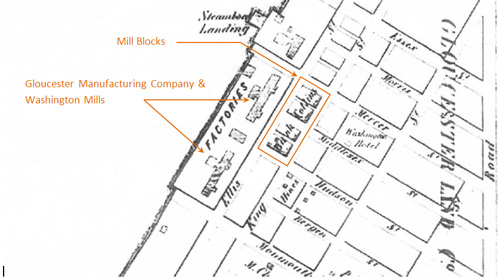
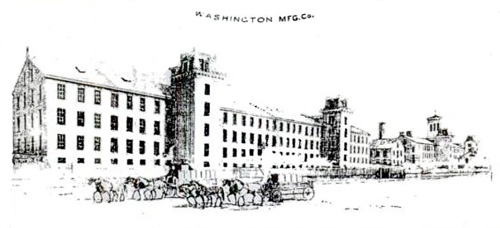
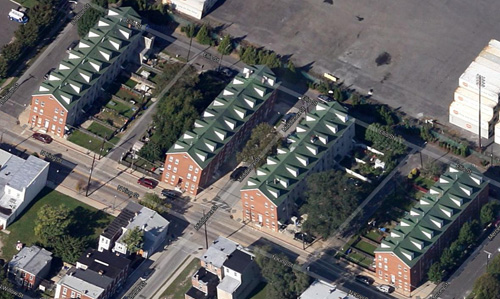
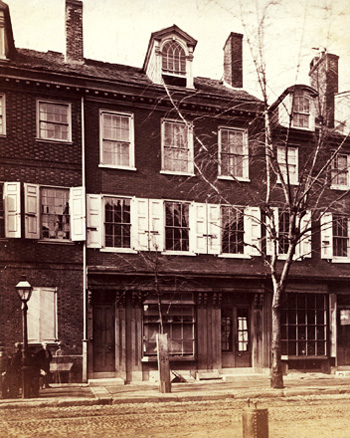
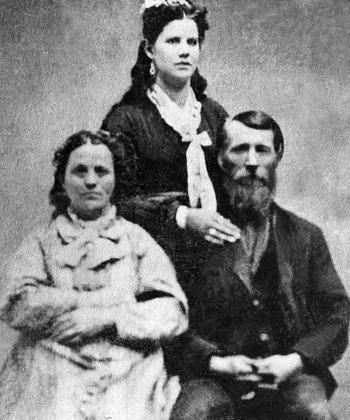
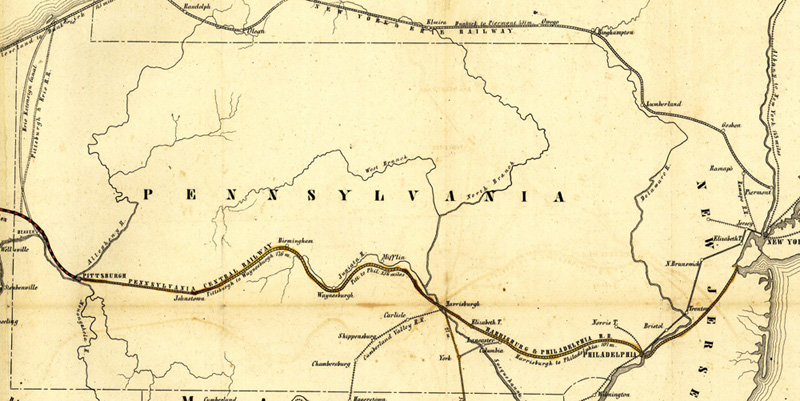 The Nutter party likely travelled by rail from Philadelphia to Pittsburgh. The first leg would have been on
the Harrisburg & Philadelphia Railroad, and the second leg on the Pennsylvania Central Railway.
The Nutter party likely travelled by rail from Philadelphia to Pittsburgh. The first leg would have been on
the Harrisburg & Philadelphia Railroad, and the second leg on the Pennsylvania Central Railway.
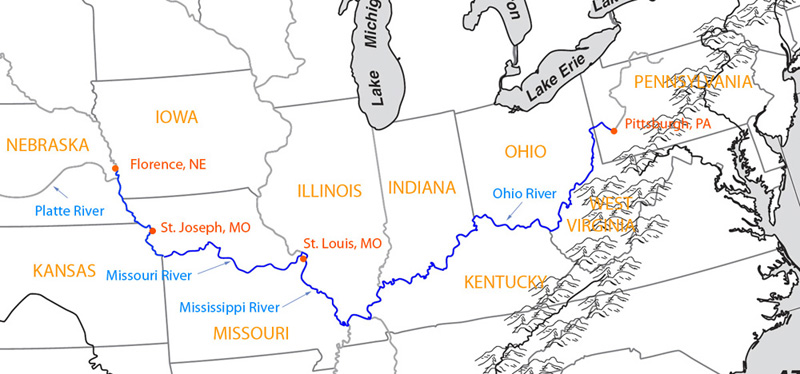 The river travel of the Nutter party on their way to Salt Lake City. From Pittsburgh down the Ohio
to the Mississippi, up the Mississippi to the Missouri, and up the Missouri to Florence, Nebraska.
The river travel of the Nutter party on their way to Salt Lake City. From Pittsburgh down the Ohio
to the Mississippi, up the Mississippi to the Missouri, and up the Missouri to Florence, Nebraska.
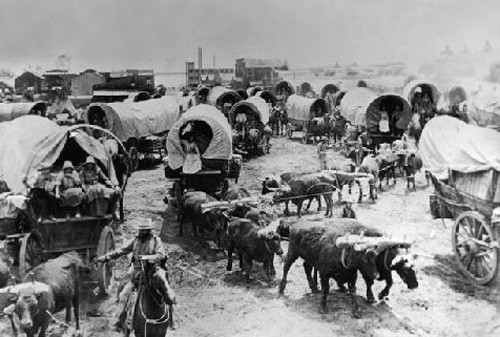
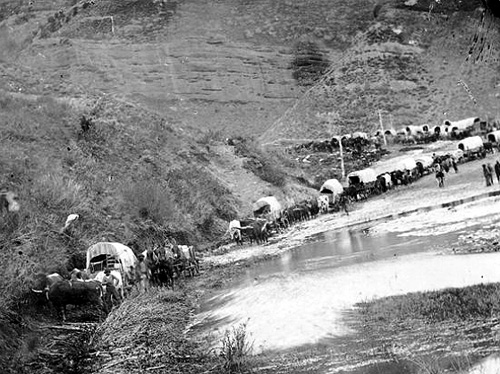
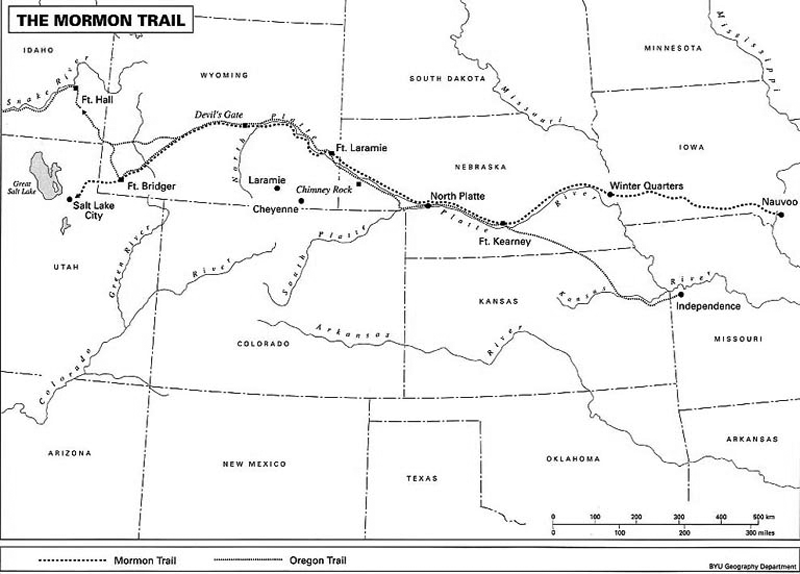
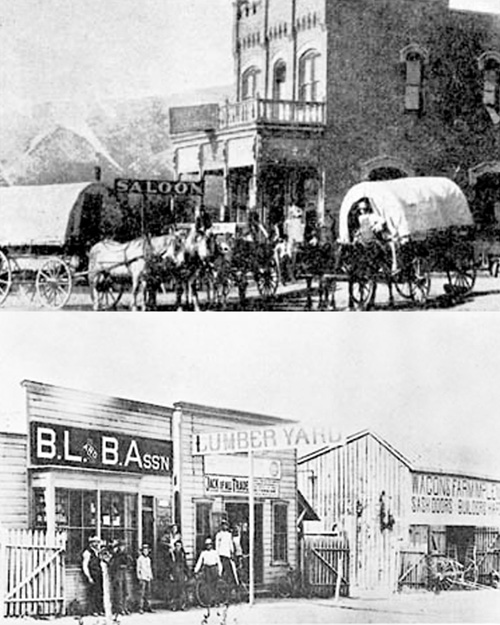
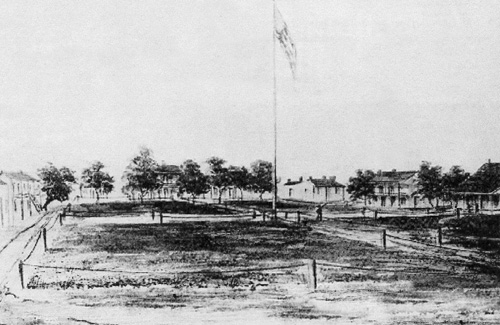 Artist's rendering of Fort Kearny
Artist's rendering of Fort Kearny
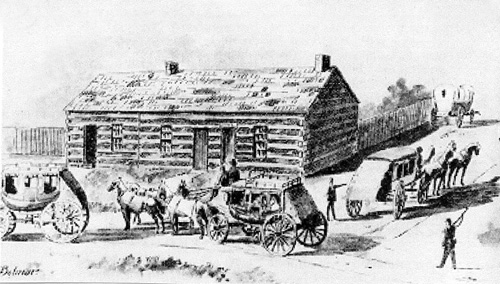 The stage station at Fort Kearny, 1863.
The stage station at Fort Kearny, 1863.
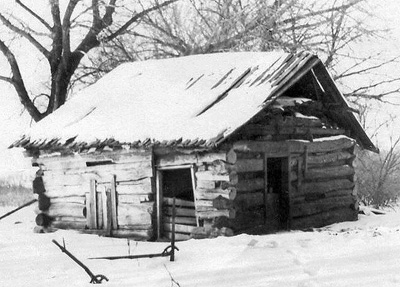
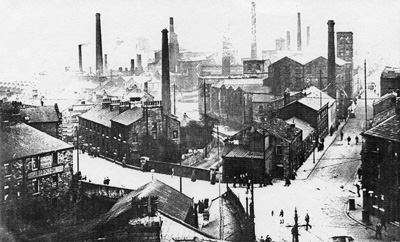 The Westgate area of Burnley where the Nutters lived in the months before returning to the USA.
Is it really any wonder that the Great Plains held an allure for the family?
The Westgate area of Burnley where the Nutters lived in the months before returning to the USA.
Is it really any wonder that the Great Plains held an allure for the family?
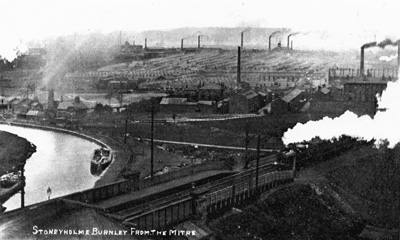 A view of Burnley from the southwest. Note the canal at left and the innumerable row houses in the
distance. Both William and Dinah were born in the area of the rolling farm land in the distance.
Burnley is located in a valley surrounded by beautiful green hills in virtually every direction.
A dense pall of smoke and soot often obscured the view from town.
A view of Burnley from the southwest. Note the canal at left and the innumerable row houses in the
distance. Both William and Dinah were born in the area of the rolling farm land in the distance.
Burnley is located in a valley surrounded by beautiful green hills in virtually every direction.
A dense pall of smoke and soot often obscured the view from town.
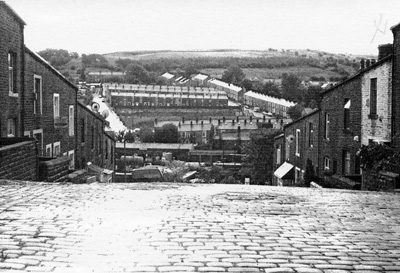 On the rare clear days in Burnley during its industrial heyday, one can see that the lush green
countryside was not that far away.
On the rare clear days in Burnley during its industrial heyday, one can see that the lush green
countryside was not that far away.
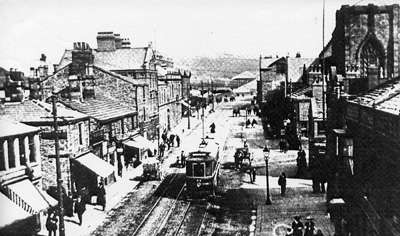 William and Dinah's home at 18 Anne Street was just behind the buildings on the right. This photo,
taken in the early 1900s was taken from the viaduct which carries the "straight mile" portion of
the Leeds-Liverpool Canal over busy Yorkshire Street.
William and Dinah's home at 18 Anne Street was just behind the buildings on the right. This photo,
taken in the early 1900s was taken from the viaduct which carries the "straight mile" portion of
the Leeds-Liverpool Canal over busy Yorkshire Street.
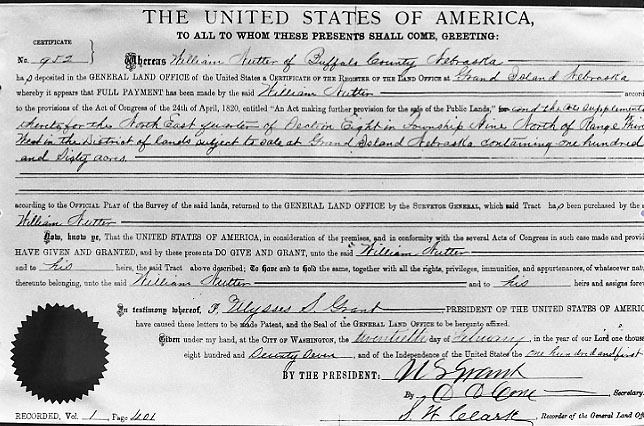 Land grant for 160 acres issued to William Nutter by President Grant in 1877.
Land grant for 160 acres issued to William Nutter by President Grant in 1877.
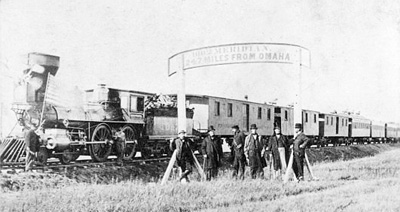 Train typical of the times. Shown here are the Directors of the Union Pacific Railroad on the 100th
meridian 247 miles west of Omaha,
Nebraska Territory. The train in background awaits the party of Eastern capitalists, newspapermen,
and other prominent figures invited by the railroad executives. By John Carbutt, October 1866
Train typical of the times. Shown here are the Directors of the Union Pacific Railroad on the 100th
meridian 247 miles west of Omaha,
Nebraska Territory. The train in background awaits the party of Eastern capitalists, newspapermen,
and other prominent figures invited by the railroad executives. By John Carbutt, October 1866
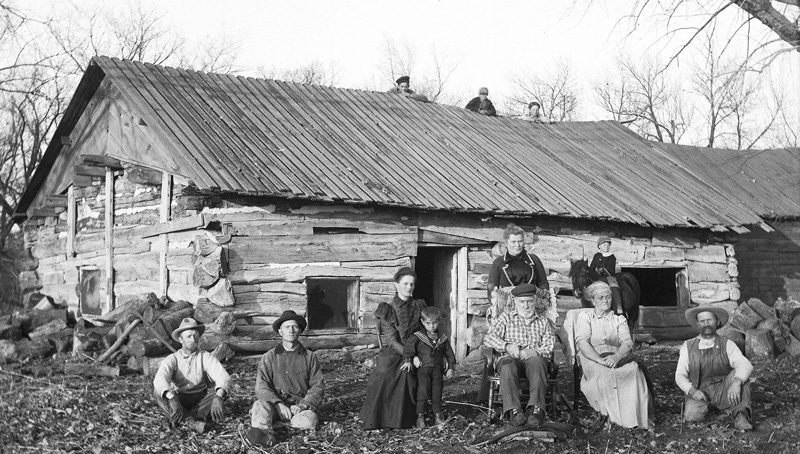 Some of the Nutter family in front of the cottonwood log cabin that had been their home from 1869 to 1888.
This photo, taken in 1903 shows the additional room built by William Nutter, at the far right. From left
to right are Walter Scott (a neighbor); B.F. "Frank" Nutter; his wife Katharina Link Nutter; their son,
Lyman Nutter; William Nutter (seated) with his daughter, Elizabeth Robertson (behind); Dinah Nutter
(seated) in front of Banks Nutter (son of William Nutter the younger) astride a horse behind her;
then William Nutter the younger at the far right; Across the roof are Elizabeth Robertson's sons
(left to right); Lorton, Robert and Benjamin.
Some of the Nutter family in front of the cottonwood log cabin that had been their home from 1869 to 1888.
This photo, taken in 1903 shows the additional room built by William Nutter, at the far right. From left
to right are Walter Scott (a neighbor); B.F. "Frank" Nutter; his wife Katharina Link Nutter; their son,
Lyman Nutter; William Nutter (seated) with his daughter, Elizabeth Robertson (behind); Dinah Nutter
(seated) in front of Banks Nutter (son of William Nutter the younger) astride a horse behind her;
then William Nutter the younger at the far right; Across the roof are Elizabeth Robertson's sons
(left to right); Lorton, Robert and Benjamin.
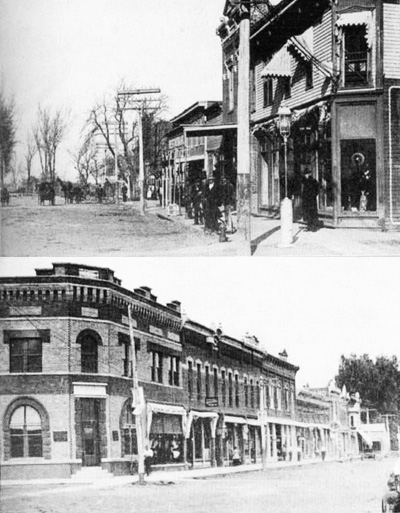 The Nutter homestead was almost equidistant from Gibbon, Nebraska (to the west) and Shelton, once
called Wood River Center, to the east. These are early street scenes of Shelton.
The Nutter homestead was almost equidistant from Gibbon, Nebraska (to the west) and Shelton, once
called Wood River Center, to the east. These are early street scenes of Shelton. 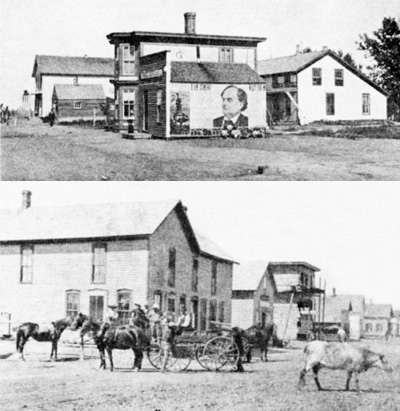 Gibbon photos taken in 1881.
Top: Looking east on Front Street from Gilmore Street. Left to right are the S.D. George general
store (1871); W.H. Kelley harness shop
(1871); the bank building (1881); the post office, built by Christopher Putman; and a hotel
built by George Gilmore.
Bottom: Westward view along Front Street. Left to right are the first building in Gibbon, the LaBarre
store and hall (1871); an unknown small building, L.J. Babcock hardware store (under construction),
D.H. Hite drug store and residence; I.N. Davis store; S.B. Lowell store.
Gibbon photos taken in 1881.
Top: Looking east on Front Street from Gilmore Street. Left to right are the S.D. George general
store (1871); W.H. Kelley harness shop
(1871); the bank building (1881); the post office, built by Christopher Putman; and a hotel
built by George Gilmore.
Bottom: Westward view along Front Street. Left to right are the first building in Gibbon, the LaBarre
store and hall (1871); an unknown small building, L.J. Babcock hardware store (under construction),
D.H. Hite drug store and residence; I.N. Davis store; S.B. Lowell store.
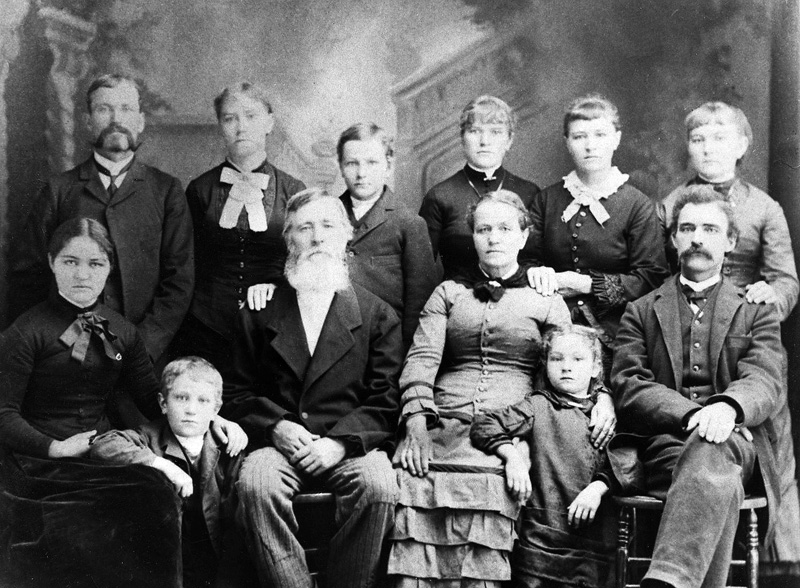
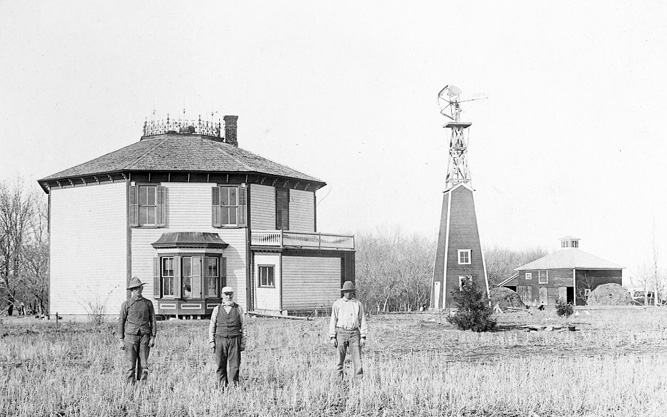 The Nutter farm (taken about 1890). In the foreground (left to right) are B.F. "Frank" Nutter, William
Nutter Senior and Mirabeau Nutter. On the right is the new barn built at the same time as the
house in 1888.
The Nutter farm (taken about 1890). In the foreground (left to right) are B.F. "Frank" Nutter, William
Nutter Senior and Mirabeau Nutter. On the right is the new barn built at the same time as the
house in 1888.
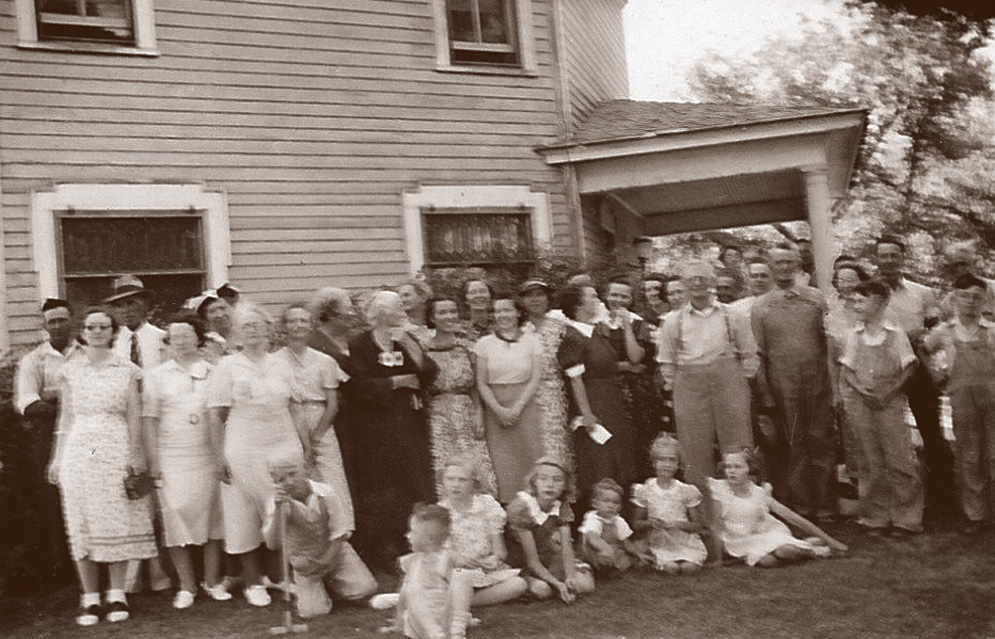 Per the recollections of Theta (Nutter) Potter: "I grew up on this farm. By the time I was born, the octagon house had gone through
several changes. The windows were changed. The closed porch was opened,as you see. The post by
my grandfather is a part of that porch. The windows are different but it is the same house.
Per the recollections of Theta (Nutter) Potter: "I grew up on this farm. By the time I was born, the octagon house had gone through
several changes. The windows were changed. The closed porch was opened,as you see. The post by
my grandfather is a part of that porch. The windows are different but it is the same house.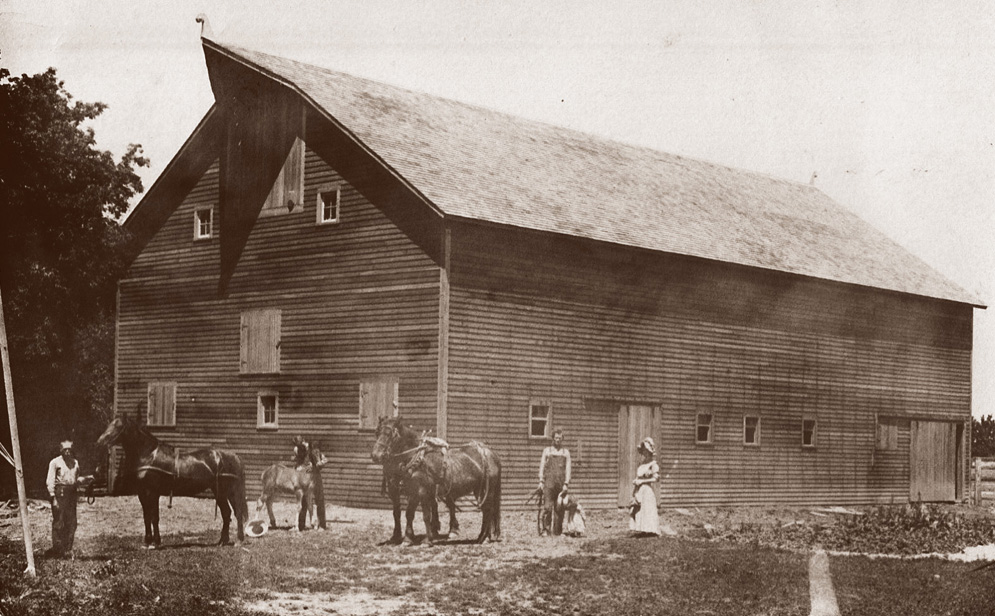 Per the recollections of Theta (Nutter) Potter: "The barn is on the home place, William and Dinah's farm.
My grandfather (Mirabeau) inherited it and then my father (Donovan). Mirabeau Nutter is the man in bib
overalls, and that is probably Lizzie Hogg Nutter with daughter Pauline. I can't recognize the other men.
Per the recollections of Theta (Nutter) Potter: "The barn is on the home place, William and Dinah's farm.
My grandfather (Mirabeau) inherited it and then my father (Donovan). Mirabeau Nutter is the man in bib
overalls, and that is probably Lizzie Hogg Nutter with daughter Pauline. I can't recognize the other men.
 Taken in Denver, Colorado, likely in February, 1907, around the time of Olive Nutter's marriage to
Charles Holmes. Reuben Miller and Louise (Nutter) Miller flank the "passengers" in the car. Their
children, Gerald and Ruby are at the front. Olive (Nutter) Holmes, John Nutter's eldest daughter,
is in the next row with her grandmother, Dinah. Charles Holmes is at the back-center.
Taken in Denver, Colorado, likely in February, 1907, around the time of Olive Nutter's marriage to
Charles Holmes. Reuben Miller and Louise (Nutter) Miller flank the "passengers" in the car. Their
children, Gerald and Ruby are at the front. Olive (Nutter) Holmes, John Nutter's eldest daughter,
is in the next row with her grandmother, Dinah. Charles Holmes is at the back-center.
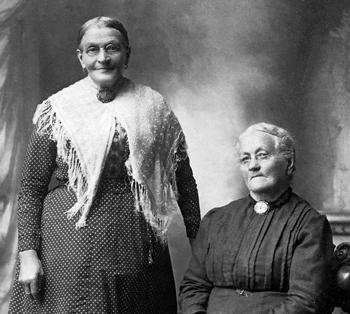 The two Ingham sisters reunited in Rhode Island and Connecticut after a 46 year separation. MaryAnn
Ingham Tattersall Bottomley (age 73) is standing. Dinah Ingham Nutter (age 78) is seated.
The two Ingham sisters reunited in Rhode Island and Connecticut after a 46 year separation. MaryAnn
Ingham Tattersall Bottomley (age 73) is standing. Dinah Ingham Nutter (age 78) is seated.
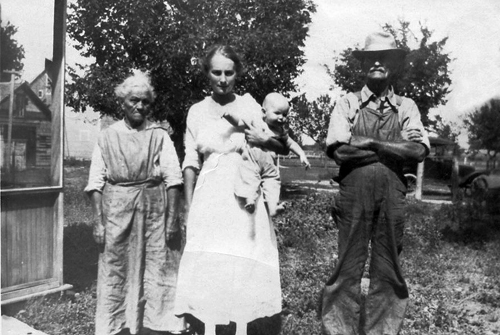 Probably the last photo taken of Dinah Nutter, taken in the Summer of 1918. This four generation
grouping shows (left to right); Dinah Nutter; granddaughter Inez Nutter Reynolds holding her
daughter, Janice; at right is John Nutter, Dinah's son and Inez's father.
Probably the last photo taken of Dinah Nutter, taken in the Summer of 1918. This four generation
grouping shows (left to right); Dinah Nutter; granddaughter Inez Nutter Reynolds holding her
daughter, Janice; at right is John Nutter, Dinah's son and Inez's father.
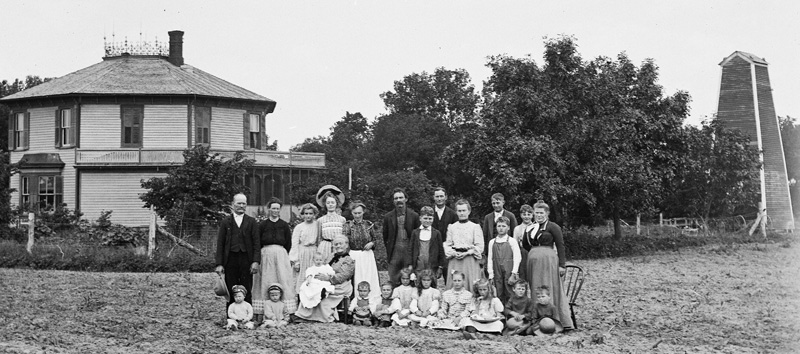
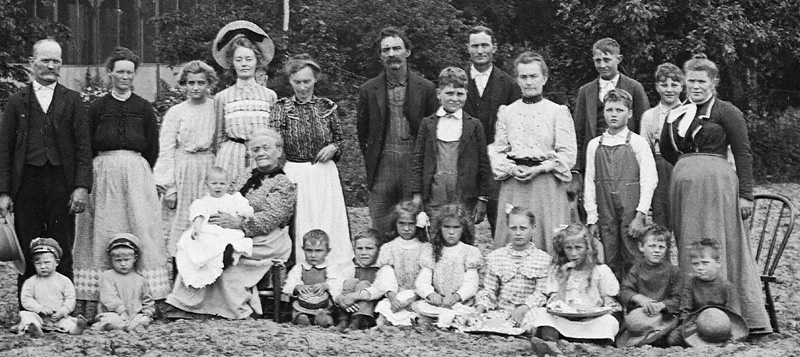
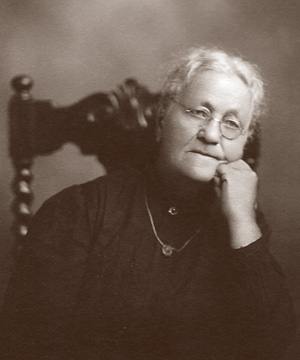 Dinah (Ingham) Nutter
Dinah (Ingham) Nutter





















































































































 James and Jane (Nutter) Whynall
James and Jane (Nutter) Whynall
 Samuel and Nancy Alice (Nutter) Stanworth
Samuel and Nancy Alice (Nutter) Stanworth

 Grace Ingham (left) and Dinah Ingham Barrowclough - Grace's daughter (right)
Grace Ingham (left) and Dinah Ingham Barrowclough - Grace's daughter (right)
 Margaret (Ingham) Simpson - circa 1919
Margaret (Ingham) Simpson - circa 1919

 MaryAnn Ingham Tattersall Bottomley - circa 1880 (left) and 1910 (right)
MaryAnn Ingham Tattersall Bottomley - circa 1880 (left) and 1910 (right)
